
National Grid 2020/21 Full Year Results Statement 1 Building a platform to lead the energy transition London | 20 May 2021: National Grid, a leading energy transmission and distribution company, today announces its Full Year results for the period ending 31 March 2021. John Pettigrew, Chief Executive, said: “In the past year we have successfully navigated the challenges of COVID-19, delivered over £5 billion of capital investment and achieved a solid underlying financial performance. This is testament to the strength and resilience of our business model and the unwavering commitment of our employees. We also announced the transformational acquisition of WPD which will ensure National Grid is at the heart of the energy transition in the UK and enhance the future growth profile of the Group. National Grid has an exciting future, with numerous opportunities in the UK and US to provide energy security and support the delivery of net zero. Our critical role in the energy sector, alongside our position as a principal partner at COP26, provides us with a unique opportunity to call for more ambitious action towards a clean energy future and a strong platform from which to generate value for all our stakeholders. Our confidence in the Group’s prospects is reflected in the ambitious five-year outlook for capital investment, asset growth and earnings, which we are announcing today.” Financial Summary Year ended 31 March – continuing operations Statutory results Underlying1 2021 2020 % change 2021 2020 % change Operating profit (£m) 2,895 2,780 4 % 3,283 3,454 (5) % Profit before tax (£m) 2,083 1,754 19 % 2,407 2,493 (3) % Earnings per share (p) 46.6 36.8 27 % 54.2 58.2 (7) % Dividend per share (p) 49.16 48.57 1 % 49.16 48.57 1 % Capital investment (£m) 5,047 5,405 (7) % 5,047 5,405 (7) % 3,523 million weighted average shares for 2020/21 (2019/20: 3,461 million). Highlights ■ Transactions progressing, WPD acquisition approved by shareholders – we expect WPD completion by July. ■ Regulatory milestones reached with the RIIO-2 Final Determination and Joint Proposal for KEDNY-KEDLI. ■ COP26 principal partner and new Scope 3 targets set for the Group. ■ Statutory operating profit up 4% to £2.9 billion principally driven by environmental exceptional charges made in the prior year, partly offset by increased under-recoveries and higher storm costs. ■ Solid financial performance with underlying operating profit down 5% to £3.3 billion primarily driven by the impact of COVID-19. ■ £5.0 billion of capex across the Group, including continued investment in UK and US critical infrastructure and the commissioning of IFA2 between the UK and France. ■ Recommended final dividend to bring full year dividend to 49.16p, up 1.2%, in line with policy. Financial Outlook and Guidance ■ Financial outlook over the 5 year period 2020/21 to 2025/26: 1 ‘Underlying’ represents statutory results from continuing operations, but excluding exceptional items, remeasurements, major storm costs (when greater than $100m) and timing. These and a number of other terms and performance measures used in this document are not defined within accounting standards and may be applied differently by other organisations. We have provided definitions of these terms on page 69 and 70 and reconciliations of these measures on pages 69 to 80. These measures are not a substitute for IFRS measures, however the Group believes such information is useful in assessing the performance of the business on a comparable basis. Exhibit 99.1
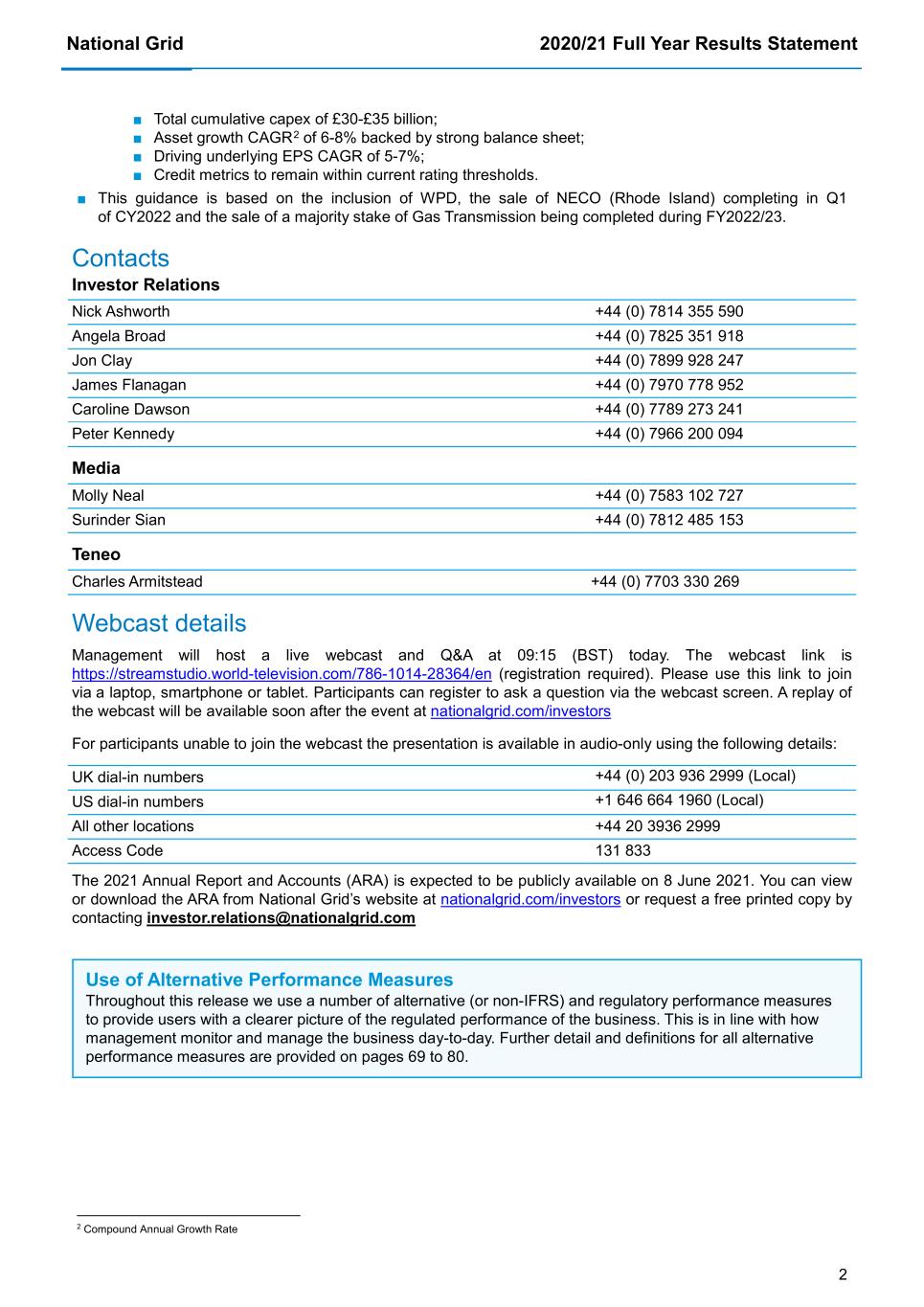
National Grid 2020/21 Full Year Results Statement 2 ■ Total cumulative capex of £30-£35 billion; ■ Asset growth CAGR2 of 6-8% backed by strong balance sheet; ■ Driving underlying EPS CAGR of 5-7%; ■ Credit metrics to remain within current rating thresholds. ■ This guidance is based on the inclusion of WPD, the sale of NECO (Rhode Island) completing in Q1 of CY2022 and the sale of a majority stake of Gas Transmission being completed during FY2022/23. Contacts Investor Relations Nick Ashworth +44 (0) 7814 355 590 Angela Broad +44 (0) 7825 351 918 Jon Clay +44 (0) 7899 928 247 James Flanagan +44 (0) 7970 778 952 Caroline Dawson +44 (0) 7789 273 241 Peter Kennedy +44 (0) 7966 200 094 Media Molly Neal +44 (0) 7583 102 727 Surinder Sian +44 (0) 7812 485 153 Teneo Charles Armitstead +44 (0) 7703 330 269 Webcast details Management will host a live webcast and Q&A at 09:15 (BST) today. The webcast link is https://streamstudio.world-television.com/786-1014-28364/en (registration required). Please use this link to join via a laptop, smartphone or tablet. Participants can register to ask a question via the webcast screen. A replay of the webcast will be available soon after the event at nationalgrid.com/investors For participants unable to join the webcast the presentation is available in audio-only using the following details: UK dial-in numbers +44 (0) 203 936 2999 (Local) US dial-in numbers +1 646 664 1960 (Local) All other locations +44 20 3936 2999 Access Code 131 833 The 2021 Annual Report and Accounts (ARA) is expected to be publicly available on 8 June 2021. You can view or download the ARA from National Grid’s website at nationalgrid.com/investors or request a free printed copy by contacting investor.relations@nationalgrid.com Use of Alternative Performance Measures Throughout this release we use a number of alternative (or non-IFRS) and regulatory performance measures to provide users with a clearer picture of the regulated performance of the business. This is in line with how management monitor and manage the business day-to-day. Further detail and definitions for all alternative performance measures are provided on pages 69 to 80. 2 Compound Annual Growth Rate
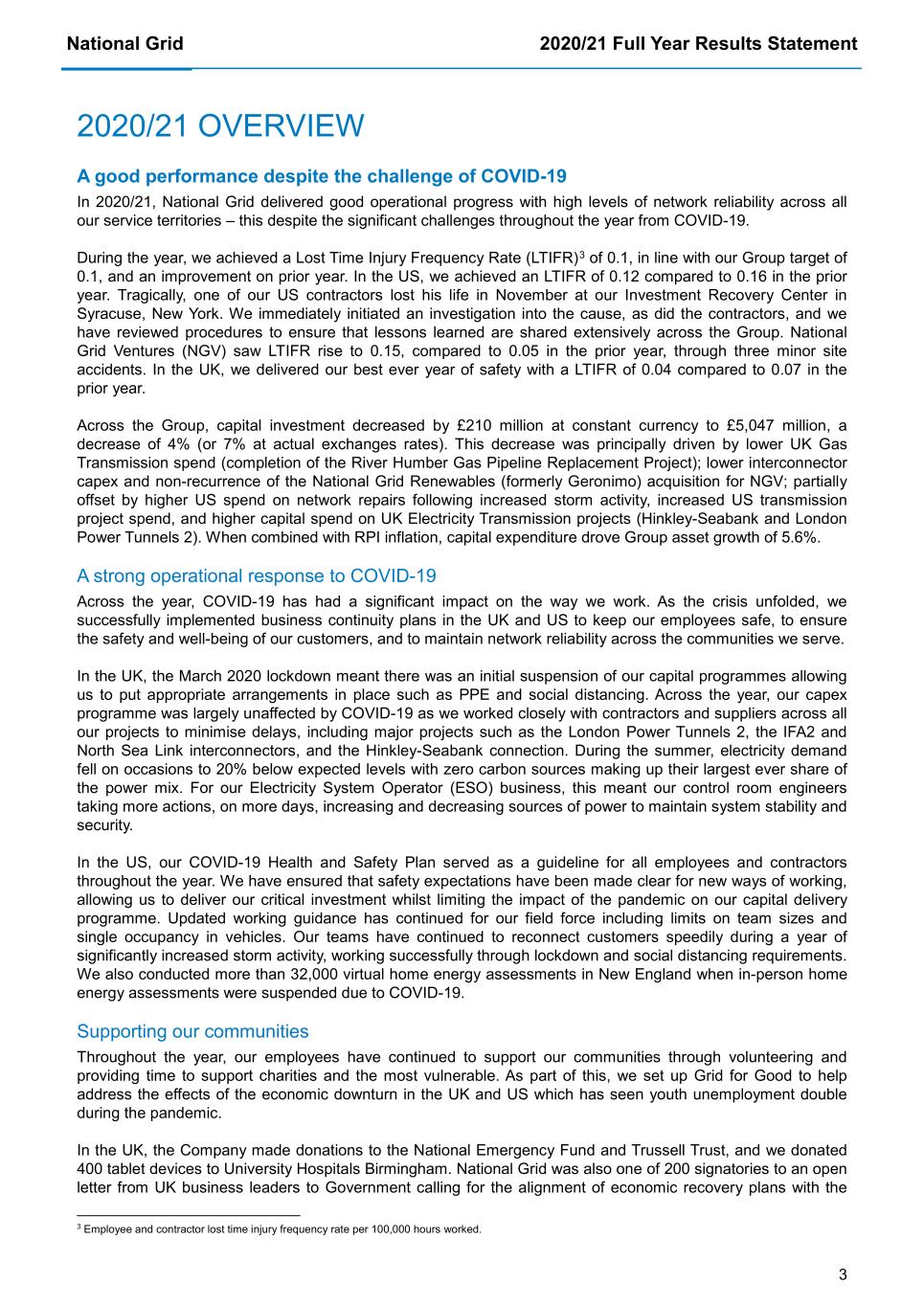
National Grid 2020/21 Full Year Results Statement 3 2020/21 OVERVIEW A good performance despite the challenge of COVID-19 In 2020/21, National Grid delivered good operational progress with high levels of network reliability across all our service territories – this despite the significant challenges throughout the year from COVID-19. During the year, we achieved a Lost Time Injury Frequency Rate (LTIFR)3 of 0.1, in line with our Group target of 0.1, and an improvement on prior year. In the US, we achieved an LTIFR of 0.12 compared to 0.16 in the prior year. Tragically, one of our US contractors lost his life in November at our Investment Recovery Center in Syracuse, New York. We immediately initiated an investigation into the cause, as did the contractors, and we have reviewed procedures to ensure that lessons learned are shared extensively across the Group. National Grid Ventures (NGV) saw LTIFR rise to 0.15, compared to 0.05 in the prior year, through three minor site accidents. In the UK, we delivered our best ever year of safety with a LTIFR of 0.04 compared to 0.07 in the prior year. Across the Group, capital investment decreased by £210 million at constant currency to £5,047 million, a decrease of 4% (or 7% at actual exchanges rates). This decrease was principally driven by lower UK Gas Transmission spend (completion of the River Humber Gas Pipeline Replacement Project); lower interconnector capex and non-recurrence of the National Grid Renewables (formerly Geronimo) acquisition for NGV; partially offset by higher US spend on network repairs following increased storm activity, increased US transmission project spend, and higher capital spend on UK Electricity Transmission projects (Hinkley-Seabank and London Power Tunnels 2). When combined with RPI inflation, capital expenditure drove Group asset growth of 5.6%. A strong operational response to COVID-19 Across the year, COVID-19 has had a significant impact on the way we work. As the crisis unfolded, we successfully implemented business continuity plans in the UK and US to keep our employees safe, to ensure the safety and well-being of our customers, and to maintain network reliability across the communities we serve. In the UK, the March 2020 lockdown meant there was an initial suspension of our capital programmes allowing us to put appropriate arrangements in place such as PPE and social distancing. Across the year, our capex programme was largely unaffected by COVID-19 as we worked closely with contractors and suppliers across all our projects to minimise delays, including major projects such as the London Power Tunnels 2, the IFA2 and North Sea Link interconnectors, and the Hinkley-Seabank connection. During the summer, electricity demand fell on occasions to 20% below expected levels with zero carbon sources making up their largest ever share of the power mix. For our Electricity System Operator (ESO) business, this meant our control room engineers taking more actions, on more days, increasing and decreasing sources of power to maintain system stability and security. In the US, our COVID-19 Health and Safety Plan served as a guideline for all employees and contractors throughout the year. We have ensured that safety expectations have been made clear for new ways of working, allowing us to deliver our critical investment whilst limiting the impact of the pandemic on our capital delivery programme. Updated working guidance has continued for our field force including limits on team sizes and single occupancy in vehicles. Our teams have continued to reconnect customers speedily during a year of significantly increased storm activity, working successfully through lockdown and social distancing requirements. We also conducted more than 32,000 virtual home energy assessments in New England when in-person home energy assessments were suspended due to COVID-19. Supporting our communities Throughout the year, our employees have continued to support our communities through volunteering and providing time to support charities and the most vulnerable. As part of this, we set up Grid for Good to help address the effects of the economic downturn in the UK and US which has seen youth unemployment double during the pandemic. In the UK, the Company made donations to the National Emergency Fund and Trussell Trust, and we donated 400 tablet devices to University Hospitals Birmingham. National Grid was also one of 200 signatories to an open letter from UK business leaders to Government calling for the alignment of economic recovery plans with the 3 Employee and contractor lost time injury frequency rate per 100,000 hours worked.
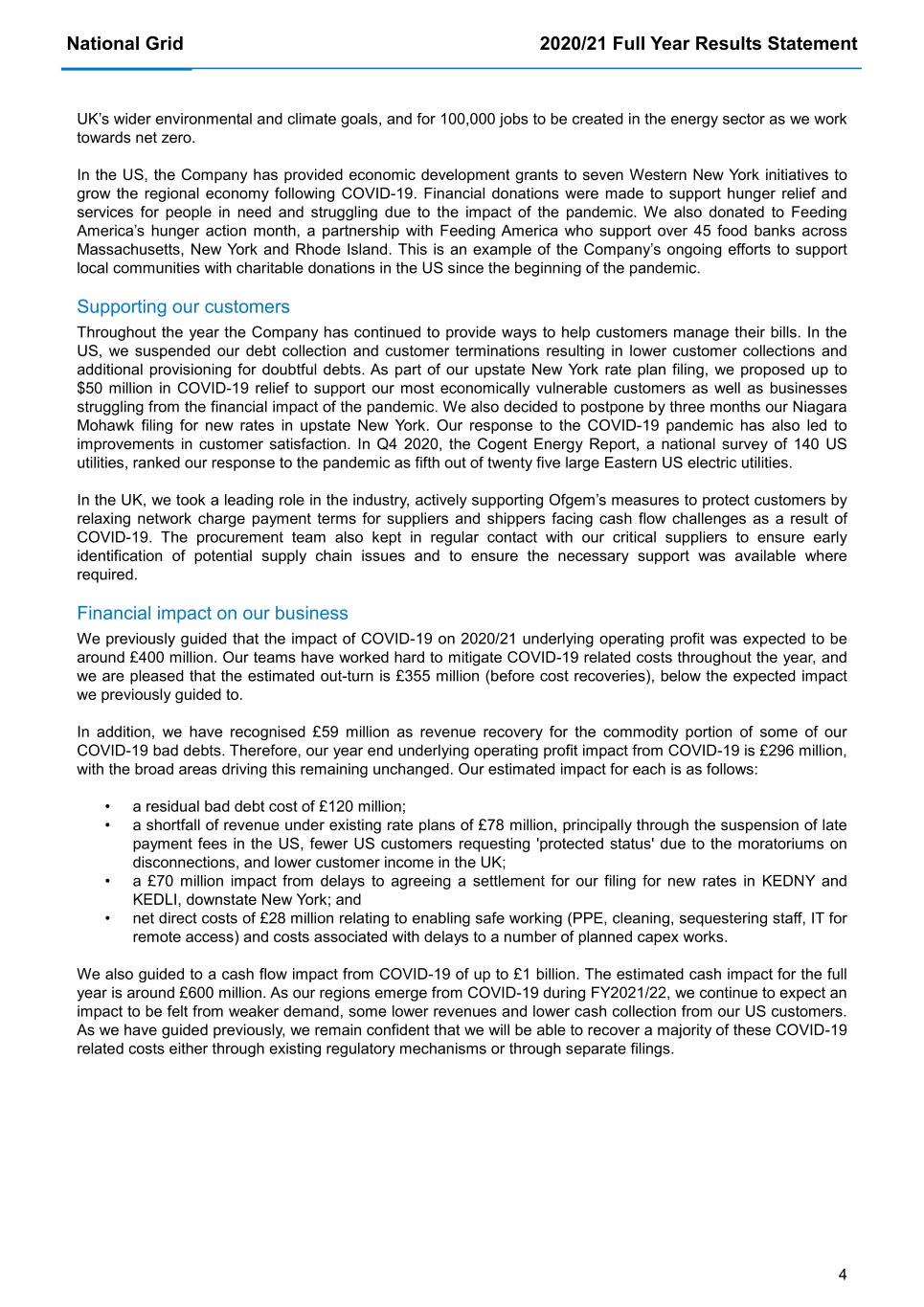
National Grid 2020/21 Full Year Results Statement 4 UK’s wider environmental and climate goals, and for 100,000 jobs to be created in the energy sector as we work towards net zero. In the US, the Company has provided economic development grants to seven Western New York initiatives to grow the regional economy following COVID-19. Financial donations were made to support hunger relief and services for people in need and struggling due to the impact of the pandemic. We also donated to Feeding America’s hunger action month, a partnership with Feeding America who support over 45 food banks across Massachusetts, New York and Rhode Island. This is an example of the Company’s ongoing efforts to support local communities with charitable donations in the US since the beginning of the pandemic. Supporting our customers Throughout the year the Company has continued to provide ways to help customers manage their bills. In the US, we suspended our debt collection and customer terminations resulting in lower customer collections and additional provisioning for doubtful debts. As part of our upstate New York rate plan filing, we proposed up to $50 million in COVID-19 relief to support our most economically vulnerable customers as well as businesses struggling from the financial impact of the pandemic. We also decided to postpone by three months our Niagara Mohawk filing for new rates in upstate New York. Our response to the COVID-19 pandemic has also led to improvements in customer satisfaction. In Q4 2020, the Cogent Energy Report, a national survey of 140 US utilities, ranked our response to the pandemic as fifth out of twenty five large Eastern US electric utilities. In the UK, we took a leading role in the industry, actively supporting Ofgem’s measures to protect customers by relaxing network charge payment terms for suppliers and shippers facing cash flow challenges as a result of COVID-19. The procurement team also kept in regular contact with our critical suppliers to ensure early identification of potential supply chain issues and to ensure the necessary support was available where required. Financial impact on our business We previously guided that the impact of COVID-19 on 2020/21 underlying operating profit was expected to be around £400 million. Our teams have worked hard to mitigate COVID-19 related costs throughout the year, and we are pleased that the estimated out-turn is £355 million (before cost recoveries), below the expected impact we previously guided to. In addition, we have recognised £59 million as revenue recovery for the commodity portion of some of our COVID-19 bad debts. Therefore, our year end underlying operating profit impact from COVID-19 is £296 million, with the broad areas driving this remaining unchanged. Our estimated impact for each is as follows: • a residual bad debt cost of £120 million; • a shortfall of revenue under existing rate plans of £78 million, principally through the suspension of late payment fees in the US, fewer US customers requesting 'protected status' due to the moratoriums on disconnections, and lower customer income in the UK; • a £70 million impact from delays to agreeing a settlement for our filing for new rates in KEDNY and KEDLI, downstate New York; and • net direct costs of £28 million relating to enabling safe working (PPE, cleaning, sequestering staff, IT for remote access) and costs associated with delays to a number of planned capex works. We also guided to a cash flow impact from COVID-19 of up to £1 billion. The estimated cash impact for the full year is around £600 million. As our regions emerge from COVID-19 during FY2021/22, we continue to expect an impact to be felt from weaker demand, some lower revenues and lower cash collection from our US customers. As we have guided previously, we remain confident that we will be able to recover a majority of these COVID-19 related costs either through existing regulatory mechanisms or through separate filings.
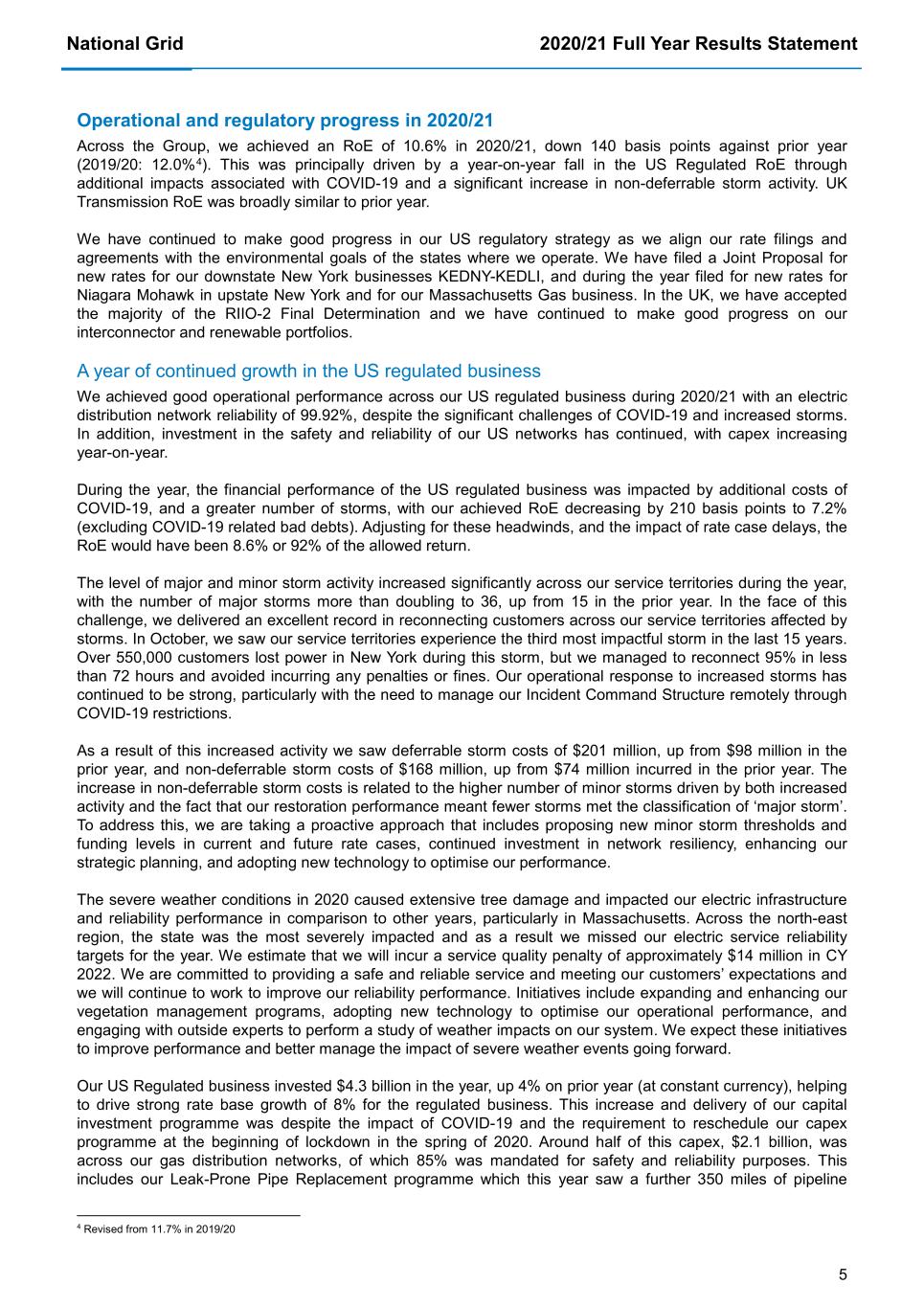
National Grid 2020/21 Full Year Results Statement 5 Operational and regulatory progress in 2020/21 Across the Group, we achieved an RoE of 10.6% in 2020/21, down 140 basis points against prior year (2019/20: 12.0%4). This was principally driven by a year-on-year fall in the US Regulated RoE through additional impacts associated with COVID-19 and a significant increase in non-deferrable storm activity. UK Transmission RoE was broadly similar to prior year. We have continued to make good progress in our US regulatory strategy as we align our rate filings and agreements with the environmental goals of the states where we operate. We have filed a Joint Proposal for new rates for our downstate New York businesses KEDNY-KEDLI, and during the year filed for new rates for Niagara Mohawk in upstate New York and for our Massachusetts Gas business. In the UK, we have accepted the majority of the RIIO-2 Final Determination and we have continued to make good progress on our interconnector and renewable portfolios. A year of continued growth in the US regulated business We achieved good operational performance across our US regulated business during 2020/21 with an electric distribution network reliability of 99.92%, despite the significant challenges of COVID-19 and increased storms. In addition, investment in the safety and reliability of our US networks has continued, with capex increasing year-on-year. During the year, the financial performance of the US regulated business was impacted by additional costs of COVID-19, and a greater number of storms, with our achieved RoE decreasing by 210 basis points to 7.2% (excluding COVID-19 related bad debts). Adjusting for these headwinds, and the impact of rate case delays, the RoE would have been 8.6% or 92% of the allowed return. The level of major and minor storm activity increased significantly across our service territories during the year, with the number of major storms more than doubling to 36, up from 15 in the prior year. In the face of this challenge, we delivered an excellent record in reconnecting customers across our service territories affected by storms. In October, we saw our service territories experience the third most impactful storm in the last 15 years. Over 550,000 customers lost power in New York during this storm, but we managed to reconnect 95% in less than 72 hours and avoided incurring any penalties or fines. Our operational response to increased storms has continued to be strong, particularly with the need to manage our Incident Command Structure remotely through COVID-19 restrictions. As a result of this increased activity we saw deferrable storm costs of $201 million, up from $98 million in the prior year, and non-deferrable storm costs of $168 million, up from $74 million incurred in the prior year. The increase in non-deferrable storm costs is related to the higher number of minor storms driven by both increased activity and the fact that our restoration performance meant fewer storms met the classification of ‘major storm’. To address this, we are taking a proactive approach that includes proposing new minor storm thresholds and funding levels in current and future rate cases, continued investment in network resiliency, enhancing our strategic planning, and adopting new technology to optimise our performance. The severe weather conditions in 2020 caused extensive tree damage and impacted our electric infrastructure and reliability performance in comparison to other years, particularly in Massachusetts. Across the north-east region, the state was the most severely impacted and as a result we missed our electric service reliability targets for the year. We estimate that we will incur a service quality penalty of approximately $14 million in CY 2022. We are committed to providing a safe and reliable service and meeting our customers’ expectations and we will continue to work to improve our reliability performance. Initiatives include expanding and enhancing our vegetation management programs, adopting new technology to optimise our operational performance, and engaging with outside experts to perform a study of weather impacts on our system. We expect these initiatives to improve performance and better manage the impact of severe weather events going forward. Our US Regulated business invested $4.3 billion in the year, up 4% on prior year (at constant currency), helping to drive strong rate base growth of 8% for the regulated business. This increase and delivery of our capital investment programme was despite the impact of COVID-19 and the requirement to reschedule our capex programme at the beginning of lockdown in the spring of 2020. Around half of this capex, $2.1 billion, was across our gas distribution networks, of which 85% was mandated for safety and reliability purposes. This includes our Leak-Prone Pipe Replacement programme which this year saw a further 350 miles of pipeline 4 Revised from 11.7% in 2019/20
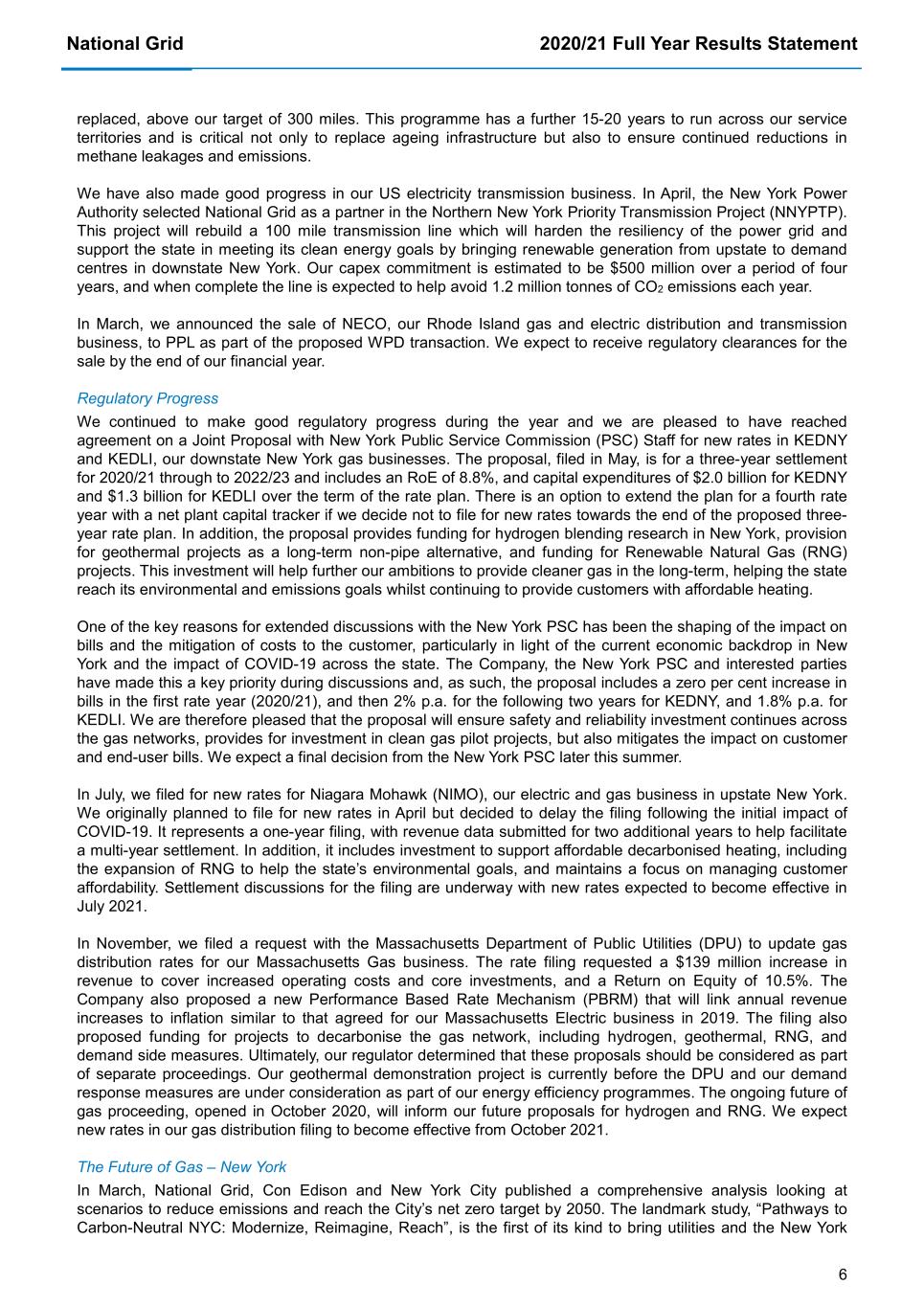
National Grid 2020/21 Full Year Results Statement 6 replaced, above our target of 300 miles. This programme has a further 15-20 years to run across our service territories and is critical not only to replace ageing infrastructure but also to ensure continued reductions in methane leakages and emissions. We have also made good progress in our US electricity transmission business. In April, the New York Power Authority selected National Grid as a partner in the Northern New York Priority Transmission Project (NNYPTP). This project will rebuild a 100 mile transmission line which will harden the resiliency of the power grid and support the state in meeting its clean energy goals by bringing renewable generation from upstate to demand centres in downstate New York. Our capex commitment is estimated to be $500 million over a period of four years, and when complete the line is expected to help avoid 1.2 million tonnes of CO2 emissions each year. In March, we announced the sale of NECO, our Rhode Island gas and electric distribution and transmission business, to PPL as part of the proposed WPD transaction. We expect to receive regulatory clearances for the sale by the end of our financial year. Regulatory Progress We continued to make good regulatory progress during the year and we are pleased to have reached agreement on a Joint Proposal with New York Public Service Commission (PSC) Staff for new rates in KEDNY and KEDLI, our downstate New York gas businesses. The proposal, filed in May, is for a three-year settlement for 2020/21 through to 2022/23 and includes an RoE of 8.8%, and capital expenditures of $2.0 billion for KEDNY and $1.3 billion for KEDLI over the term of the rate plan. There is an option to extend the plan for a fourth rate year with a net plant capital tracker if we decide not to file for new rates towards the end of the proposed three- year rate plan. In addition, the proposal provides funding for hydrogen blending research in New York, provision for geothermal projects as a long-term non-pipe alternative, and funding for Renewable Natural Gas (RNG) projects. This investment will help further our ambitions to provide cleaner gas in the long-term, helping the state reach its environmental and emissions goals whilst continuing to provide customers with affordable heating. One of the key reasons for extended discussions with the New York PSC has been the shaping of the impact on bills and the mitigation of costs to the customer, particularly in light of the current economic backdrop in New York and the impact of COVID-19 across the state. The Company, the New York PSC and interested parties have made this a key priority during discussions and, as such, the proposal includes a zero per cent increase in bills in the first rate year (2020/21), and then 2% p.a. for the following two years for KEDNY, and 1.8% p.a. for KEDLI. We are therefore pleased that the proposal will ensure safety and reliability investment continues across the gas networks, provides for investment in clean gas pilot projects, but also mitigates the impact on customer and end-user bills. We expect a final decision from the New York PSC later this summer. In July, we filed for new rates for Niagara Mohawk (NIMO), our electric and gas business in upstate New York. We originally planned to file for new rates in April but decided to delay the filing following the initial impact of COVID-19. It represents a one-year filing, with revenue data submitted for two additional years to help facilitate a multi-year settlement. In addition, it includes investment to support affordable decarbonised heating, including the expansion of RNG to help the state’s environmental goals, and maintains a focus on managing customer affordability. Settlement discussions for the filing are underway with new rates expected to become effective in July 2021. In November, we filed a request with the Massachusetts Department of Public Utilities (DPU) to update gas distribution rates for our Massachusetts Gas business. The rate filing requested a $139 million increase in revenue to cover increased operating costs and core investments, and a Return on Equity of 10.5%. The Company also proposed a new Performance Based Rate Mechanism (PBRM) that will link annual revenue increases to inflation similar to that agreed for our Massachusetts Electric business in 2019. The filing also proposed funding for projects to decarbonise the gas network, including hydrogen, geothermal, RNG, and demand side measures. Ultimately, our regulator determined that these proposals should be considered as part of separate proceedings. Our geothermal demonstration project is currently before the DPU and our demand response measures are under consideration as part of our energy efficiency programmes. The ongoing future of gas proceeding, opened in October 2020, will inform our future proposals for hydrogen and RNG. We expect new rates in our gas distribution filing to become effective from October 2021. The Future of Gas – New York In March, National Grid, Con Edison and New York City published a comprehensive analysis looking at scenarios to reduce emissions and reach the City’s net zero target by 2050. The landmark study, “Pathways to Carbon-Neutral NYC: Modernize, Reimagine, Reach”, is the first of its kind to bring utilities and the New York
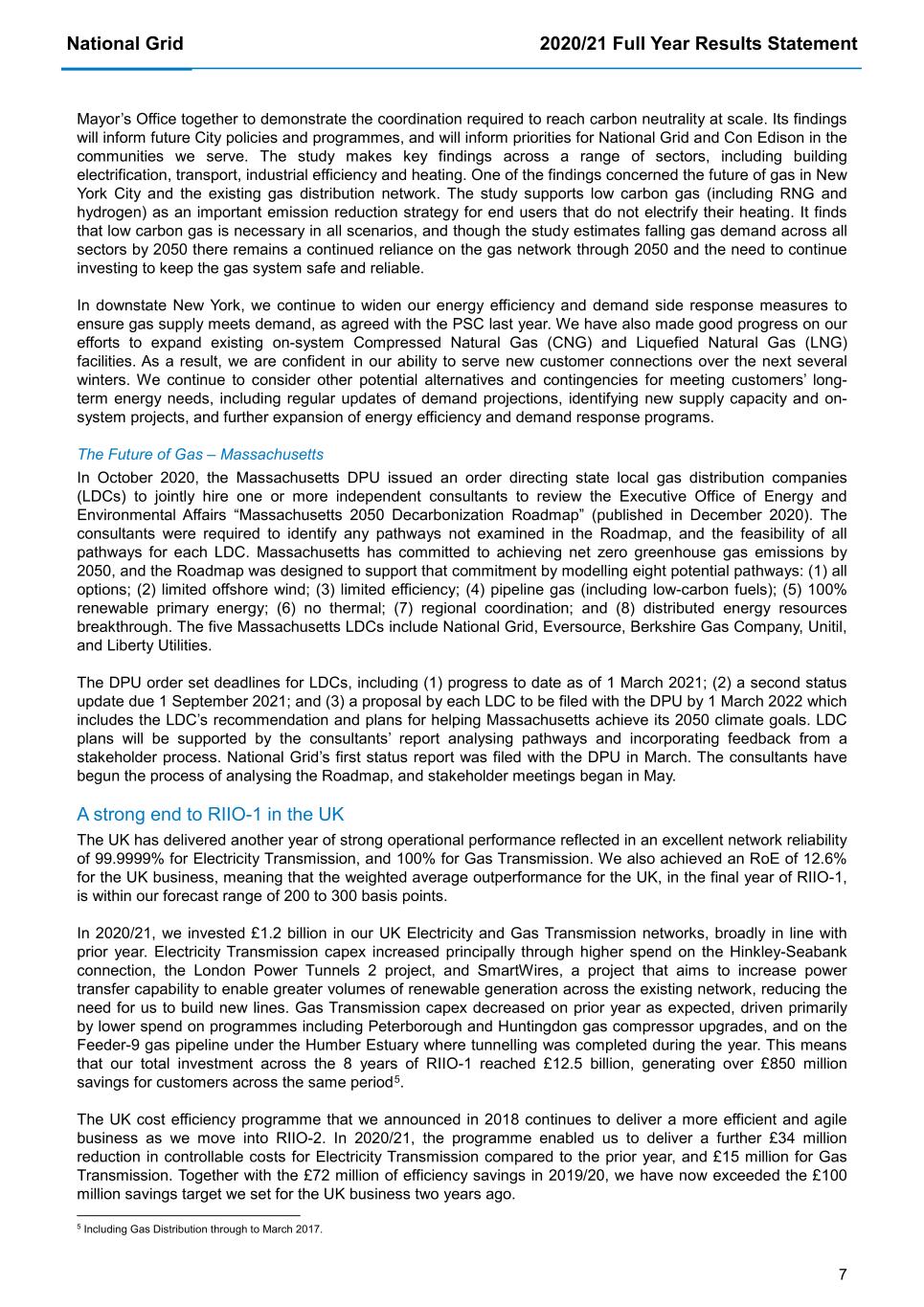
National Grid 2020/21 Full Year Results Statement 7 Mayor’s Office together to demonstrate the coordination required to reach carbon neutrality at scale. Its findings will inform future City policies and programmes, and will inform priorities for National Grid and Con Edison in the communities we serve. The study makes key findings across a range of sectors, including building electrification, transport, industrial efficiency and heating. One of the findings concerned the future of gas in New York City and the existing gas distribution network. The study supports low carbon gas (including RNG and hydrogen) as an important emission reduction strategy for end users that do not electrify their heating. It finds that low carbon gas is necessary in all scenarios, and though the study estimates falling gas demand across all sectors by 2050 there remains a continued reliance on the gas network through 2050 and the need to continue investing to keep the gas system safe and reliable. In downstate New York, we continue to widen our energy efficiency and demand side response measures to ensure gas supply meets demand, as agreed with the PSC last year. We have also made good progress on our efforts to expand existing on-system Compressed Natural Gas (CNG) and Liquefied Natural Gas (LNG) facilities. As a result, we are confident in our ability to serve new customer connections over the next several winters. We continue to consider other potential alternatives and contingencies for meeting customers’ long- term energy needs, including regular updates of demand projections, identifying new supply capacity and on- system projects, and further expansion of energy efficiency and demand response programs. The Future of Gas – Massachusetts In October 2020, the Massachusetts DPU issued an order directing state local gas distribution companies (LDCs) to jointly hire one or more independent consultants to review the Executive Office of Energy and Environmental Affairs “Massachusetts 2050 Decarbonization Roadmap” (published in December 2020). The consultants were required to identify any pathways not examined in the Roadmap, and the feasibility of all pathways for each LDC. Massachusetts has committed to achieving net zero greenhouse gas emissions by 2050, and the Roadmap was designed to support that commitment by modelling eight potential pathways: (1) all options; (2) limited offshore wind; (3) limited efficiency; (4) pipeline gas (including low-carbon fuels); (5) 100% renewable primary energy; (6) no thermal; (7) regional coordination; and (8) distributed energy resources breakthrough. The five Massachusetts LDCs include National Grid, Eversource, Berkshire Gas Company, Unitil, and Liberty Utilities. The DPU order set deadlines for LDCs, including (1) progress to date as of 1 March 2021; (2) a second status update due 1 September 2021; and (3) a proposal by each LDC to be filed with the DPU by 1 March 2022 which includes the LDC’s recommendation and plans for helping Massachusetts achieve its 2050 climate goals. LDC plans will be supported by the consultants’ report analysing pathways and incorporating feedback from a stakeholder process. National Grid’s first status report was filed with the DPU in March. The consultants have begun the process of analysing the Roadmap, and stakeholder meetings began in May. A strong end to RIIO-1 in the UK The UK has delivered another year of strong operational performance reflected in an excellent network reliability of 99.9999% for Electricity Transmission, and 100% for Gas Transmission. We also achieved an RoE of 12.6% for the UK business, meaning that the weighted average outperformance for the UK, in the final year of RIIO-1, is within our forecast range of 200 to 300 basis points. In 2020/21, we invested £1.2 billion in our UK Electricity and Gas Transmission networks, broadly in line with prior year. Electricity Transmission capex increased principally through higher spend on the Hinkley-Seabank connection, the London Power Tunnels 2 project, and SmartWires, a project that aims to increase power transfer capability to enable greater volumes of renewable generation across the existing network, reducing the need for us to build new lines. Gas Transmission capex decreased on prior year as expected, driven primarily by lower spend on programmes including Peterborough and Huntingdon gas compressor upgrades, and on the Feeder-9 gas pipeline under the Humber Estuary where tunnelling was completed during the year. This means that our total investment across the 8 years of RIIO-1 reached £12.5 billion, generating over £850 million savings for customers across the same period5. The UK cost efficiency programme that we announced in 2018 continues to deliver a more efficient and agile business as we move into RIIO-2. In 2020/21, the programme enabled us to deliver a further £34 million reduction in controllable costs for Electricity Transmission compared to the prior year, and £15 million for Gas Transmission. Together with the £72 million of efficiency savings in 2019/20, we have now exceeded the £100 million savings target we set for the UK business two years ago. 5 Including Gas Distribution through to March 2017.
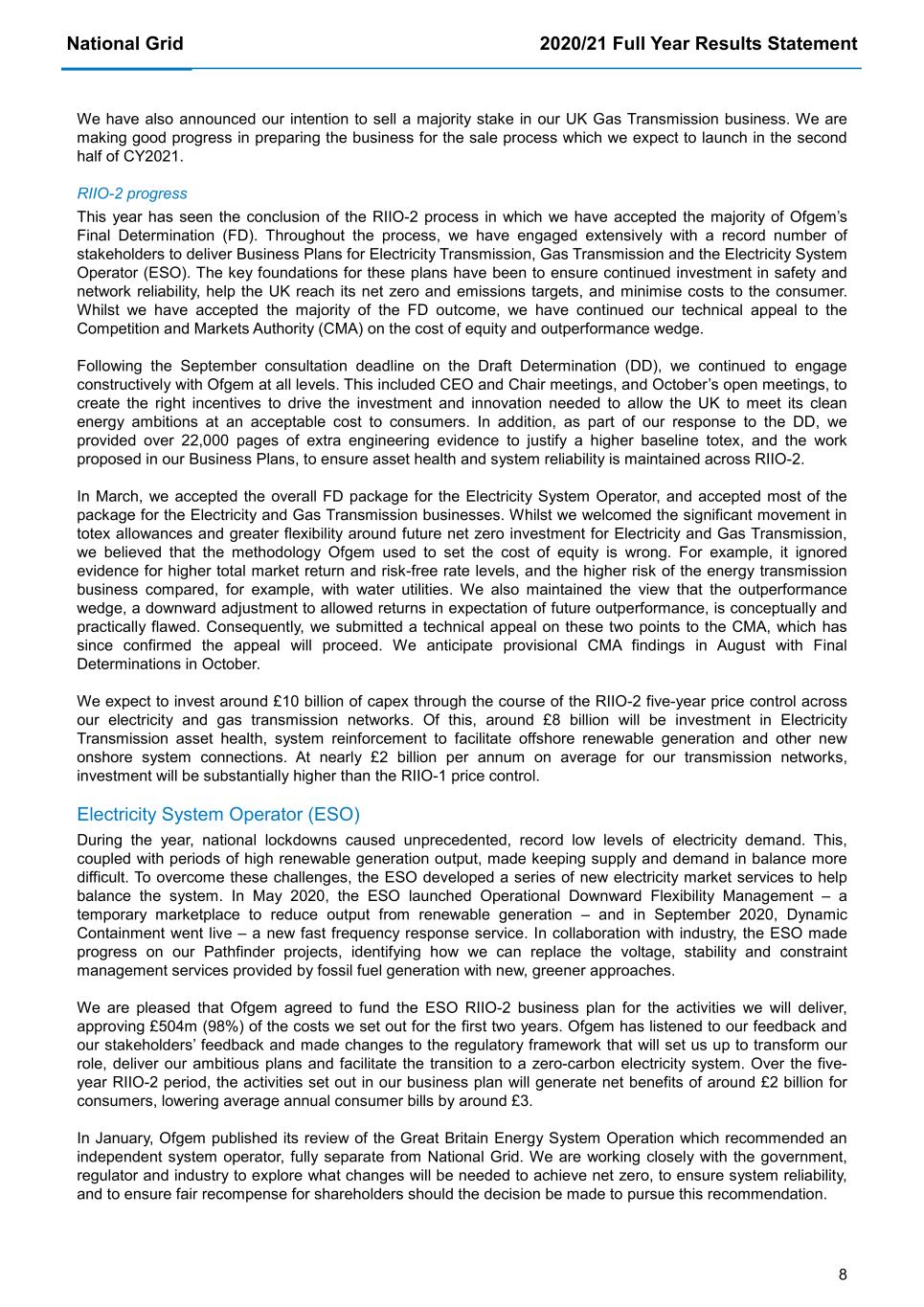
National Grid 2020/21 Full Year Results Statement 8 We have also announced our intention to sell a majority stake in our UK Gas Transmission business. We are making good progress in preparing the business for the sale process which we expect to launch in the second half of CY2021. RIIO-2 progress This year has seen the conclusion of the RIIO-2 process in which we have accepted the majority of Ofgem’s Final Determination (FD). Throughout the process, we have engaged extensively with a record number of stakeholders to deliver Business Plans for Electricity Transmission, Gas Transmission and the Electricity System Operator (ESO). The key foundations for these plans have been to ensure continued investment in safety and network reliability, help the UK reach its net zero and emissions targets, and minimise costs to the consumer. Whilst we have accepted the majority of the FD outcome, we have continued our technical appeal to the Competition and Markets Authority (CMA) on the cost of equity and outperformance wedge. Following the September consultation deadline on the Draft Determination (DD), we continued to engage constructively with Ofgem at all levels. This included CEO and Chair meetings, and October’s open meetings, to create the right incentives to drive the investment and innovation needed to allow the UK to meet its clean energy ambitions at an acceptable cost to consumers. In addition, as part of our response to the DD, we provided over 22,000 pages of extra engineering evidence to justify a higher baseline totex, and the work proposed in our Business Plans, to ensure asset health and system reliability is maintained across RIIO-2. In March, we accepted the overall FD package for the Electricity System Operator, and accepted most of the package for the Electricity and Gas Transmission businesses. Whilst we welcomed the significant movement in totex allowances and greater flexibility around future net zero investment for Electricity and Gas Transmission, we believed that the methodology Ofgem used to set the cost of equity is wrong. For example, it ignored evidence for higher total market return and risk-free rate levels, and the higher risk of the energy transmission business compared, for example, with water utilities. We also maintained the view that the outperformance wedge, a downward adjustment to allowed returns in expectation of future outperformance, is conceptually and practically flawed. Consequently, we submitted a technical appeal on these two points to the CMA, which has since confirmed the appeal will proceed. We anticipate provisional CMA findings in August with Final Determinations in October. We expect to invest around £10 billion of capex through the course of the RIIO-2 five-year price control across our electricity and gas transmission networks. Of this, around £8 billion will be investment in Electricity Transmission asset health, system reinforcement to facilitate offshore renewable generation and other new onshore system connections. At nearly £2 billion per annum on average for our transmission networks, investment will be substantially higher than the RIIO-1 price control. Electricity System Operator (ESO) During the year, national lockdowns caused unprecedented, record low levels of electricity demand. This, coupled with periods of high renewable generation output, made keeping supply and demand in balance more difficult. To overcome these challenges, the ESO developed a series of new electricity market services to help balance the system. In May 2020, the ESO launched Operational Downward Flexibility Management – a temporary marketplace to reduce output from renewable generation – and in September 2020, Dynamic Containment went live – a new fast frequency response service. In collaboration with industry, the ESO made progress on our Pathfinder projects, identifying how we can replace the voltage, stability and constraint management services provided by fossil fuel generation with new, greener approaches. We are pleased that Ofgem agreed to fund the ESO RIIO-2 business plan for the activities we will deliver, approving £504m (98%) of the costs we set out for the first two years. Ofgem has listened to our feedback and our stakeholders’ feedback and made changes to the regulatory framework that will set us up to transform our role, deliver our ambitious plans and facilitate the transition to a zero-carbon electricity system. Over the five- year RIIO-2 period, the activities set out in our business plan will generate net benefits of around £2 billion for consumers, lowering average annual consumer bills by around £3. In January, Ofgem published its review of the Great Britain Energy System Operation which recommended an independent system operator, fully separate from National Grid. We are working closely with the government, regulator and industry to explore what changes will be needed to achieve net zero, to ensure system reliability, and to ensure fair recompense for shareholders should the decision be made to pursue this recommendation.
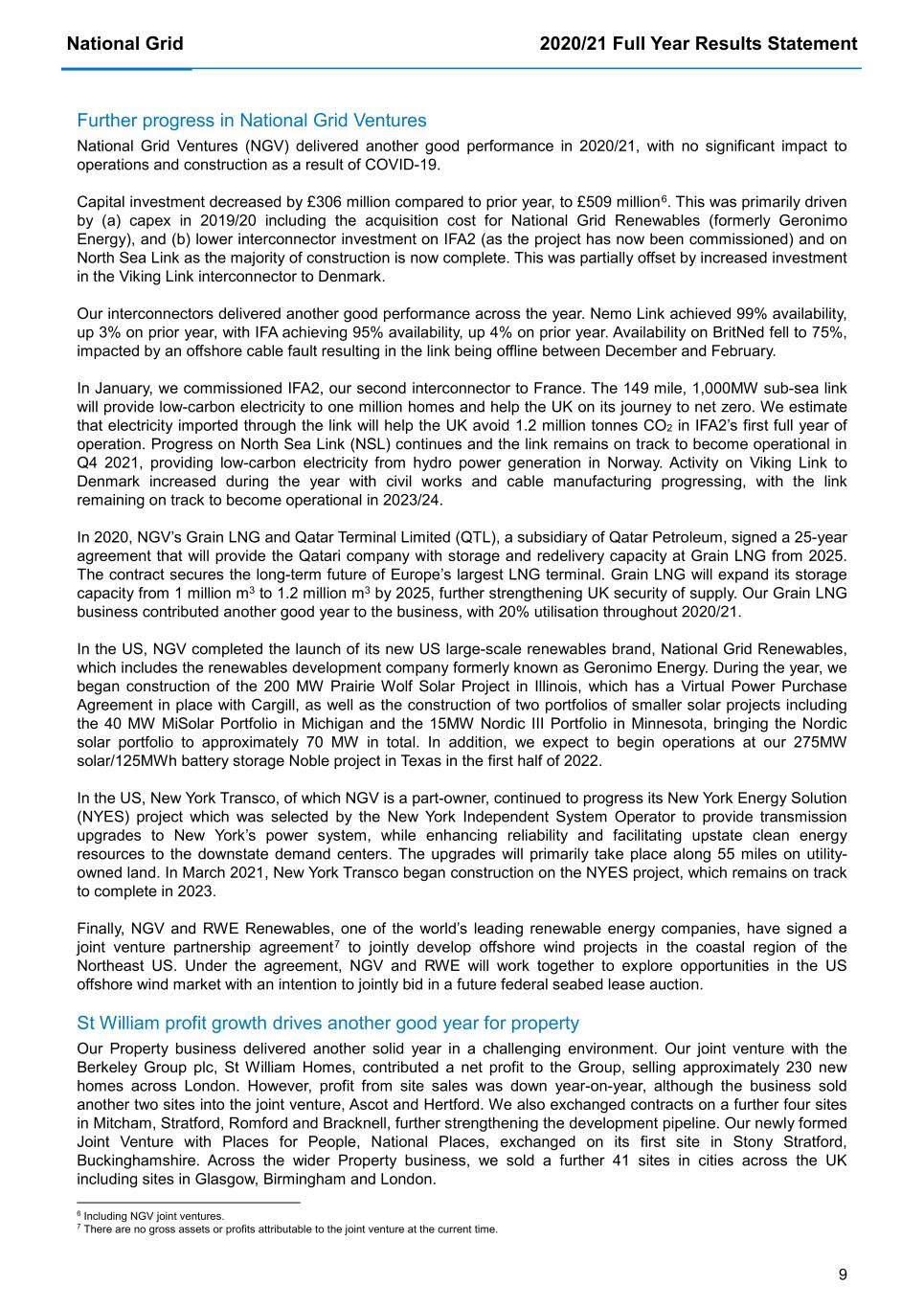
National Grid 2020/21 Full Year Results Statement 9 Further progress in National Grid Ventures National Grid Ventures (NGV) delivered another good performance in 2020/21, with no significant impact to operations and construction as a result of COVID-19. Capital investment decreased by £306 million compared to prior year, to £509 million6. This was primarily driven by (a) capex in 2019/20 including the acquisition cost for National Grid Renewables (formerly Geronimo Energy), and (b) lower interconnector investment on IFA2 (as the project has now been commissioned) and on North Sea Link as the majority of construction is now complete. This was partially offset by increased investment in the Viking Link interconnector to Denmark. Our interconnectors delivered another good performance across the year. Nemo Link achieved 99% availability, up 3% on prior year, with IFA achieving 95% availability, up 4% on prior year. Availability on BritNed fell to 75%, impacted by an offshore cable fault resulting in the link being offline between December and February. In January, we commissioned IFA2, our second interconnector to France. The 149 mile, 1,000MW sub-sea link will provide low-carbon electricity to one million homes and help the UK on its journey to net zero. We estimate that electricity imported through the link will help the UK avoid 1.2 million tonnes CO2 in IFA2’s first full year of operation. Progress on North Sea Link (NSL) continues and the link remains on track to become operational in Q4 2021, providing low-carbon electricity from hydro power generation in Norway. Activity on Viking Link to Denmark increased during the year with civil works and cable manufacturing progressing, with the link remaining on track to become operational in 2023/24. In 2020, NGV’s Grain LNG and Qatar Terminal Limited (QTL), a subsidiary of Qatar Petroleum, signed a 25-year agreement that will provide the Qatari company with storage and redelivery capacity at Grain LNG from 2025. The contract secures the long-term future of Europe’s largest LNG terminal. Grain LNG will expand its storage capacity from 1 million m3 to 1.2 million m3 by 2025, further strengthening UK security of supply. Our Grain LNG business contributed another good year to the business, with 20% utilisation throughout 2020/21. In the US, NGV completed the launch of its new US large-scale renewables brand, National Grid Renewables, which includes the renewables development company formerly known as Geronimo Energy. During the year, we began construction of the 200 MW Prairie Wolf Solar Project in Illinois, which has a Virtual Power Purchase Agreement in place with Cargill, as well as the construction of two portfolios of smaller solar projects including the 40 MW MiSolar Portfolio in Michigan and the 15MW Nordic III Portfolio in Minnesota, bringing the Nordic solar portfolio to approximately 70 MW in total. In addition, we expect to begin operations at our 275MW solar/125MWh battery storage Noble project in Texas in the first half of 2022. In the US, New York Transco, of which NGV is a part-owner, continued to progress its New York Energy Solution (NYES) project which was selected by the New York Independent System Operator to provide transmission upgrades to New York’s power system, while enhancing reliability and facilitating upstate clean energy resources to the downstate demand centers. The upgrades will primarily take place along 55 miles on utility- owned land. In March 2021, New York Transco began construction on the NYES project, which remains on track to complete in 2023. Finally, NGV and RWE Renewables, one of the world’s leading renewable energy companies, have signed a joint venture partnership agreement7 to jointly develop offshore wind projects in the coastal region of the Northeast US. Under the agreement, NGV and RWE will work together to explore opportunities in the US offshore wind market with an intention to jointly bid in a future federal seabed lease auction. St William profit growth drives another good year for property Our Property business delivered another solid year in a challenging environment. Our joint venture with the Berkeley Group plc, St William Homes, contributed a net profit to the Group, selling approximately 230 new homes across London. However, profit from site sales was down year-on-year, although the business sold another two sites into the joint venture, Ascot and Hertford. We also exchanged contracts on a further four sites in Mitcham, Stratford, Romford and Bracknell, further strengthening the development pipeline. Our newly formed Joint Venture with Places for People, National Places, exchanged on its first site in Stony Stratford, Buckinghamshire. Across the wider Property business, we sold a further 41 sites in cities across the UK including sites in Glasgow, Birmingham and London. 6 Including NGV joint ventures. 7 There are no gross assets or profits attributable to the joint venture at the current time.

National Grid 2020/21 Full Year Results Statement 10 A landmark year in strengthening our ESG commitments National Grid is fully committed to its role in tackling climate change and as a responsible company for the communities we serve. Responsible Business Charter In October, we launched our Responsible Business Charter which lays out our long-term goals across five pillars: the environment, our people, our communities, the economy and our governance. In June, we will publish our first Responsible Business Report (alongside our Annual Report) which will set out the progress we have made against our goals, bringing all our responsible business reporting into one place. The report will include work we have done with the Science Based Targets initiative (SBTi) to increase our ambition around our Scope 3 emissions reduction target. Whilst our existing Scope 1 and 2 targets are already aligned to a below two degrees pathway, we have worked closely with the SBTi to increase the ambition of our Scope 3 target which now covers emissions across National Grid’s entire value chain and a commitment to reduce carbon emissions 37.5% by 2033/34 from a 2018/19 baseline. This has allowed us to become a signatory of the Business Ambition for 1.5°C, and the Race to Zero, both of which are United Nations campaigns to bring about greater support and leadership to the climate debate. We plan to go further and are working internally, with our partners and with the SBTi, to understand how best to stretch our ambition and explore what a 1.5°C pathway would mean to the business and our supply chain. Commitment to our communities – Grid for Good To support the delivery of our commitment as a responsible business in relation to our communities, we also launched Grid for Good. This is our flagship community investment programme, designed to deliver social mobility in the hardest to reach corners of our communities for disadvantaged youth aged between 16 and 24. Through the Grid for Good pathway, and with the help of our employee volunteers, young people have a unique opportunity to learn about the energy industry, network with one another, gain valuable skills, receive a mentor, have a chance to gain valuable work experience, and ultimately achieve meaningful careers with us and our partners now, or in the future. We believe that fresh talent and diverse perspectives in our own organisation and our industry will be a key contributor in achieving a diverse workforce who will help us to deliver against our net zero ambitions. Changes to our operating model With our vision to be at the heart of a clean, fair and affordable energy future, we must ensure we can effectively and efficiently deliver the financial, customer and regulatory outcomes that will help on the journey towards net zero. To this end, we are changing our structure to an operating model with six business units. These units will be UK Electricity Transmission, the UK Electricity System Operator (ESO), UK Gas Transmission, New England, New York and NGV and Other. Each unit will be run as end-to-end enterprises within the Group portfolio, and will provide the flexibility needed to deliver both the company’s growth programme but also to align more effectively with the environmental aims of the jurisdictions that we serve. Board changes In September 2020, we announced the appointment of Paula Rosput Reynolds to succeed Sir Peter Gershon as Chair, and in March 2021 we announced that Sir Peter will step down from the Board with effect from 31 May 2021. Paula joined the Board on 1 January 2021 as Non-executive Director and Chair Designate and will take over as Chair of the Board from 31 May 2021. Paula is currently the Senior Independent Director of BP plc where she also chairs the Remuneration Committee and a Non-executive Director at General Electric Company. Mark Williamson stepped down as Chair and a member of the Audit Committee, with effect from 10 November 2020. Liz Hewitt, Independent Non-executive Director of the Company, stepped into the role on the same date. Paul Golby stepped down as Chair of the Safety, Environment and Health Committee with effect from 1 April 2021 at which point Earl Shipp took over as Chair of the Committee. Paul remains a member of the Safety, Environment and Health Committee and will remain so until he retires from the Board at the conclusion of the 2021 AGM.

National Grid 2020/21 Full Year Results Statement 11 GROWTH AND VALUE ADDED A balanced portfolio to deliver asset and dividend growth National Grid seeks to create value for shareholders through developing a balanced portfolio of businesses that offer an attractive combination of asset growth and cash returns. Strong organic growth driven by critical investment In 2020/21, the Group achieved asset growth of 5.6% driven by a £5.0 billion capital investment programme. This investment continued our focus on building and maintaining world-class networks that are safe, reliable, resilient and ready for the future. It is specifically focused on: • our regulated businesses: with the objective of upgrading and modernising ageing infrastructure, especially in the US, to meet the changing needs of customers and to drive the decarbonisation of energy supply; and • interconnector projects: with the objective of bringing a range of lower cost and renewable energy sources into the UK. Looking forward, we expect capital investment to be around £6 billion for the Group in 2021/22. National Grid is confident that this high-quality growth will continue to generate attractive returns for shareholders and add to our long-term investment proposition of sustainable asset and income growth. Funding of organic growth National Grid has a strong balance sheet and an efficient capital structure which supports the effective financing of our investment programme. This programme will continue to be financed through a combination of: • additional debt financing; • internally generated equity capital, delivered through strong financial performance in both the UK and US, including from operating efficiencies and from faster recovery of regulatory assets through rate filings and re- openers; and • additional equity capital generated through the take-up of the shareholder scrip dividend option, which we expect to continue to utilise whilst asset growth remains high. £5 billion of Capital Investment in 2020/21, 4% lower at constant currency We continued to make significant investments in critical energy infrastructure during 2020/21. Total capital investment across the Group was £5,047 million, a decrease of £210 million ((4)% at constant currency) compared to the prior year. Year ended 31 March Capital investment (£ million) At actual exchange rates At constant currency 2021 2020 % change 2021 2020 % change UK Electricity Transmission 1,072 1,043 3 % 1,072 1,043 3 % UK Gas Transmission 176 249 (29) % 176 249 (29) % US Regulated 3,223 3,228 — % 3,223 3,098 4 % NGV and other activities¹ 576 885 (35) % 576 867 (34) % Group capital investment 5,047 5,405 (7) % 5,047 5,257 (4) % 1. Excludes £nil (2020: £15 million) equity contribution to the St William Homes LLP joint venture. Includes £38 million National Grid Partners investment (2020: £61 million).
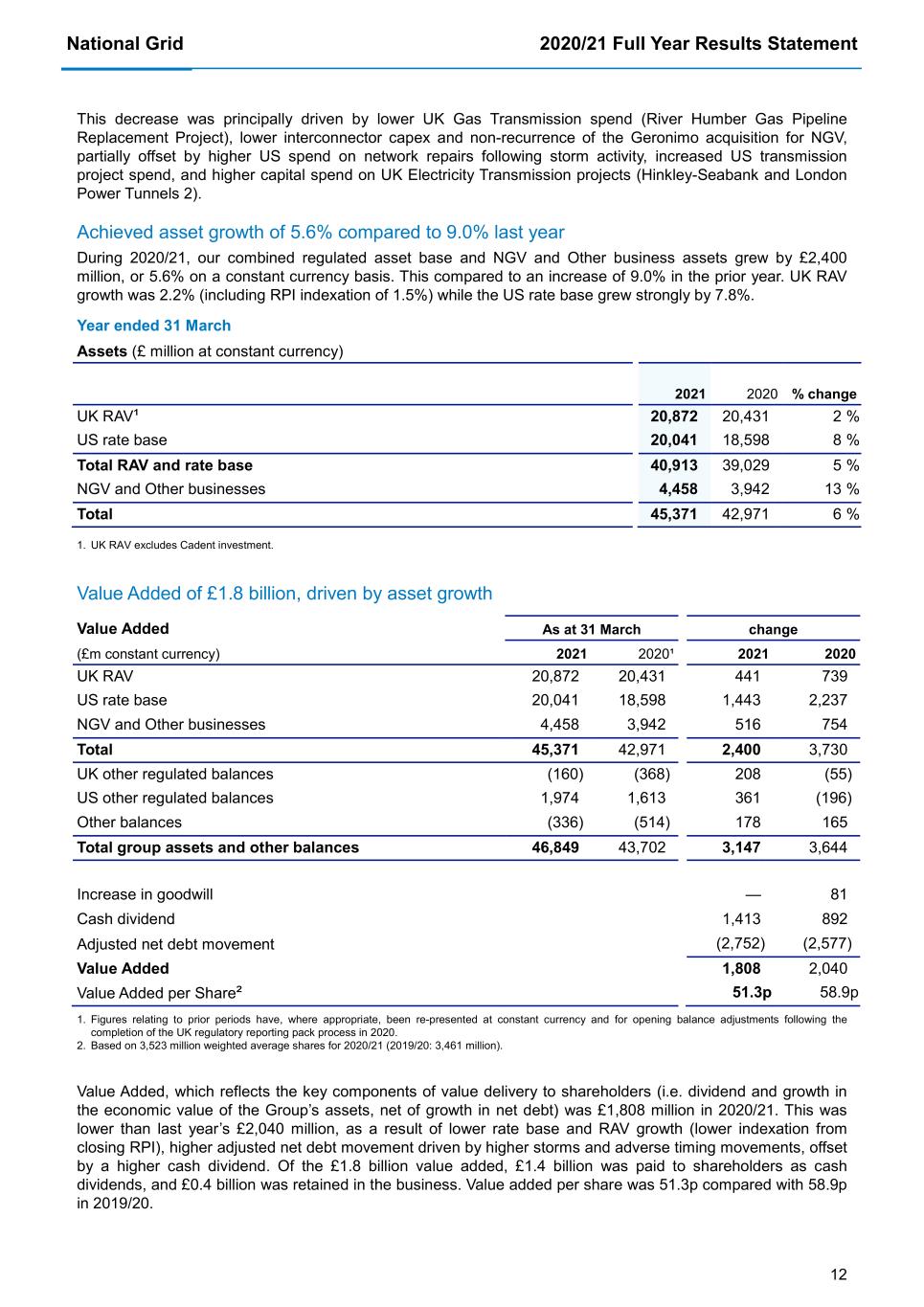
National Grid 2020/21 Full Year Results Statement 12 This decrease was principally driven by lower UK Gas Transmission spend (River Humber Gas Pipeline Replacement Project), lower interconnector capex and non-recurrence of the Geronimo acquisition for NGV, partially offset by higher US spend on network repairs following storm activity, increased US transmission project spend, and higher capital spend on UK Electricity Transmission projects (Hinkley-Seabank and London Power Tunnels 2). Achieved asset growth of 5.6% compared to 9.0% last year During 2020/21, our combined regulated asset base and NGV and Other business assets grew by £2,400 million, or 5.6% on a constant currency basis. This compared to an increase of 9.0% in the prior year. UK RAV growth was 2.2% (including RPI indexation of 1.5%) while the US rate base grew strongly by 7.8%. Year ended 31 March Assets (£ million at constant currency) 2021 2020 % change UK RAV¹ 20,872 20,431 2 % US rate base 20,041 18,598 8 % Total RAV and rate base 40,913 39,029 5 % NGV and Other businesses 4,458 3,942 13 % Total 45,371 42,971 6 % 1. UK RAV excludes Cadent investment. Value Added of £1.8 billion, driven by asset growth Value Added As at 31 March change (£m constant currency) 2021 2020¹ 2021 2020 UK RAV 20,872 20,431 441 739 US rate base 20,041 18,598 1,443 2,237 NGV and Other businesses 4,458 3,942 516 754 Total 45,371 42,971 2,400 3,730 UK other regulated balances (160) (368) 208 (55) US other regulated balances 1,974 1,613 361 (196) Other balances (336) (514) 178 165 Total group assets and other balances 46,849 43,702 3,147 3,644 Increase in goodwill — 81 Cash dividend 1,413 892 Adjusted net debt movement (2,752) (2,577) Value Added 1,808 2,040 Value Added per Share² 51.3p 58.9p 1. Figures relating to prior periods have, where appropriate, been re-presented at constant currency and for opening balance adjustments following the completion of the UK regulatory reporting pack process in 2020. 2. Based on 3,523 million weighted average shares for 2020/21 (2019/20: 3,461 million). Value Added, which reflects the key components of value delivery to shareholders (i.e. dividend and growth in the economic value of the Group’s assets, net of growth in net debt) was £1,808 million in 2020/21. This was lower than last year’s £2,040 million, as a result of lower rate base and RAV growth (lower indexation from closing RPI), higher adjusted net debt movement driven by higher storms and adverse timing movements, offset by a higher cash dividend. Of the £1.8 billion value added, £1.4 billion was paid to shareholders as cash dividends, and £0.4 billion was retained in the business. Value added per share was 51.3p compared with 58.9p in 2019/20.

National Grid 2020/21 Full Year Results Statement 13 FINANCIAL STRENGTH Credit metrics remain strong, BBB+/Baa1 rating During the year we raised over £5.6 billion of new long-term senior debt to refinance maturing debt and to fund a portion of our significant capital programme. The new bonds issued include further borrowings under our Green Financing Framework. We also used this framework to agree £539 million of ECA financing for our Viking interconnector. We have £6.0 billion of undrawn committed facilities available for general corporate purposes, all of which have expiry dates beyond June 2023. In March 2021, Moody’s, S&P and Fitch all downgraded the senior unsecured credit ratings of National Grid plc and the majority of our rated operating subsidiaries by one notch. This action reflected the agencies’ assessment that Group cash flow metrics would, for several years, no longer meet the thresholds previously expected. This reflected the combined impacts of the COVID-19 pandemic, increased levels of capital investment, delays to rate increases in our US operations and the cash flow impacts of the new RIIO-2 price control in the UK. Retained cash flow as a proportion of adjusted net debt was 6.6%. This is slightly below the long-term average level of 7% indicated by Moody’s as consistent with maintaining our current Group rating, although the metric this year has been impacted by a below average level of uptake of the scrip dividend option, alongside increased costs related to the COVID-19 pandemic, timing outflows and high levels of storm costs. The funds from operations to debt metric was 11.7%, in the middle of the target range for the current rating as indicated by S&P. Regulatory gearing, measured as net debt as a proportion of total regulatory asset value and other business invested capital, was 65% as at 31 March 2021. This was up from 63% at the previous year-end. Taking into account the benefit of our hybrid debt, adjusted gearing as at 31 March 2021 was 63% and remains appropriate for the current overall Group credit rating of BBB+/Baa1 (S&P/Moody’s). Dividend increase of 1.2% recommended for 2020/21 The Board decided in March that, to reflect the move from RPI to CPIH in our UK regulated businesses, the aim from 2021/22 will be to grow the annual dividend per share in line with UK CPIH, thus maintaining the dividend per share in real terms. The Board will review this policy regularly, taking into account a range of factors including expected business performance and regulatory developments. Our previous dividend policy, set out in 2013, was to grow the ordinary dividend per share at least in line with RPI inflation each year. The final year this policy applies to is 2020/21 and, as usual, the Board has taken into account a range of factors including expected business performance and regulatory developments. For 2020/21, the Board has recommended an increase in the final dividend to 32.16 pence per ordinary share ($2.2812 per American Depositary Share) which will be paid to shareholders on the register as at 4 June 2021. If approved, this will bring the full year dividend to 49.16 pence per ordinary share, an increase of 1.2% over the 48.57 pence per ordinary share in respect of the financial year ending 31 March 2021. This rise is in line with the increase in UK RPI for the twelve months to 31 March 2021 as set out in the policy announcement of 28 March 2013. A scrip dividend alternative will again be offered in respect of the 2020/21 final dividend.
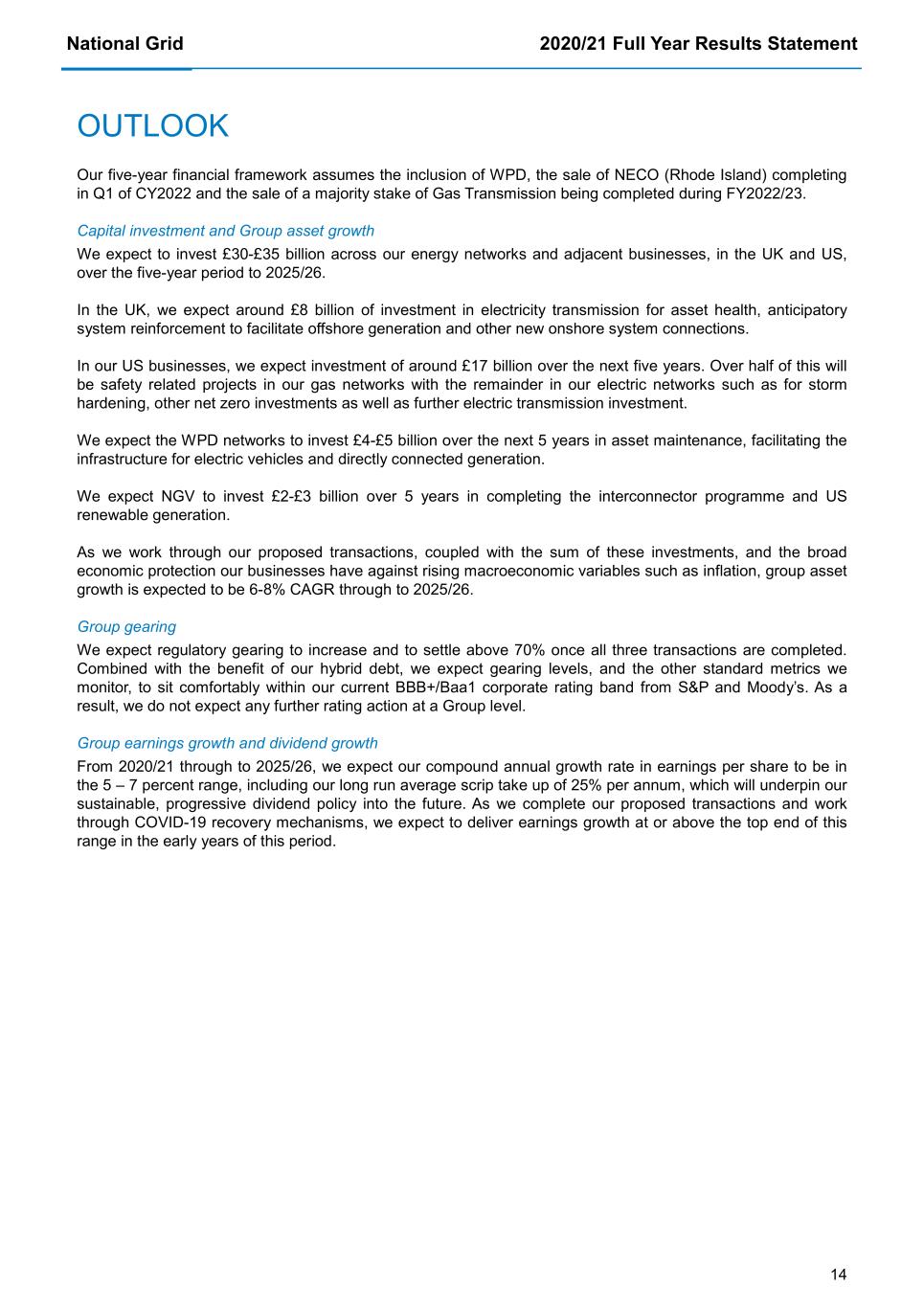
National Grid 2020/21 Full Year Results Statement 14 OUTLOOK Our five-year financial framework assumes the inclusion of WPD, the sale of NECO (Rhode Island) completing in Q1 of CY2022 and the sale of a majority stake of Gas Transmission being completed during FY2022/23. Capital investment and Group asset growth We expect to invest £30-£35 billion across our energy networks and adjacent businesses, in the UK and US, over the five-year period to 2025/26. In the UK, we expect around £8 billion of investment in electricity transmission for asset health, anticipatory system reinforcement to facilitate offshore generation and other new onshore system connections. In our US businesses, we expect investment of around £17 billion over the next five years. Over half of this will be safety related projects in our gas networks with the remainder in our electric networks such as for storm hardening, other net zero investments as well as further electric transmission investment. We expect the WPD networks to invest £4-£5 billion over the next 5 years in asset maintenance, facilitating the infrastructure for electric vehicles and directly connected generation. We expect NGV to invest £2-£3 billion over 5 years in completing the interconnector programme and US renewable generation. As we work through our proposed transactions, coupled with the sum of these investments, and the broad economic protection our businesses have against rising macroeconomic variables such as inflation, group asset growth is expected to be 6-8% CAGR through to 2025/26. Group gearing We expect regulatory gearing to increase and to settle above 70% once all three transactions are completed. Combined with the benefit of our hybrid debt, we expect gearing levels, and the other standard metrics we monitor, to sit comfortably within our current BBB+/Baa1 corporate rating band from S&P and Moody’s. As a result, we do not expect any further rating action at a Group level. Group earnings growth and dividend growth From 2020/21 through to 2025/26, we expect our compound annual growth rate in earnings per share to be in the 5 – 7 percent range, including our long run average scrip take up of 25% per annum, which will underpin our sustainable, progressive dividend policy into the future. As we complete our proposed transactions and work through COVID-19 recovery mechanisms, we expect to deliver earnings growth at or above the top end of this range in the early years of this period.
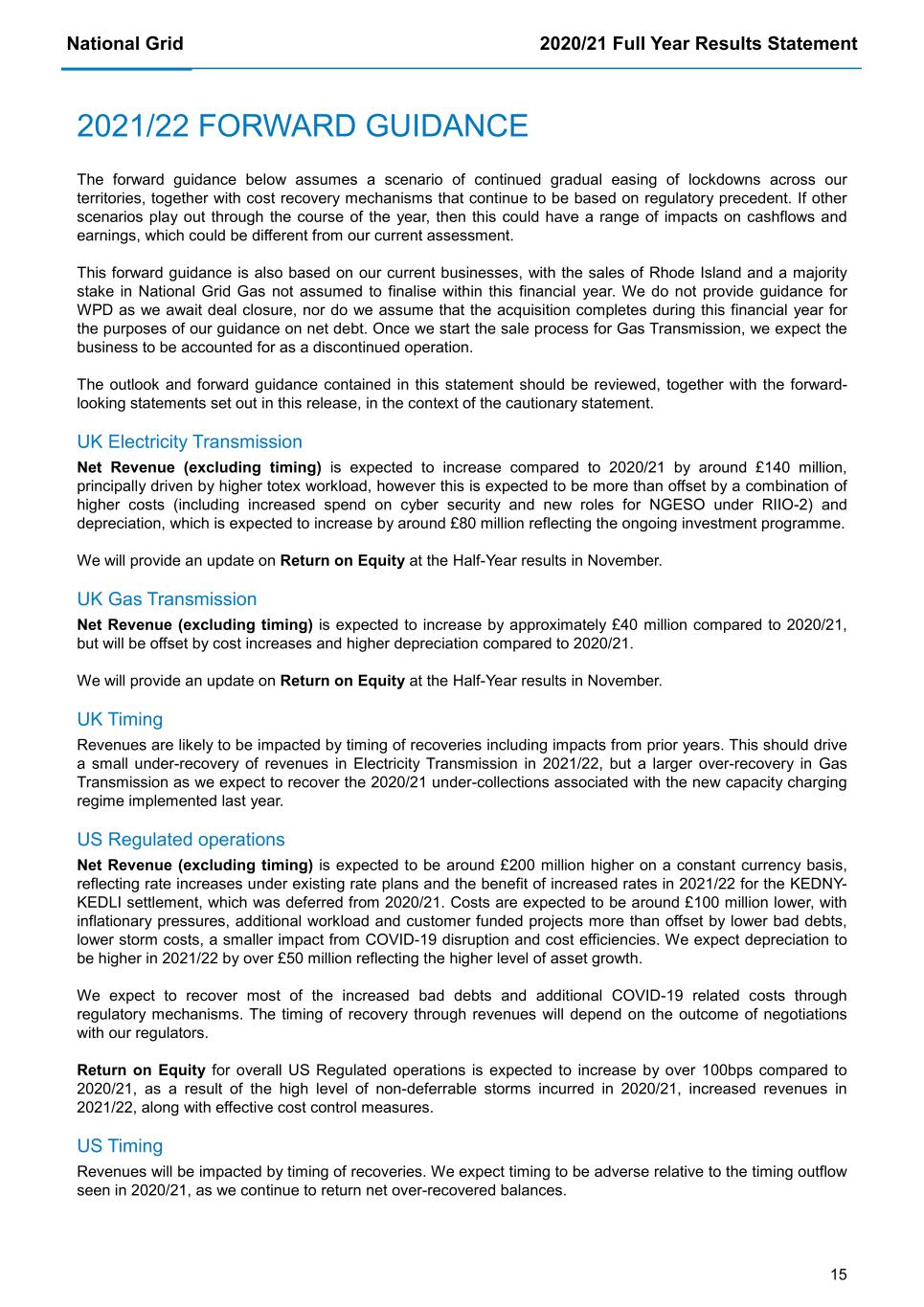
National Grid 2020/21 Full Year Results Statement 15 2021/22 FORWARD GUIDANCE The forward guidance below assumes a scenario of continued gradual easing of lockdowns across our territories, together with cost recovery mechanisms that continue to be based on regulatory precedent. If other scenarios play out through the course of the year, then this could have a range of impacts on cashflows and earnings, which could be different from our current assessment. This forward guidance is also based on our current businesses, with the sales of Rhode Island and a majority stake in National Grid Gas not assumed to finalise within this financial year. We do not provide guidance for WPD as we await deal closure, nor do we assume that the acquisition completes during this financial year for the purposes of our guidance on net debt. Once we start the sale process for Gas Transmission, we expect the business to be accounted for as a discontinued operation. The outlook and forward guidance contained in this statement should be reviewed, together with the forward- looking statements set out in this release, in the context of the cautionary statement. UK Electricity Transmission Net Revenue (excluding timing) is expected to increase compared to 2020/21 by around £140 million, principally driven by higher totex workload, however this is expected to be more than offset by a combination of higher costs (including increased spend on cyber security and new roles for NGESO under RIIO-2) and depreciation, which is expected to increase by around £80 million reflecting the ongoing investment programme. We will provide an update on Return on Equity at the Half-Year results in November. UK Gas Transmission Net Revenue (excluding timing) is expected to increase by approximately £40 million compared to 2020/21, but will be offset by cost increases and higher depreciation compared to 2020/21. We will provide an update on Return on Equity at the Half-Year results in November. UK Timing Revenues are likely to be impacted by timing of recoveries including impacts from prior years. This should drive a small under-recovery of revenues in Electricity Transmission in 2021/22, but a larger over-recovery in Gas Transmission as we expect to recover the 2020/21 under-collections associated with the new capacity charging regime implemented last year. US Regulated operations Net Revenue (excluding timing) is expected to be around £200 million higher on a constant currency basis, reflecting rate increases under existing rate plans and the benefit of increased rates in 2021/22 for the KEDNY- KEDLI settlement, which was deferred from 2020/21. Costs are expected to be around £100 million lower, with inflationary pressures, additional workload and customer funded projects more than offset by lower bad debts, lower storm costs, a smaller impact from COVID-19 disruption and cost efficiencies. We expect depreciation to be higher in 2021/22 by over £50 million reflecting the higher level of asset growth. We expect to recover most of the increased bad debts and additional COVID-19 related costs through regulatory mechanisms. The timing of recovery through revenues will depend on the outcome of negotiations with our regulators. Return on Equity for overall US Regulated operations is expected to increase by over 100bps compared to 2020/21, as a result of the high level of non-deferrable storms incurred in 2020/21, increased revenues in 2021/22, along with effective cost control measures. US Timing Revenues will be impacted by timing of recoveries. We expect timing to be adverse relative to the timing outflow seen in 2020/21, as we continue to return net over-recovered balances.
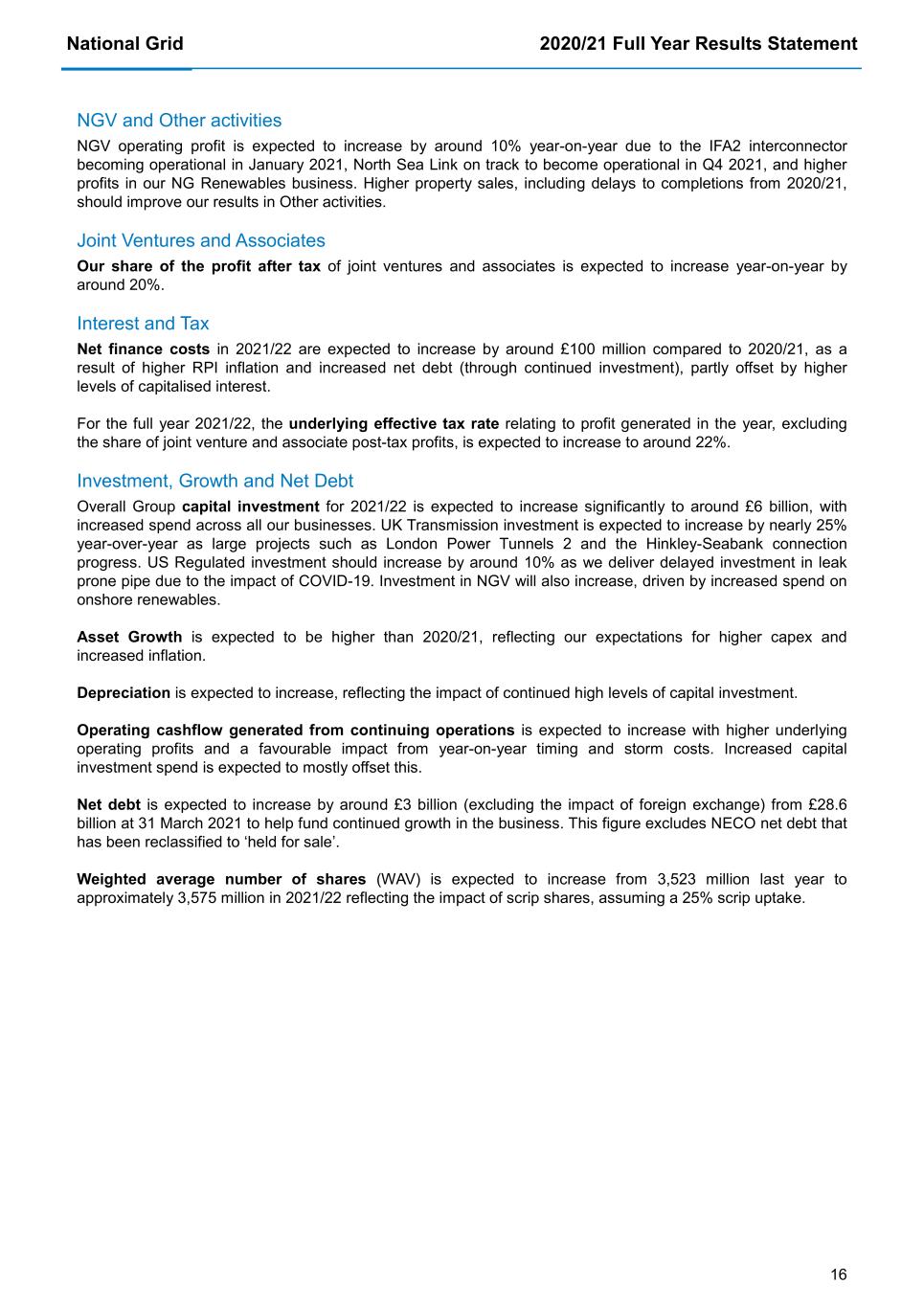
National Grid 2020/21 Full Year Results Statement 16 NGV and Other activities NGV operating profit is expected to increase by around 10% year-on-year due to the IFA2 interconnector becoming operational in January 2021, North Sea Link on track to become operational in Q4 2021, and higher profits in our NG Renewables business. Higher property sales, including delays to completions from 2020/21, should improve our results in Other activities. Joint Ventures and Associates Our share of the profit after tax of joint ventures and associates is expected to increase year-on-year by around 20%. Interest and Tax Net finance costs in 2021/22 are expected to increase by around £100 million compared to 2020/21, as a result of higher RPI inflation and increased net debt (through continued investment), partly offset by higher levels of capitalised interest. For the full year 2021/22, the underlying effective tax rate relating to profit generated in the year, excluding the share of joint venture and associate post-tax profits, is expected to increase to around 22%. Investment, Growth and Net Debt Overall Group capital investment for 2021/22 is expected to increase significantly to around £6 billion, with increased spend across all our businesses. UK Transmission investment is expected to increase by nearly 25% year-over-year as large projects such as London Power Tunnels 2 and the Hinkley-Seabank connection progress. US Regulated investment should increase by around 10% as we deliver delayed investment in leak prone pipe due to the impact of COVID-19. Investment in NGV will also increase, driven by increased spend on onshore renewables. Asset Growth is expected to be higher than 2020/21, reflecting our expectations for higher capex and increased inflation. Depreciation is expected to increase, reflecting the impact of continued high levels of capital investment. Operating cashflow generated from continuing operations is expected to increase with higher underlying operating profits and a favourable impact from year-on-year timing and storm costs. Increased capital investment spend is expected to mostly offset this. Net debt is expected to increase by around £3 billion (excluding the impact of foreign exchange) from £28.6 billion at 31 March 2021 to help fund continued growth in the business. This figure excludes NECO net debt that has been reclassified to ‘held for sale’. Weighted average number of shares (WAV) is expected to increase from 3,523 million last year to approximately 3,575 million in 2021/22 reflecting the impact of scrip shares, assuming a 25% scrip uptake.
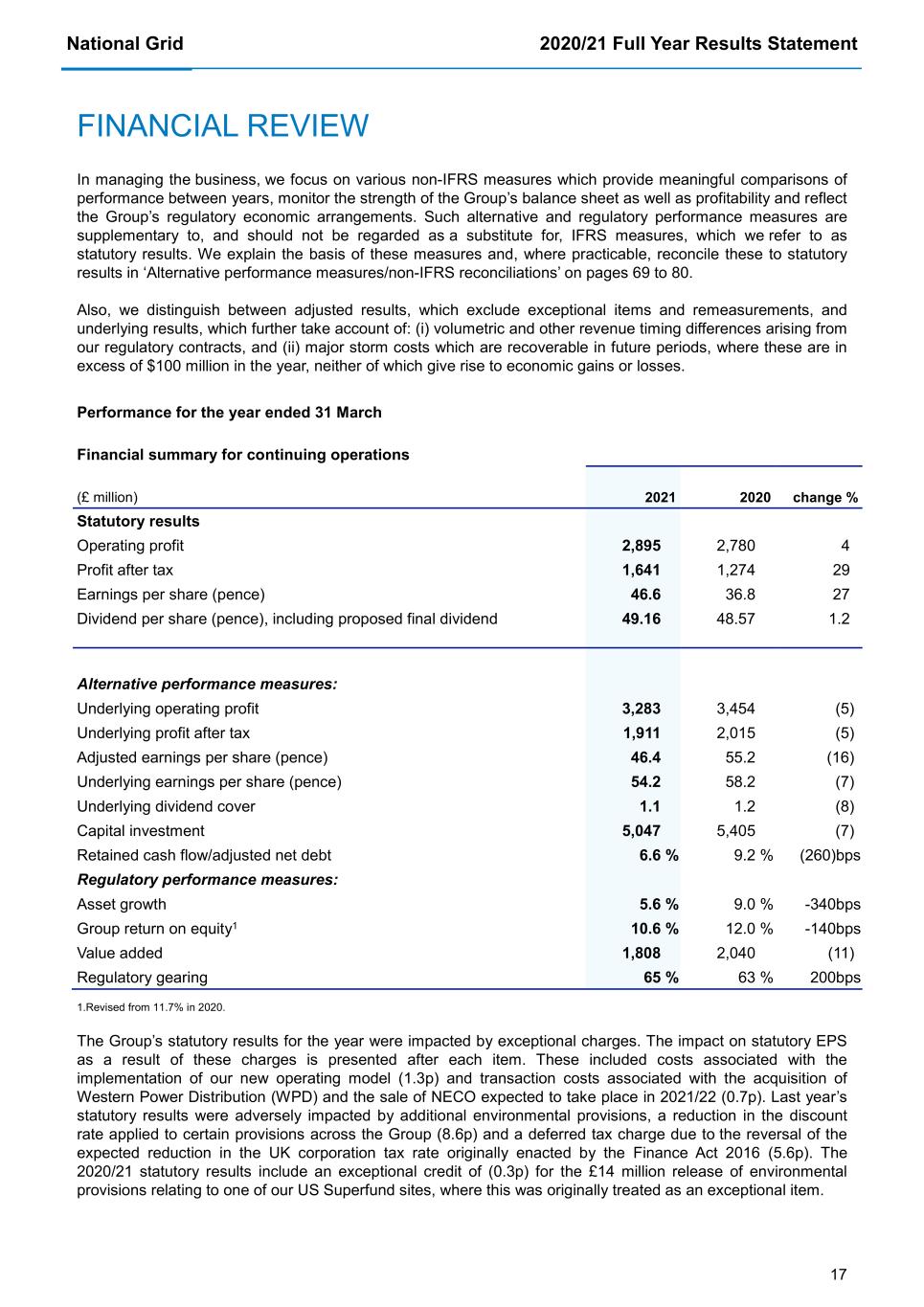
National Grid 2020/21 Full Year Results Statement 17 FINANCIAL REVIEW In managing the business, we focus on various non-IFRS measures which provide meaningful comparisons of performance between years, monitor the strength of the Group’s balance sheet as well as profitability and reflect the Group’s regulatory economic arrangements. Such alternative and regulatory performance measures are supplementary to, and should not be regarded as a substitute for, IFRS measures, which we refer to as statutory results. We explain the basis of these measures and, where practicable, reconcile these to statutory results in ‘Alternative performance measures/non-IFRS reconciliations’ on pages 69 to 80. Also, we distinguish between adjusted results, which exclude exceptional items and remeasurements, and underlying results, which further take account of: (i) volumetric and other revenue timing differences arising from our regulatory contracts, and (ii) major storm costs which are recoverable in future periods, where these are in excess of $100 million in the year, neither of which give rise to economic gains or losses. Performance for the year ended 31 March Financial summary for continuing operations (£ million) 2021 2020 change % Statutory results Operating profit 2,895 2,780 4 Profit after tax 1,641 1,274 29 Earnings per share (pence) 46.6 36.8 27 Dividend per share (pence), including proposed final dividend 49.16 48.57 1.2 Alternative performance measures: Underlying operating profit 3,283 3,454 (5) Underlying profit after tax 1,911 2,015 (5) Adjusted earnings per share (pence) 46.4 55.2 (16) Underlying earnings per share (pence) 54.2 58.2 (7) Underlying dividend cover 1.1 1.2 (8) Capital investment 5,047 5,405 (7) Retained cash flow/adjusted net debt 6.6 % 9.2 % (260)bps Regulatory performance measures: Asset growth 5.6 % 9.0 % -340bps Group return on equity1 10.6 % 12.0 % -140bps Value added 1,808 2,040 (11) Regulatory gearing 65 % 63 % 200bps 1.Revised from 11.7% in 2020. The Group’s statutory results for the year were impacted by exceptional charges. The impact on statutory EPS as a result of these charges is presented after each item. These included costs associated with the implementation of our new operating model (1.3p) and transaction costs associated with the acquisition of Western Power Distribution (WPD) and the sale of NECO expected to take place in 2021/22 (0.7p). Last year’s statutory results were adversely impacted by additional environmental provisions, a reduction in the discount rate applied to certain provisions across the Group (8.6p) and a deferred tax charge due to the reversal of the expected reduction in the UK corporation tax rate originally enacted by the Finance Act 2016 (5.6p). The 2020/21 statutory results include an exceptional credit of (0.3p) for the £14 million release of environmental provisions relating to one of our US Superfund sites, where this was originally treated as an exceptional item.
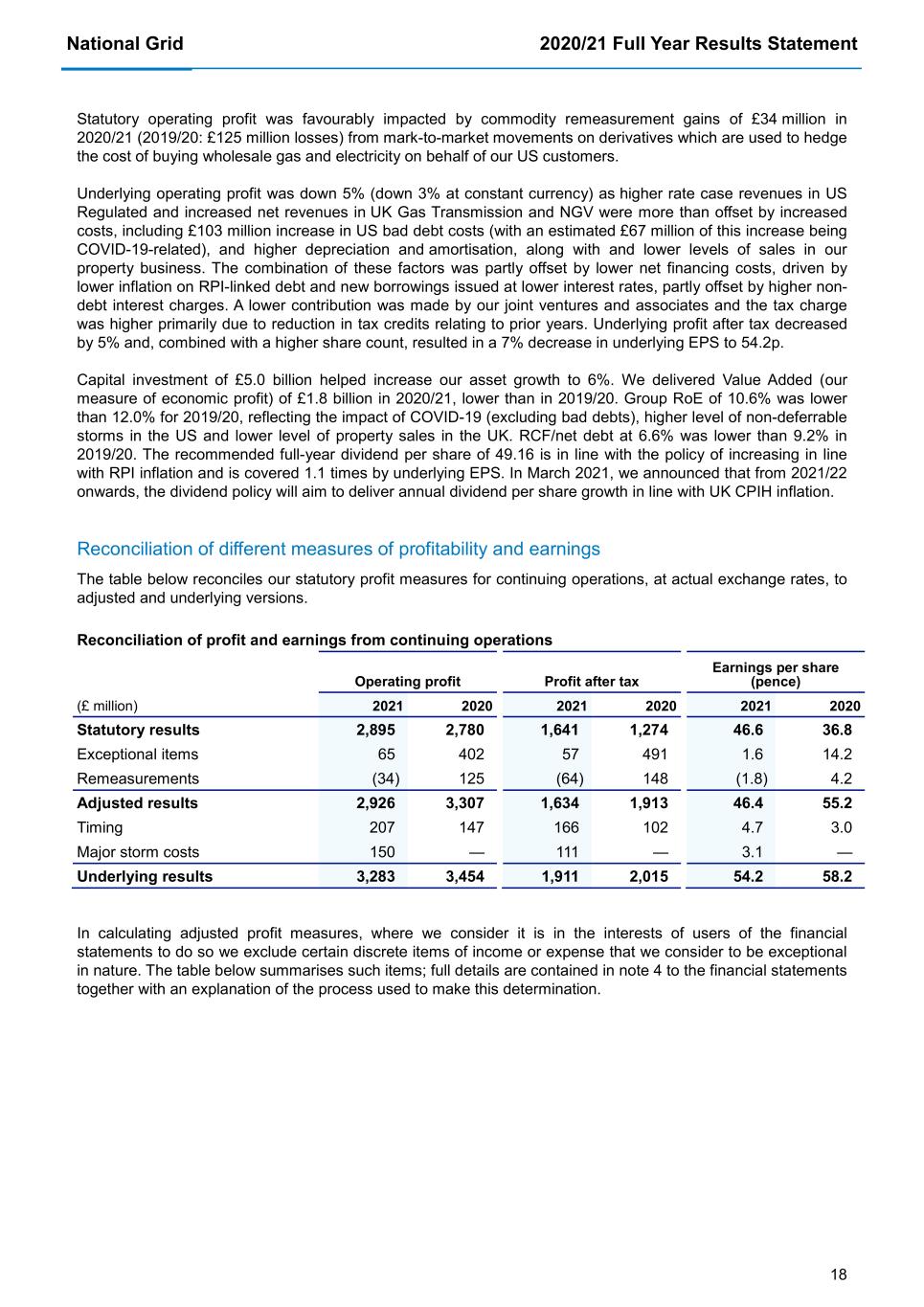
National Grid 2020/21 Full Year Results Statement 18 Statutory operating profit was favourably impacted by commodity remeasurement gains of £34 million in 2020/21 (2019/20: £125 million losses) from mark-to-market movements on derivatives which are used to hedge the cost of buying wholesale gas and electricity on behalf of our US customers. Underlying operating profit was down 5% (down 3% at constant currency) as higher rate case revenues in US Regulated and increased net revenues in UK Gas Transmission and NGV were more than offset by increased costs, including £103 million increase in US bad debt costs (with an estimated £67 million of this increase being COVID-19-related), and higher depreciation and amortisation, along with and lower levels of sales in our property business. The combination of these factors was partly offset by lower net financing costs, driven by lower inflation on RPI-linked debt and new borrowings issued at lower interest rates, partly offset by higher non- debt interest charges. A lower contribution was made by our joint ventures and associates and the tax charge was higher primarily due to reduction in tax credits relating to prior years. Underlying profit after tax decreased by 5% and, combined with a higher share count, resulted in a 7% decrease in underlying EPS to 54.2p. Capital investment of £5.0 billion helped increase our asset growth to 6%. We delivered Value Added (our measure of economic profit) of £1.8 billion in 2020/21, lower than in 2019/20. Group RoE of 10.6% was lower than 12.0% for 2019/20, reflecting the impact of COVID-19 (excluding bad debts), higher level of non-deferrable storms in the US and lower level of property sales in the UK. RCF/net debt at 6.6% was lower than 9.2% in 2019/20. The recommended full-year dividend per share of 49.16 is in line with the policy of increasing in line with RPI inflation and is covered 1.1 times by underlying EPS. In March 2021, we announced that from 2021/22 onwards, the dividend policy will aim to deliver annual dividend per share growth in line with UK CPIH inflation. Reconciliation of different measures of profitability and earnings The table below reconciles our statutory profit measures for continuing operations, at actual exchange rates, to adjusted and underlying versions. Reconciliation of profit and earnings from continuing operations Operating profit Profit after tax Earnings per share (pence) (£ million) 2021 2020 2021 2020 2021 2020 Statutory results 2,895 2,780 1,641 1,274 46.6 36.8 Exceptional items 65 402 57 491 1.6 14.2 Remeasurements (34) 125 (64) 148 (1.8) 4.2 Adjusted results 2,926 3,307 1,634 1,913 46.4 55.2 Timing 207 147 166 102 4.7 3.0 Major storm costs 150 — 111 — 3.1 — Underlying results 3,283 3,454 1,911 2,015 54.2 58.2 In calculating adjusted profit measures, where we consider it is in the interests of users of the financial statements to do so we exclude certain discrete items of income or expense that we consider to be exceptional in nature. The table below summarises such items; full details are contained in note 4 to the financial statements together with an explanation of the process used to make this determination.
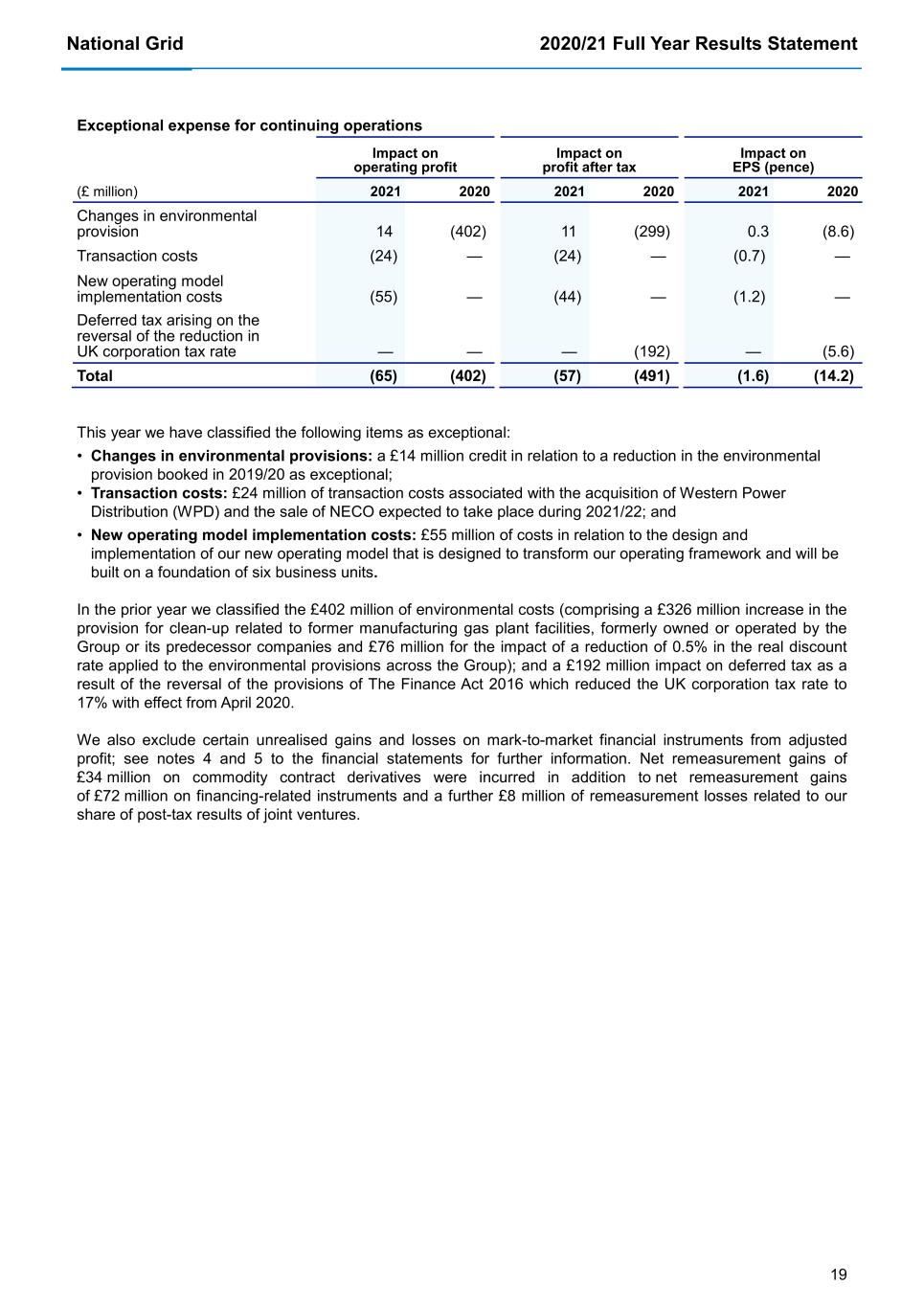
National Grid 2020/21 Full Year Results Statement 19 Exceptional expense for continuing operations Impact on operating profit Impact on profit after tax Impact on EPS (pence) (£ million) 2021 2020 2021 2020 2021 2020 Changes in environmental provision 14 (402) 11 (299) 0.3 (8.6) Transaction costs (24) — (24) — (0.7) — New operating model implementation costs (55) — (44) — (1.2) — Deferred tax arising on the reversal of the reduction in UK corporation tax rate — — — (192) — (5.6) Total (65) (402) (57) (491) (1.6) (14.2) This year we have classified the following items as exceptional: • Changes in environmental provisions: a £14 million credit in relation to a reduction in the environmental provision booked in 2019/20 as exceptional; • Transaction costs: £24 million of transaction costs associated with the acquisition of Western Power Distribution (WPD) and the sale of NECO expected to take place during 2021/22; and • New operating model implementation costs: £55 million of costs in relation to the design and implementation of our new operating model that is designed to transform our operating framework and will be built on a foundation of six business units. In the prior year we classified the £402 million of environmental costs (comprising a £326 million increase in the provision for clean-up related to former manufacturing gas plant facilities, formerly owned or operated by the Group or its predecessor companies and £76 million for the impact of a reduction of 0.5% in the real discount rate applied to the environmental provisions across the Group); and a £192 million impact on deferred tax as a result of the reversal of the provisions of The Finance Act 2016 which reduced the UK corporation tax rate to 17% with effect from April 2020. We also exclude certain unrealised gains and losses on mark-to-market financial instruments from adjusted profit; see notes 4 and 5 to the financial statements for further information. Net remeasurement gains of £34 million on commodity contract derivatives were incurred in addition to net remeasurement gains of £72 million on financing-related instruments and a further £8 million of remeasurement losses related to our share of post-tax results of joint ventures.
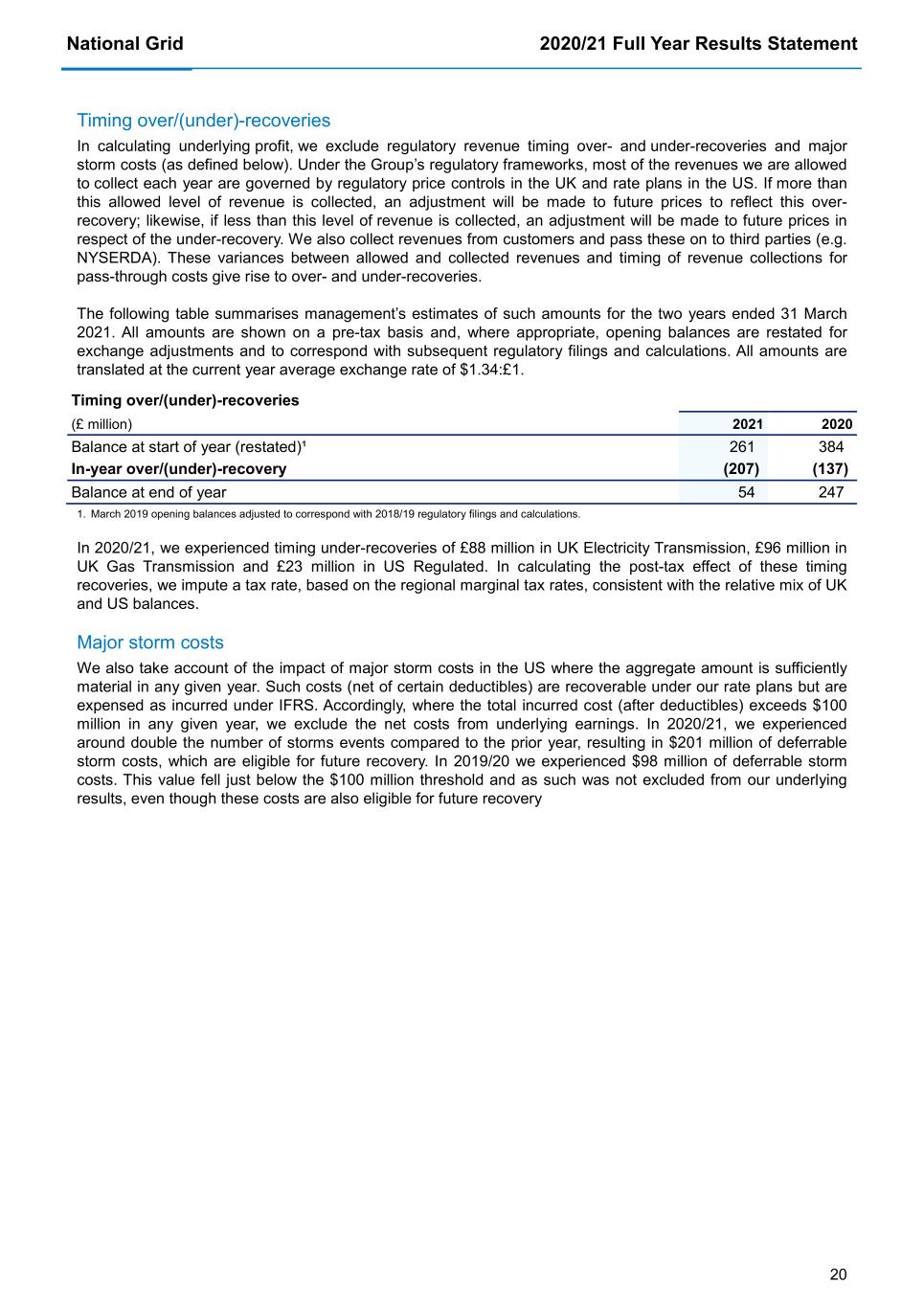
National Grid 2020/21 Full Year Results Statement 20 Timing over/(under)-recoveries In calculating underlying profit, we exclude regulatory revenue timing over- and under-recoveries and major storm costs (as defined below). Under the Group’s regulatory frameworks, most of the revenues we are allowed to collect each year are governed by regulatory price controls in the UK and rate plans in the US. If more than this allowed level of revenue is collected, an adjustment will be made to future prices to reflect this over- recovery; likewise, if less than this level of revenue is collected, an adjustment will be made to future prices in respect of the under-recovery. We also collect revenues from customers and pass these on to third parties (e.g. NYSERDA). These variances between allowed and collected revenues and timing of revenue collections for pass-through costs give rise to over- and under-recoveries. The following table summarises management’s estimates of such amounts for the two years ended 31 March 2021. All amounts are shown on a pre-tax basis and, where appropriate, opening balances are restated for exchange adjustments and to correspond with subsequent regulatory filings and calculations. All amounts are translated at the current year average exchange rate of $1.34:£1. Timing over/(under)-recoveries (£ million) 2021 2020 Balance at start of year (restated)¹ 261 384 In-year over/(under)-recovery (207) (137) Balance at end of year 54 247 1. March 2019 opening balances adjusted to correspond with 2018/19 regulatory filings and calculations. In 2020/21, we experienced timing under-recoveries of £88 million in UK Electricity Transmission, £96 million in UK Gas Transmission and £23 million in US Regulated. In calculating the post-tax effect of these timing recoveries, we impute a tax rate, based on the regional marginal tax rates, consistent with the relative mix of UK and US balances. Major storm costs We also take account of the impact of major storm costs in the US where the aggregate amount is sufficiently material in any given year. Such costs (net of certain deductibles) are recoverable under our rate plans but are expensed as incurred under IFRS. Accordingly, where the total incurred cost (after deductibles) exceeds $100 million in any given year, we exclude the net costs from underlying earnings. In 2020/21, we experienced around double the number of storms events compared to the prior year, resulting in $201 million of deferrable storm costs, which are eligible for future recovery. In 2019/20 we experienced $98 million of deferrable storm costs. This value fell just below the $100 million threshold and as such was not excluded from our underlying results, even though these costs are also eligible for future recovery
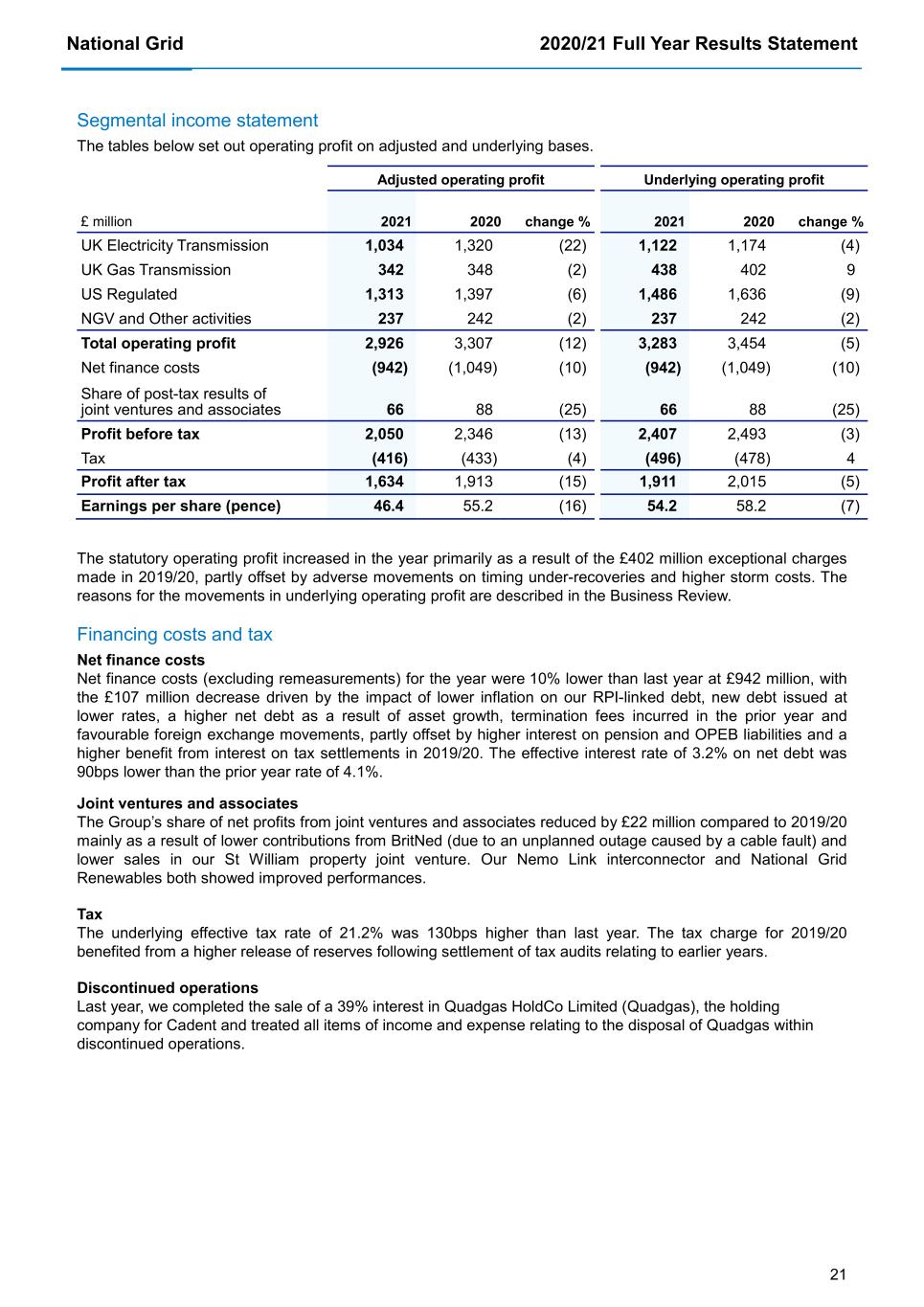
National Grid 2020/21 Full Year Results Statement 21 Segmental income statement The tables below set out operating profit on adjusted and underlying bases. Adjusted operating profit Underlying operating profit £ million 2021 2020 change % 2021 2020 change % UK Electricity Transmission 1,034 1,320 (22) 1,122 1,174 (4) UK Gas Transmission 342 348 (2) 438 402 9 US Regulated 1,313 1,397 (6) 1,486 1,636 (9) NGV and Other activities 237 242 (2) 237 242 (2) Total operating profit 2,926 3,307 (12) 3,283 3,454 (5) Net finance costs (942) (1,049) (10) (942) (1,049) (10) Share of post-tax results of joint ventures and associates 66 88 (25) 66 88 (25) Profit before tax 2,050 2,346 (13) 2,407 2,493 (3) Tax (416) (433) (4) (496) (478) 4 Profit after tax 1,634 1,913 (15) 1,911 2,015 (5) Earnings per share (pence) 46.4 55.2 (16) 54.2 58.2 (7) The statutory operating profit increased in the year primarily as a result of the £402 million exceptional charges made in 2019/20, partly offset by adverse movements on timing under-recoveries and higher storm costs. The reasons for the movements in underlying operating profit are described in the Business Review. Financing costs and tax Net finance costs Net finance costs (excluding remeasurements) for the year were 10% lower than last year at £942 million, with the £107 million decrease driven by the impact of lower inflation on our RPI-linked debt, new debt issued at lower rates, a higher net debt as a result of asset growth, termination fees incurred in the prior year and favourable foreign exchange movements, partly offset by higher interest on pension and OPEB liabilities and a higher benefit from interest on tax settlements in 2019/20. The effective interest rate of 3.2% on net debt was 90bps lower than the prior year rate of 4.1%. Joint ventures and associates The Group’s share of net profits from joint ventures and associates reduced by £22 million compared to 2019/20 mainly as a result of lower contributions from BritNed (due to an unplanned outage caused by a cable fault) and lower sales in our St William property joint venture. Our Nemo Link interconnector and National Grid Renewables both showed improved performances. Tax The underlying effective tax rate of 21.2% was 130bps higher than last year. The tax charge for 2019/20 benefited from a higher release of reserves following settlement of tax audits relating to earlier years. Discontinued operations Last year, we completed the sale of a 39% interest in Quadgas HoldCo Limited (Quadgas), the holding company for Cadent and treated all items of income and expense relating to the disposal of Quadgas within discontinued operations.
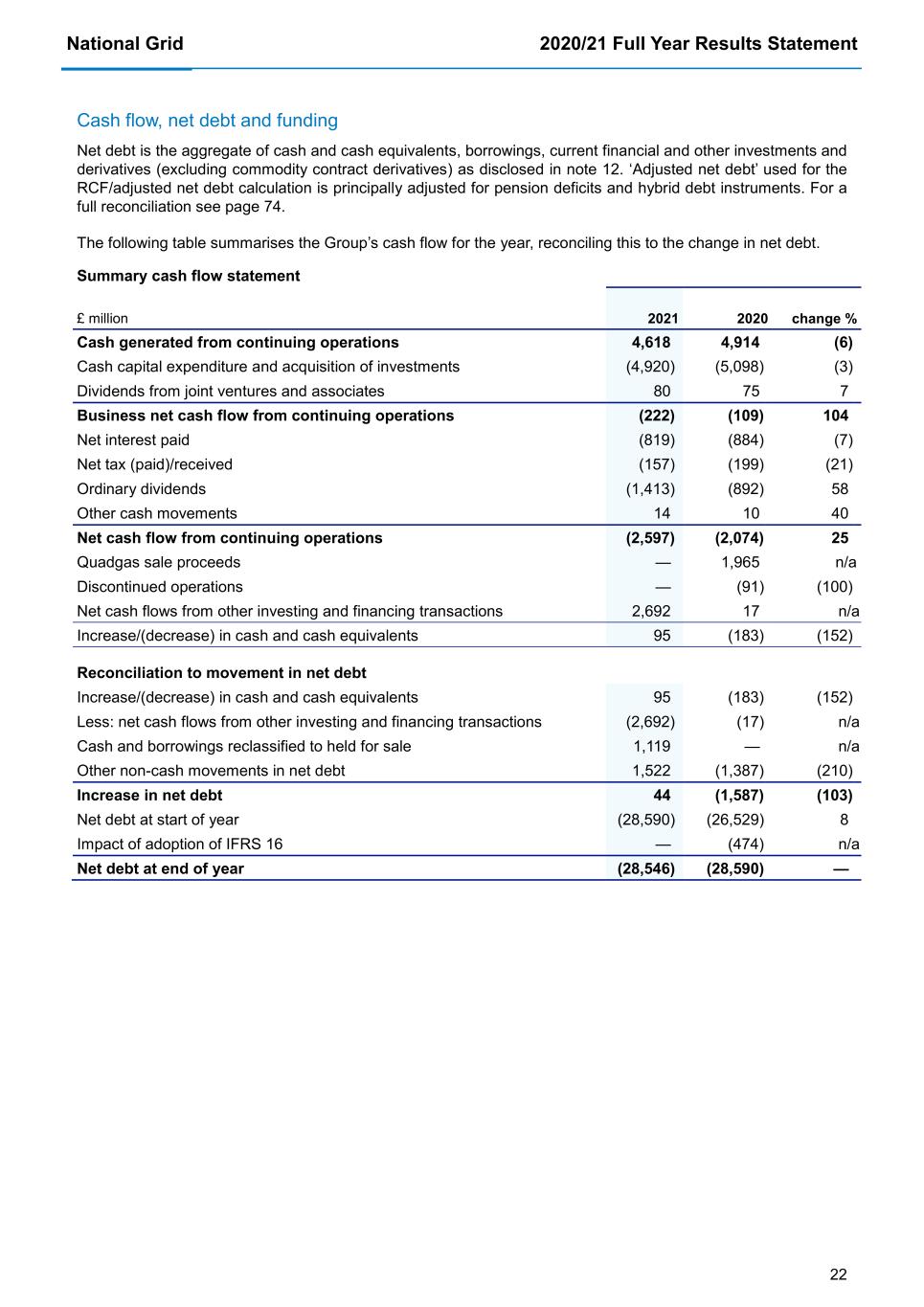
National Grid 2020/21 Full Year Results Statement 22 Cash flow, net debt and funding Net debt is the aggregate of cash and cash equivalents, borrowings, current financial and other investments and derivatives (excluding commodity contract derivatives) as disclosed in note 12. ‘Adjusted net debt’ used for the RCF/adjusted net debt calculation is principally adjusted for pension deficits and hybrid debt instruments. For a full reconciliation see page 74. The following table summarises the Group’s cash flow for the year, reconciling this to the change in net debt. Summary cash flow statement £ million 2021 2020 change % Cash generated from continuing operations 4,618 4,914 (6) Cash capital expenditure and acquisition of investments (4,920) (5,098) (3) Dividends from joint ventures and associates 80 75 7 Business net cash flow from continuing operations (222) (109) 104 Net interest paid (819) (884) (7) Net tax (paid)/received (157) (199) (21) Ordinary dividends (1,413) (892) 58 Other cash movements 14 10 40 Net cash flow from continuing operations (2,597) (2,074) 25 Quadgas sale proceeds — 1,965 n/a Discontinued operations — (91) (100) Net cash flows from other investing and financing transactions 2,692 17 n/a Increase/(decrease) in cash and cash equivalents 95 (183) (152) Reconciliation to movement in net debt Increase/(decrease) in cash and cash equivalents 95 (183) (152) Less: net cash flows from other investing and financing transactions (2,692) (17) n/a Cash and borrowings reclassified to held for sale 1,119 — n/a Other non-cash movements in net debt 1,522 (1,387) (210) Increase in net debt 44 (1,587) (103) Net debt at start of year (28,590) (26,529) 8 Impact of adoption of IFRS 16 — (474) n/a Net debt at end of year (28,546) (28,590) —
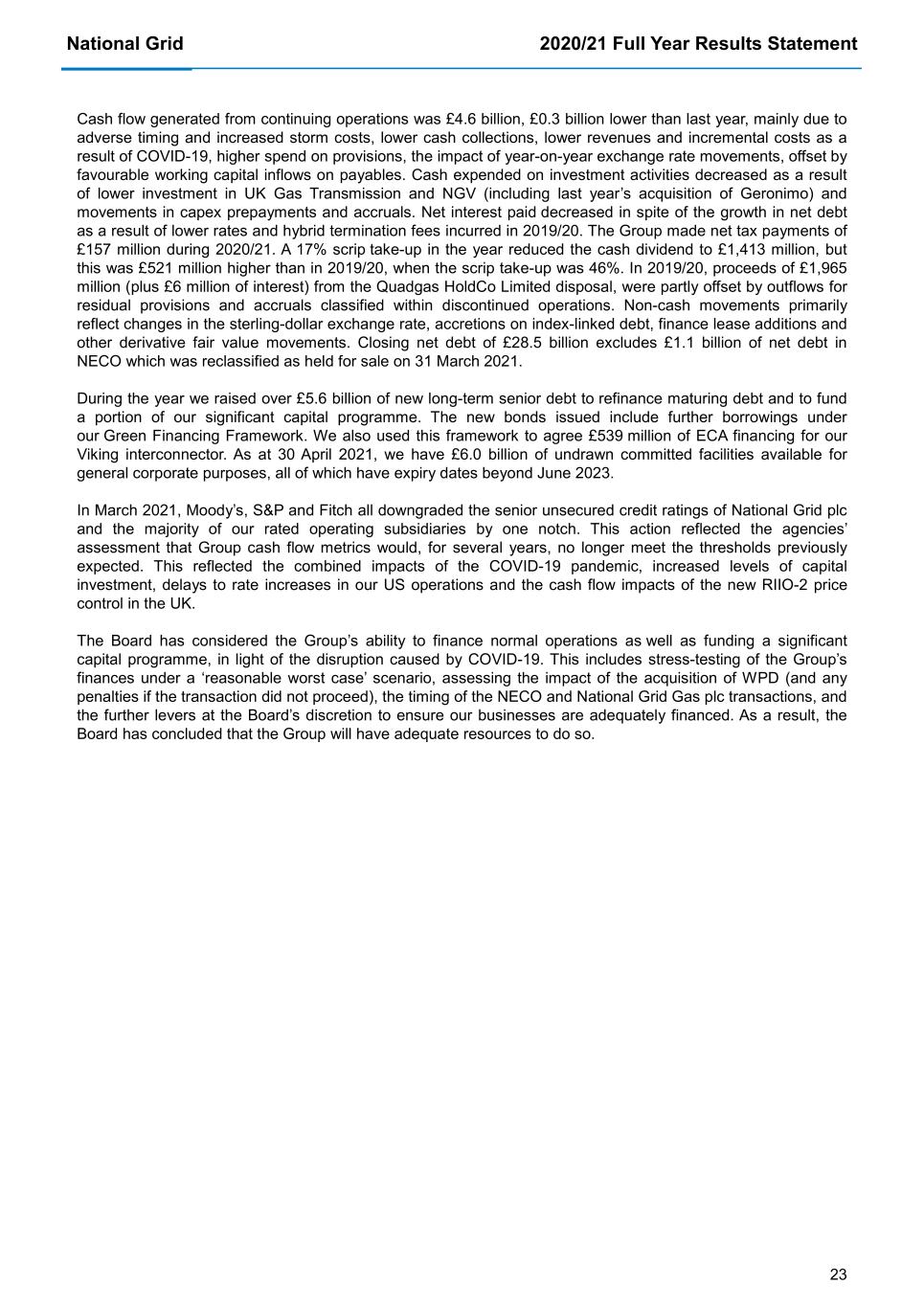
National Grid 2020/21 Full Year Results Statement 23 Cash flow generated from continuing operations was £4.6 billion, £0.3 billion lower than last year, mainly due to adverse timing and increased storm costs, lower cash collections, lower revenues and incremental costs as a result of COVID-19, higher spend on provisions, the impact of year-on-year exchange rate movements, offset by favourable working capital inflows on payables. Cash expended on investment activities decreased as a result of lower investment in UK Gas Transmission and NGV (including last year’s acquisition of Geronimo) and movements in capex prepayments and accruals. Net interest paid decreased in spite of the growth in net debt as a result of lower rates and hybrid termination fees incurred in 2019/20. The Group made net tax payments of £157 million during 2020/21. A 17% scrip take-up in the year reduced the cash dividend to £1,413 million, but this was £521 million higher than in 2019/20, when the scrip take-up was 46%. In 2019/20, proceeds of £1,965 million (plus £6 million of interest) from the Quadgas HoldCo Limited disposal, were partly offset by outflows for residual provisions and accruals classified within discontinued operations. Non-cash movements primarily reflect changes in the sterling-dollar exchange rate, accretions on index-linked debt, finance lease additions and other derivative fair value movements. Closing net debt of £28.5 billion excludes £1.1 billion of net debt in NECO which was reclassified as held for sale on 31 March 2021. During the year we raised over £5.6 billion of new long-term senior debt to refinance maturing debt and to fund a portion of our significant capital programme. The new bonds issued include further borrowings under our Green Financing Framework. We also used this framework to agree £539 million of ECA financing for our Viking interconnector. As at 30 April 2021, we have £6.0 billion of undrawn committed facilities available for general corporate purposes, all of which have expiry dates beyond June 2023. In March 2021, Moody’s, S&P and Fitch all downgraded the senior unsecured credit ratings of National Grid plc and the majority of our rated operating subsidiaries by one notch. This action reflected the agencies’ assessment that Group cash flow metrics would, for several years, no longer meet the thresholds previously expected. This reflected the combined impacts of the COVID-19 pandemic, increased levels of capital investment, delays to rate increases in our US operations and the cash flow impacts of the new RIIO-2 price control in the UK. The Board has considered the Group’s ability to finance normal operations as well as funding a significant capital programme, in light of the disruption caused by COVID-19. This includes stress-testing of the Group’s finances under a ‘reasonable worst case’ scenario, assessing the impact of the acquisition of WPD (and any penalties if the transaction did not proceed), the timing of the NECO and National Grid Gas plc transactions, and the further levers at the Board’s discretion to ensure our businesses are adequately financed. As a result, the Board has concluded that the Group will have adequate resources to do so.
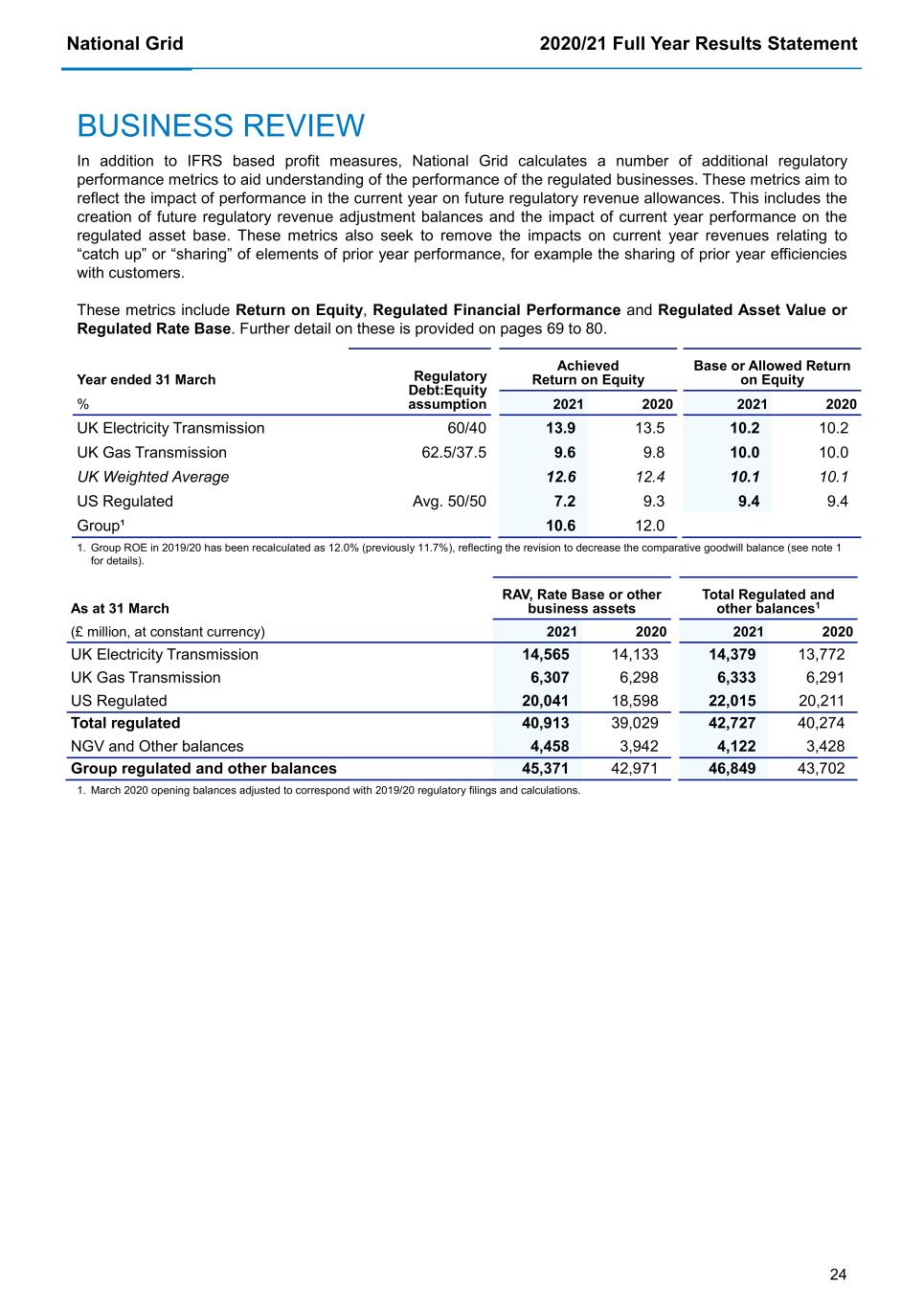
National Grid 2020/21 Full Year Results Statement 24 BUSINESS REVIEW In addition to IFRS based profit measures, National Grid calculates a number of additional regulatory performance metrics to aid understanding of the performance of the regulated businesses. These metrics aim to reflect the impact of performance in the current year on future regulatory revenue allowances. This includes the creation of future regulatory revenue adjustment balances and the impact of current year performance on the regulated asset base. These metrics also seek to remove the impacts on current year revenues relating to “catch up” or “sharing” of elements of prior year performance, for example the sharing of prior year efficiencies with customers. These metrics include Return on Equity, Regulated Financial Performance and Regulated Asset Value or Regulated Rate Base. Further detail on these is provided on pages 69 to 80. Year ended 31 March Regulatory Debt:Equity assumption Achieved Return on Equity Base or Allowed Return on Equity % 2021 2020 2021 2020 UK Electricity Transmission 60/40 13.9 13.5 10.2 10.2 UK Gas Transmission 62.5/37.5 9.6 9.8 10.0 10.0 UK Weighted Average 12.6 12.4 10.1 10.1 US Regulated Avg. 50/50 7.2 9.3 9.4 9.4 Group¹ 10.6 12.0 1. Group ROE in 2019/20 has been recalculated as 12.0% (previously 11.7%), reflecting the revision to decrease the comparative goodwill balance (see note 1 for details). As at 31 March RAV, Rate Base or other business assets Total Regulated and other balances1 (£ million, at constant currency) 2021 2020 2021 2020 UK Electricity Transmission 14,565 14,133 14,379 13,772 UK Gas Transmission 6,307 6,298 6,333 6,291 US Regulated 20,041 18,598 22,015 20,211 Total regulated 40,913 39,029 42,727 40,274 NGV and Other balances 4,458 3,942 4,122 3,428 Group regulated and other balances 45,371 42,971 46,849 43,702 1. March 2020 opening balances adjusted to correspond with 2019/20 regulatory filings and calculations.
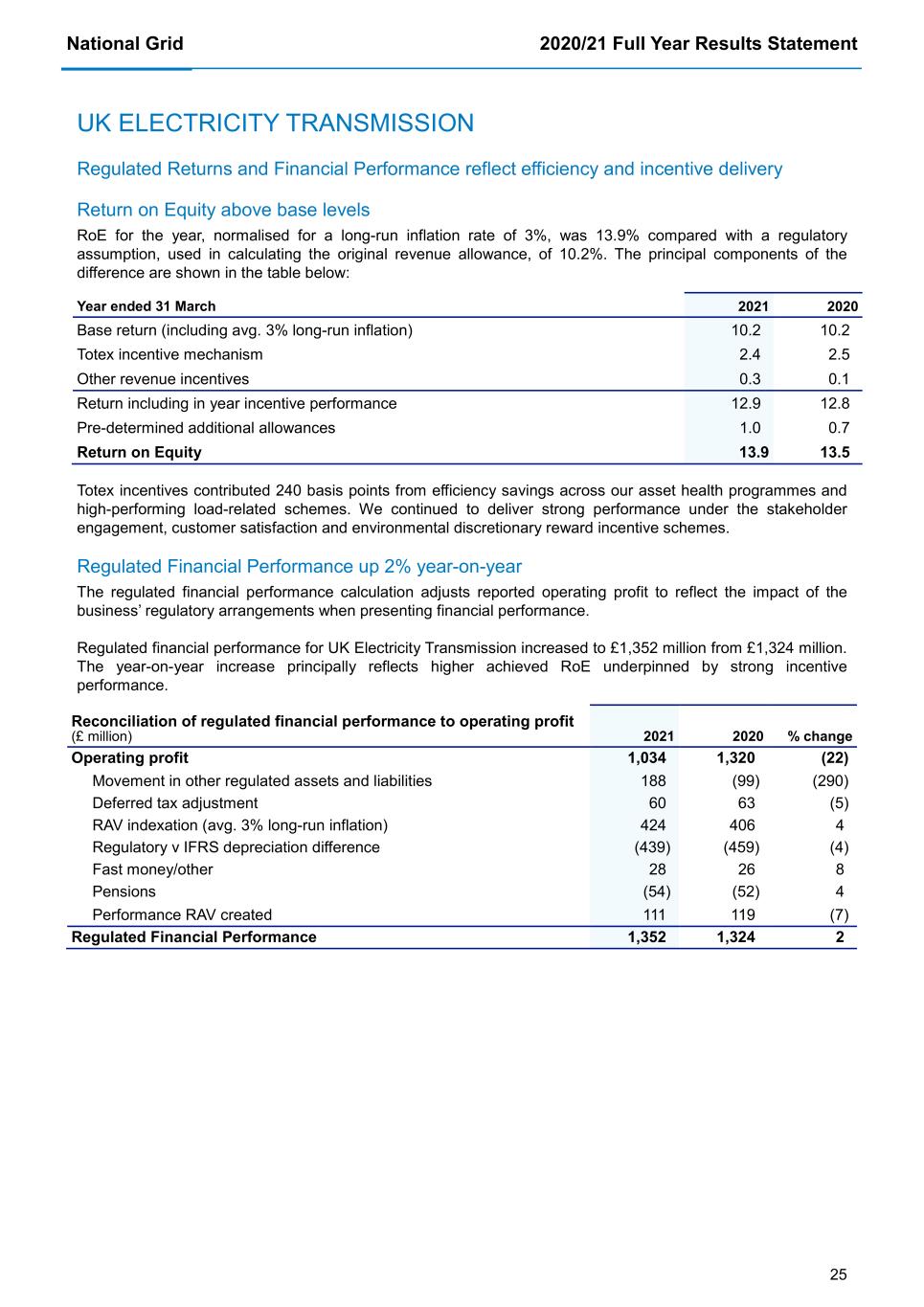
National Grid 2020/21 Full Year Results Statement 25 UK ELECTRICITY TRANSMISSION Regulated Returns and Financial Performance reflect efficiency and incentive delivery Return on Equity above base levels RoE for the year, normalised for a long-run inflation rate of 3%, was 13.9% compared with a regulatory assumption, used in calculating the original revenue allowance, of 10.2%. The principal components of the difference are shown in the table below: Year ended 31 March 2021 2020 Base return (including avg. 3% long-run inflation) 10.2 10.2 Totex incentive mechanism 2.4 2.5 Other revenue incentives 0.3 0.1 Return including in year incentive performance 12.9 12.8 Pre-determined additional allowances 1.0 0.7 Return on Equity 13.9 13.5 Totex incentives contributed 240 basis points from efficiency savings across our asset health programmes and high-performing load-related schemes. We continued to deliver strong performance under the stakeholder engagement, customer satisfaction and environmental discretionary reward incentive schemes. Regulated Financial Performance up 2% year-on-year The regulated financial performance calculation adjusts reported operating profit to reflect the impact of the business’ regulatory arrangements when presenting financial performance. Regulated financial performance for UK Electricity Transmission increased to £1,352 million from £1,324 million. The year-on-year increase principally reflects higher achieved RoE underpinned by strong incentive performance. Reconciliation of regulated financial performance to operating profit (£ million) 2021 2020 % change Operating profit 1,034 1,320 (22) Movement in other regulated assets and liabilities 188 (99) (290) Deferred tax adjustment 60 63 (5) RAV indexation (avg. 3% long-run inflation) 424 406 4 Regulatory v IFRS depreciation difference (439) (459) (4) Fast money/other 28 26 8 Pensions (54) (52) 4 Performance RAV created 111 119 (7) Regulated Financial Performance 1,352 1,324 2
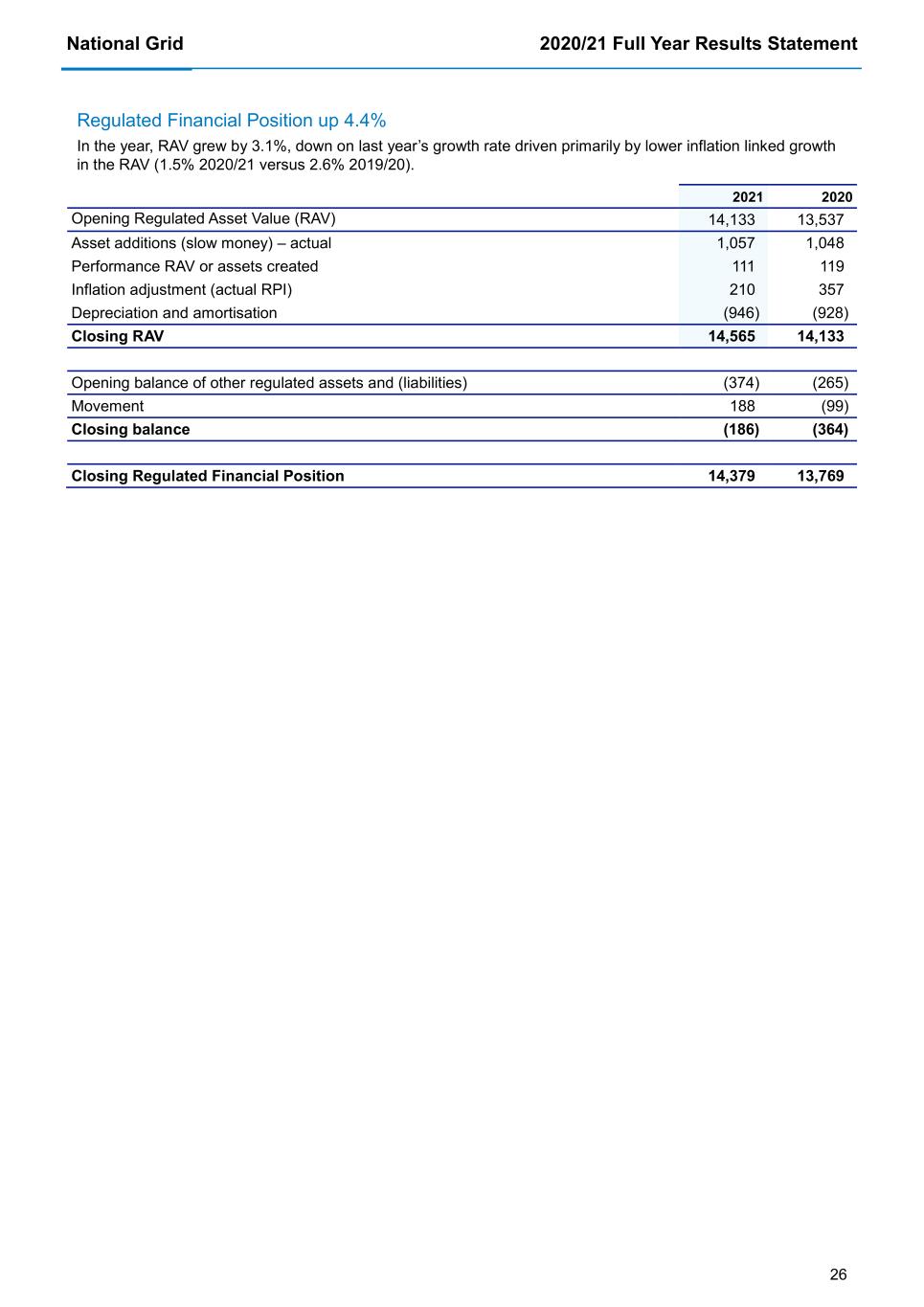
National Grid 2020/21 Full Year Results Statement 26 Regulated Financial Position up 4.4% In the year, RAV grew by 3.1%, down on last year’s growth rate driven primarily by lower inflation linked growth in the RAV (1.5% 2020/21 versus 2.6% 2019/20). 2021 2020 Opening Regulated Asset Value (RAV) 14,133 13,537 Asset additions (slow money) – actual 1,057 1,048 Performance RAV or assets created 111 119 Inflation adjustment (actual RPI) 210 357 Depreciation and amortisation (946) (928) Closing RAV 14,565 14,133 Opening balance of other regulated assets and (liabilities) (374) (265) Movement 188 (99) Closing balance (186) (364) Closing Regulated Financial Position 14,379 13,769
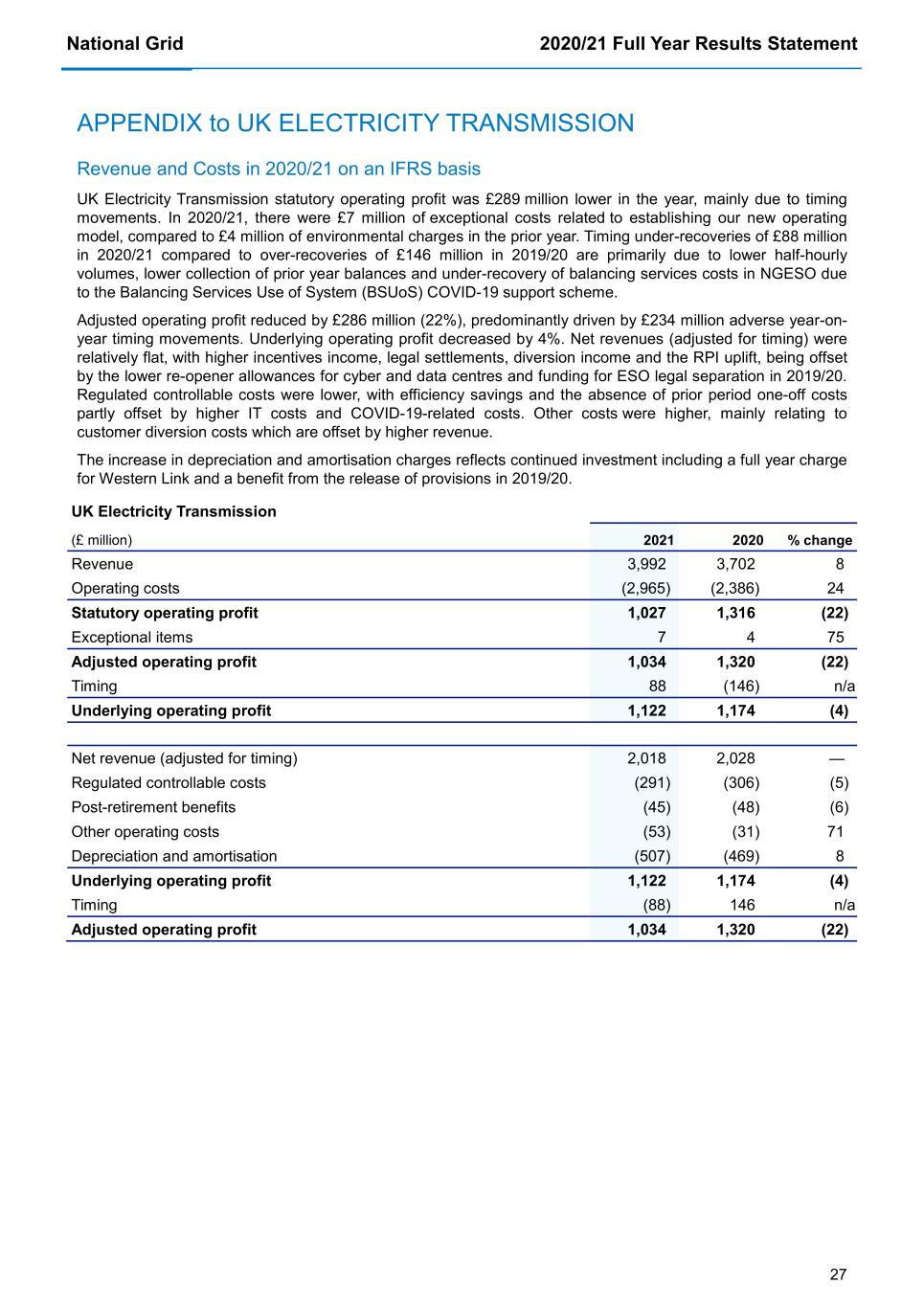
National Grid 2020/21 Full Year Results Statement 27 APPENDIX to UK ELECTRICITY TRANSMISSION Revenue and Costs in 2020/21 on an IFRS basis UK Electricity Transmission statutory operating profit was £289 million lower in the year, mainly due to timing movements. In 2020/21, there were £7 million of exceptional costs related to establishing our new operating model, compared to £4 million of environmental charges in the prior year. Timing under-recoveries of £88 million in 2020/21 compared to over-recoveries of £146 million in 2019/20 are primarily due to lower half-hourly volumes, lower collection of prior year balances and under-recovery of balancing services costs in NGESO due to the Balancing Services Use of System (BSUoS) COVID-19 support scheme. Adjusted operating profit reduced by £286 million (22%), predominantly driven by £234 million adverse year-on- year timing movements. Underlying operating profit decreased by 4%. Net revenues (adjusted for timing) were relatively flat, with higher incentives income, legal settlements, diversion income and the RPI uplift, being offset by the lower re-opener allowances for cyber and data centres and funding for ESO legal separation in 2019/20. Regulated controllable costs were lower, with efficiency savings and the absence of prior period one-off costs partly offset by higher IT costs and COVID-19-related costs. Other costs were higher, mainly relating to customer diversion costs which are offset by higher revenue. The increase in depreciation and amortisation charges reflects continued investment including a full year charge for Western Link and a benefit from the release of provisions in 2019/20. UK Electricity Transmission (£ million) 2021 2020 % change Revenue 3,992 3,702 8 Operating costs (2,965) (2,386) 24 Statutory operating profit 1,027 1,316 (22) Exceptional items 7 4 75 Adjusted operating profit 1,034 1,320 (22) Timing 88 (146) n/a Underlying operating profit 1,122 1,174 (4) Net revenue (adjusted for timing) 2,018 2,028 — Regulated controllable costs (291) (306) (5) Post-retirement benefits (45) (48) (6) Other operating costs (53) (31) 71 Depreciation and amortisation (507) (469) 8 Underlying operating profit 1,122 1,174 (4) Timing (88) 146 n/a Adjusted operating profit 1,034 1,320 (22)
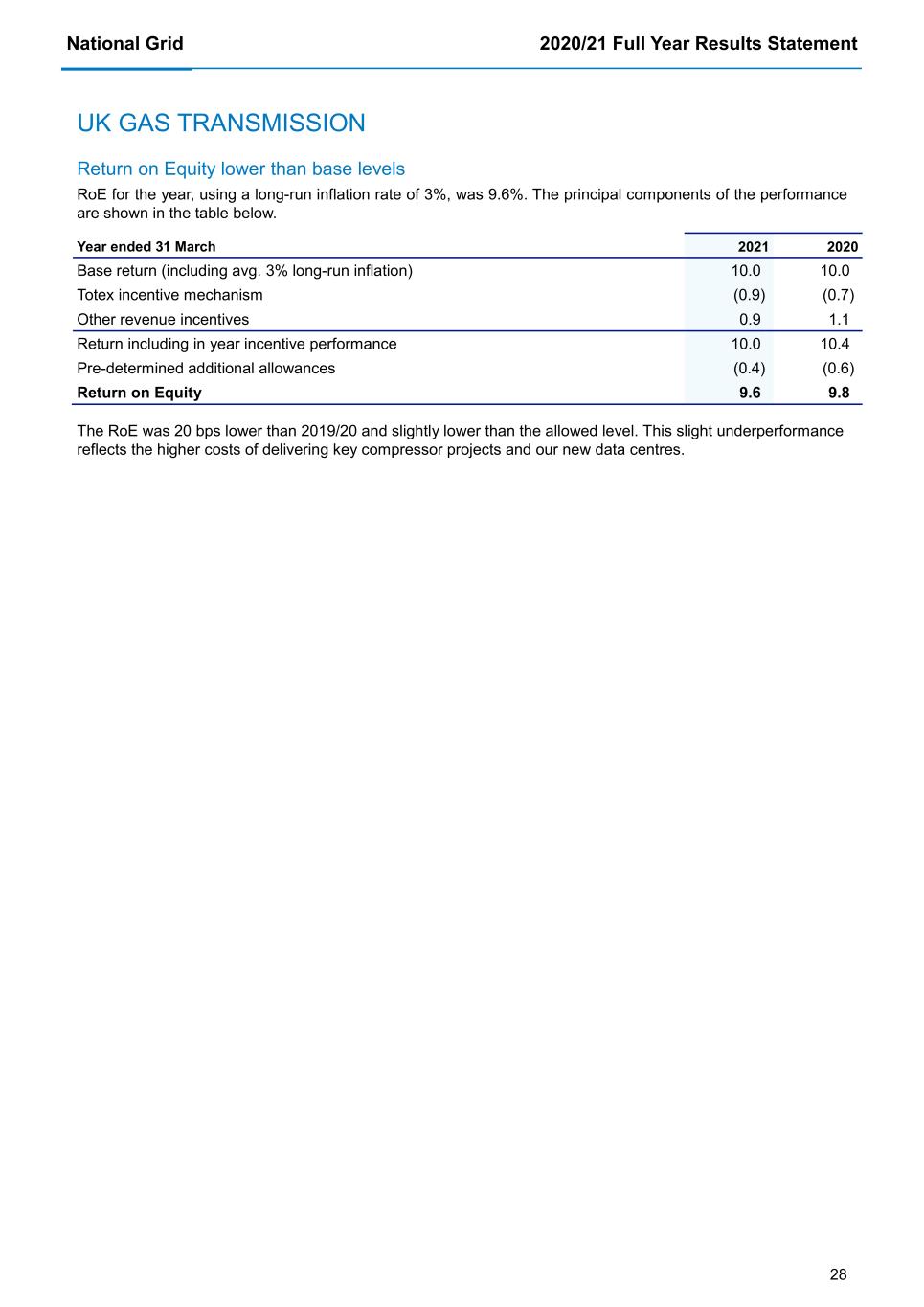
National Grid 2020/21 Full Year Results Statement 28 UK GAS TRANSMISSION Return on Equity lower than base levels RoE for the year, using a long-run inflation rate of 3%, was 9.6%. The principal components of the performance are shown in the table below. Year ended 31 March 2021 2020 Base return (including avg. 3% long-run inflation) 10.0 10.0 Totex incentive mechanism (0.9) (0.7) Other revenue incentives 0.9 1.1 Return including in year incentive performance 10.0 10.4 Pre-determined additional allowances (0.4) (0.6) Return on Equity 9.6 9.8 The RoE was 20 bps lower than 2019/20 and slightly lower than the allowed level. This slight underperformance reflects the higher costs of delivering key compressor projects and our new data centres.

National Grid 2020/21 Full Year Results Statement 29 Regulated Financial Performance down 3% year-on-year The regulated financial performance calculation adjusts reported operating profit to reflect the impact of the business’ regulatory arrangements when presenting financial performance. Regulated financial performance for UK Gas Transmission was lower than prior year at £457 million principally reflects lower RoE performance driven by higher cost to deliver key capital projects and lower incentive performance as a result of higher gas prices. Reconciliation of regulated financial performance to operating profit (£ million) 2021 2020 % change Operating profit 342 348 (2) Movement in other regulated assets and liabilities 34 67 (49) Deferred tax adjustment 12 25 (52) RAV indexation (3% long-run avg.) 189 185 2 Regulatory v IFRS depreciation difference (88) (77) 14 Fast money/other 25 (17) (247) Pensions (34) (34) — Performance RAV created (23) (24) (4) Regulated Financial Performance 457 473 (3) Regulated Financial Position increased 0.4% In the year, RAV growth was broadly flat compared to 2.3% in 2019/20. The reduction in growth reflects lower capital expenditure and lower inflation linked growth in the RAV. £ million 2021 2020 Opening Regulated Asset Value (RAV) 6,298 6,155 Asset additions (slow money) actual 193 253 Performance RAV or assets created (23) (24) Inflation adjustment (actual RPI) 92 162 Depreciation and amortisation (253) (248) Closing RAV 6,307 6,298 Opening balance of other regulated assets and (liabilities) (8) (60) Movement 34 67 Closing balance 26 7 Closing Regulated Financial Position 6,333 6,305
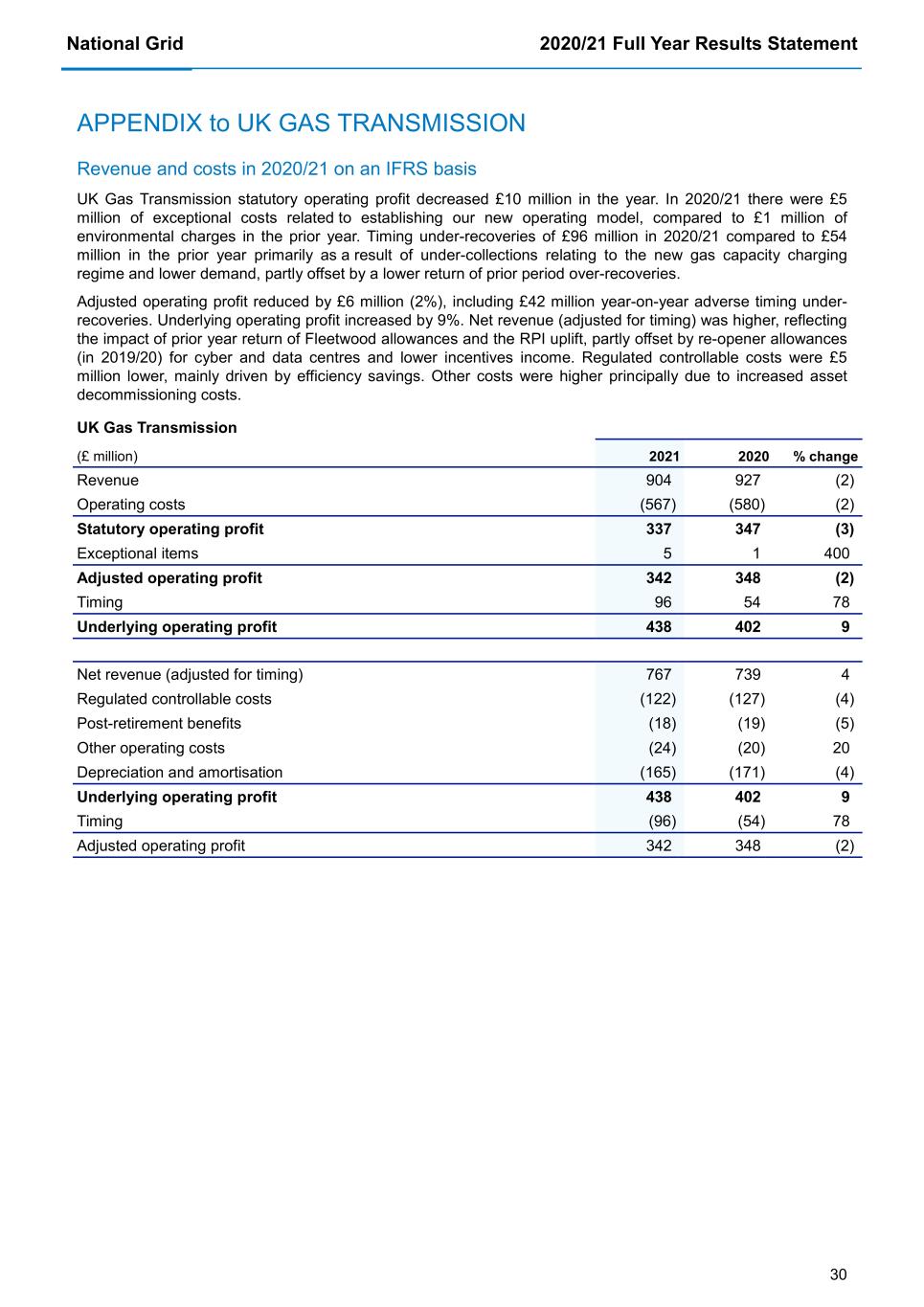
National Grid 2020/21 Full Year Results Statement 30 APPENDIX to UK GAS TRANSMISSION Revenue and costs in 2020/21 on an IFRS basis UK Gas Transmission statutory operating profit decreased £10 million in the year. In 2020/21 there were £5 million of exceptional costs related to establishing our new operating model, compared to £1 million of environmental charges in the prior year. Timing under-recoveries of £96 million in 2020/21 compared to £54 million in the prior year primarily as a result of under-collections relating to the new gas capacity charging regime and lower demand, partly offset by a lower return of prior period over-recoveries. Adjusted operating profit reduced by £6 million (2%), including £42 million year-on-year adverse timing under- recoveries. Underlying operating profit increased by 9%. Net revenue (adjusted for timing) was higher, reflecting the impact of prior year return of Fleetwood allowances and the RPI uplift, partly offset by re-opener allowances (in 2019/20) for cyber and data centres and lower incentives income. Regulated controllable costs were £5 million lower, mainly driven by efficiency savings. Other costs were higher principally due to increased asset decommissioning costs. UK Gas Transmission (£ million) 2021 2020 % change Revenue 904 927 (2) Operating costs (567) (580) (2) Statutory operating profit 337 347 (3) Exceptional items 5 1 400 Adjusted operating profit 342 348 (2) Timing 96 54 78 Underlying operating profit 438 402 9 Net revenue (adjusted for timing) 767 739 4 Regulated controllable costs (122) (127) (4) Post-retirement benefits (18) (19) (5) Other operating costs (24) (20) 20 Depreciation and amortisation (165) (171) (4) Underlying operating profit 438 402 9 Timing (96) (54) 78 Adjusted operating profit 342 348 (2)
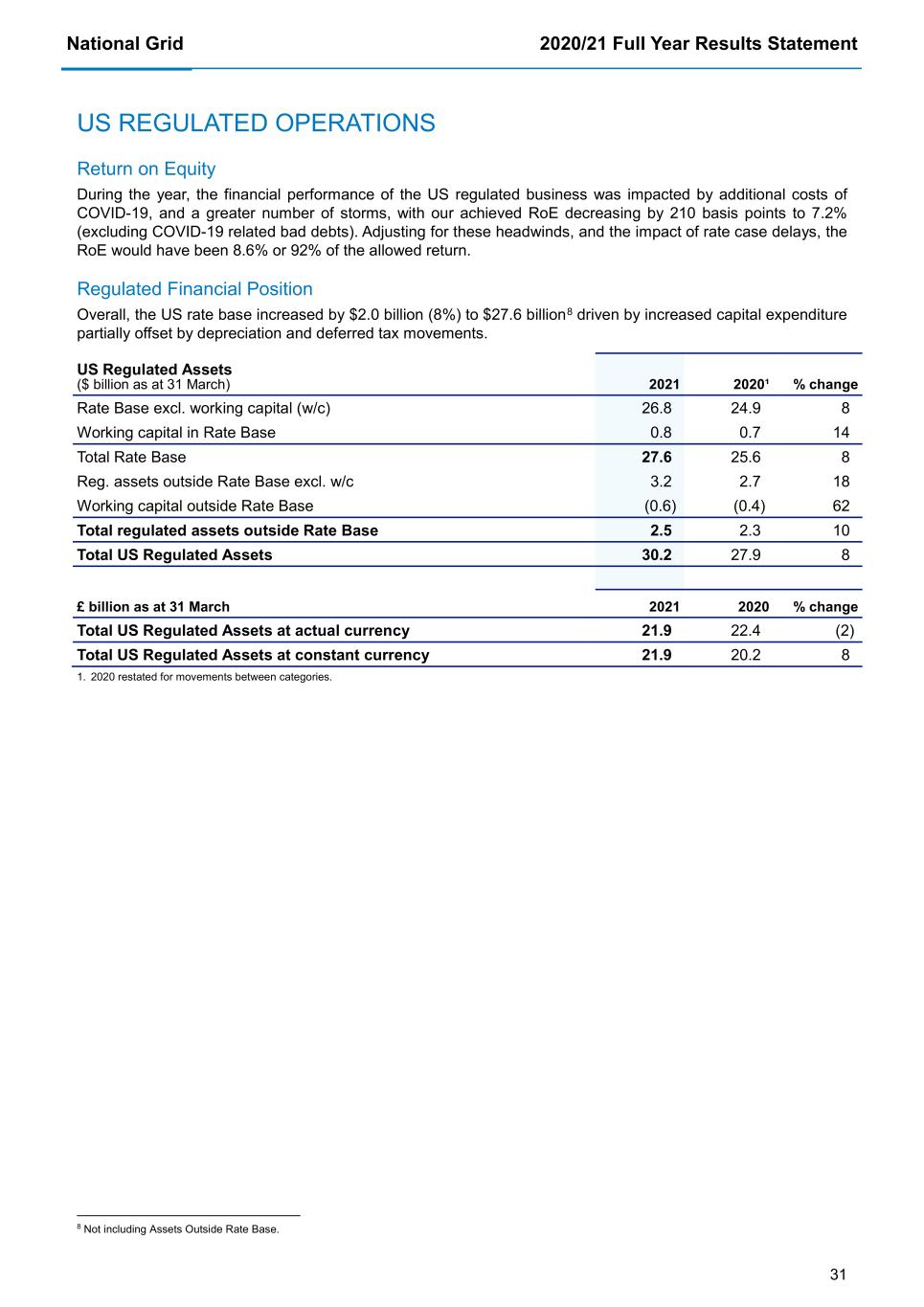
National Grid 2020/21 Full Year Results Statement 31 US REGULATED OPERATIONS Return on Equity During the year, the financial performance of the US regulated business was impacted by additional costs of COVID-19, and a greater number of storms, with our achieved RoE decreasing by 210 basis points to 7.2% (excluding COVID-19 related bad debts). Adjusting for these headwinds, and the impact of rate case delays, the RoE would have been 8.6% or 92% of the allowed return. Regulated Financial Position Overall, the US rate base increased by $2.0 billion (8%) to $27.6 billion8 driven by increased capital expenditure partially offset by depreciation and deferred tax movements. US Regulated Assets ($ billion as at 31 March) 2021 2020¹ % change Rate Base excl. working capital (w/c) 26.8 24.9 8 Working capital in Rate Base 0.8 0.7 14 Total Rate Base 27.6 25.6 8 Reg. assets outside Rate Base excl. w/c 3.2 2.7 18 Working capital outside Rate Base (0.6) (0.4) 62 Total regulated assets outside Rate Base 2.5 2.3 10 Total US Regulated Assets 30.2 27.9 8 £ billion as at 31 March 2021 2020 % change Total US Regulated Assets at actual currency 21.9 22.4 (2) Total US Regulated Assets at constant currency 21.9 20.2 8 1. 2020 restated for movements between categories. 8 Not including Assets Outside Rate Base.
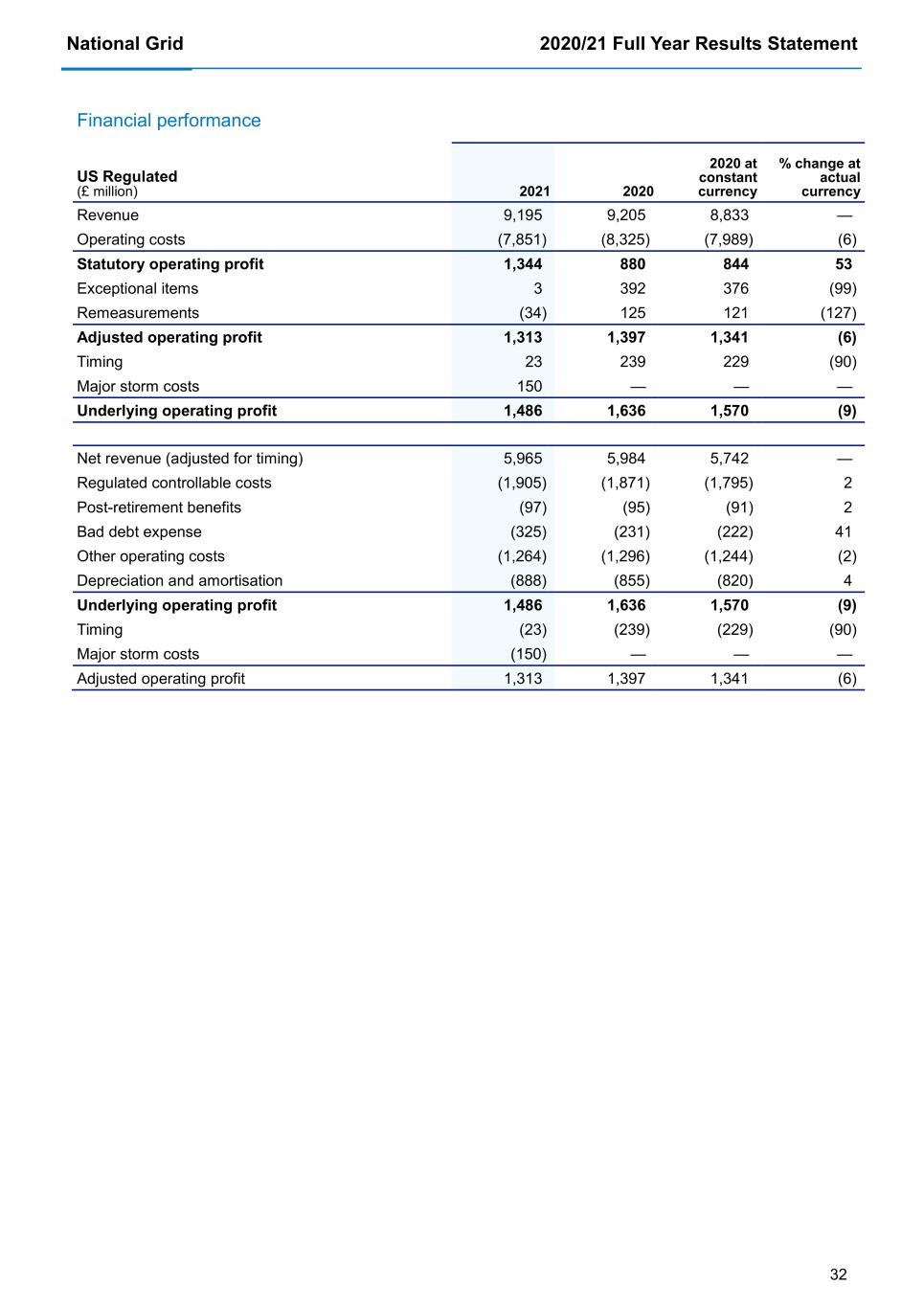
National Grid 2020/21 Full Year Results Statement 32 Financial performance US Regulated (£ million) 2021 2020 2020 at constant currency % change at actual currency Revenue 9,195 9,205 8,833 — Operating costs (7,851) (8,325) (7,989) (6) Statutory operating profit 1,344 880 844 53 Exceptional items 3 392 376 (99) Remeasurements (34) 125 121 (127) Adjusted operating profit 1,313 1,397 1,341 (6) Timing 23 239 229 (90) Major storm costs 150 — — — Underlying operating profit 1,486 1,636 1,570 (9) Net revenue (adjusted for timing) 5,965 5,984 5,742 — Regulated controllable costs (1,905) (1,871) (1,795) 2 Post-retirement benefits (97) (95) (91) 2 Bad debt expense (325) (231) (222) 41 Other operating costs (1,264) (1,296) (1,244) (2) Depreciation and amortisation (888) (855) (820) 4 Underlying operating profit 1,486 1,636 1,570 (9) Timing (23) (239) (229) (90) Major storm costs (150) — — — Adjusted operating profit 1,313 1,397 1,341 (6)

National Grid 2020/21 Full Year Results Statement 33 US Regulated statutory operating profit increased by £464 million, partly as a result of the £159 million year-on- year favourable movements in commodity contract remeasurements and adverse exchange rate movements, but mainly from the non-recurrence of exceptional charges booked in the prior year. In 2020/21, exceptional charges were lower comprising £17 million of costs related to establishing our new operating model and transaction costs, mostly offset by a £14 million environmental credit (reversal of cost previously booked as exceptional). In 2019/20, £392 million of exceptional charges were incurred for environmental costs related to the clean up of former manufacturing gas plant facilities. Timing under-recoveries of £23 million in 2020/21 compared to timing under-recoveries of £239 million in 2019/20, driven by revenue decoupling, commodity recoveries, partly offset by a higher return of NYSERDA and transmission wheeling prior period balances. Storm costs (deferrable and non-deferrable) were £142 million higher year on year. These factors, along with an adverse impact from COVID-19 disruption and a weaker US dollar, resulted in an overall increase in statutory operating profit, but a decrease in adjusted operating profit. Adjusted operating profit decreased by £84 million (6%), despite £216 million year-on-year favourable timing under-recoveries. in 2020/21, we experienced higher total storm costs compared to 2019/20. In 2020/21, we incurred £150 million of deferrable storm costs, which exceeded our $100 million threshold to qualified as major and be excluded from our underlying results. In 2019/20 we incurred £76 million of deferrable storm costs, which fell below this threshold. Underlying operating profit decreased by 9%. Net revenues (adjusted for timing) increased by £223 million (at constant currency) from the benefits of rate case increments (including Niagara Mohawk and Mass Electric), capital trackers and higher revenues in wholesale networks, but were offset by a £242 million adverse impact from foreign exchange movements. A weaker US dollar decreased underlying operating profit by £66 million in the year. US Regulated controllable costs increased as a result of higher IT costs, inflation, incremental COVID-19 costs, partly offset by cost mitigations and efficiencies. Provisions for bad and doubtful debts increased by £94 million, driven by a further £179 million (2019/20: £117 million) additional provision for receivables related to the impact of COVID-19. Depreciation and amortisation increased due to the growth in assets. Other costs were higher due to increased property taxes and higher non-deferrable storm costs partly offset by lower cost of removal.
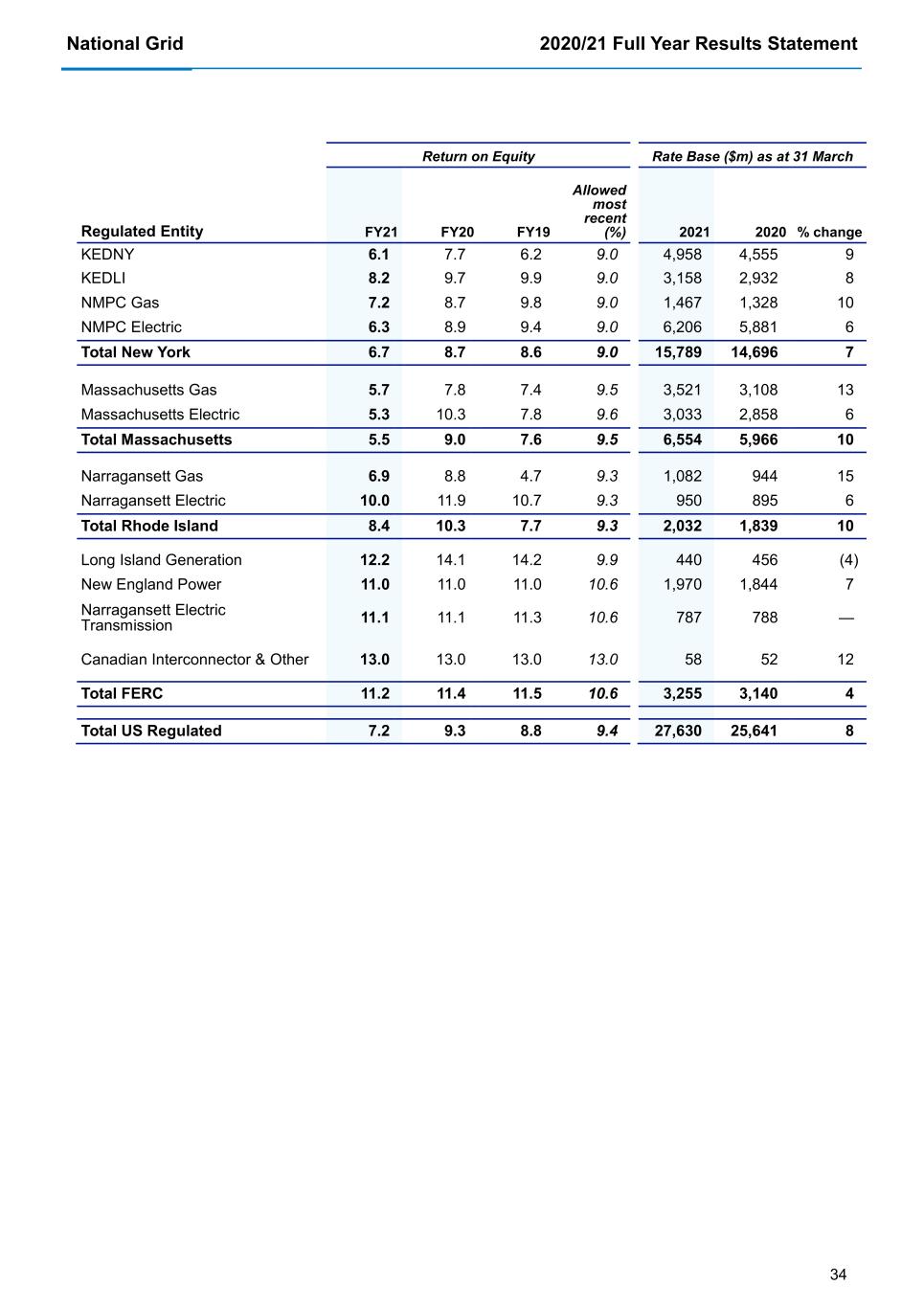
National Grid 2020/21 Full Year Results Statement 34 Return on Equity Rate Base ($m) as at 31 March Regulated Entity FY21 FY20 FY19 Allowed most recent (%) 2021 2020 % change KEDNY 6.1 7.7 6.2 9.0 4,958 4,555 9 KEDLI 8.2 9.7 9.9 9.0 3,158 2,932 8 NMPC Gas 7.2 8.7 9.8 9.0 1,467 1,328 10 NMPC Electric 6.3 8.9 9.4 9.0 6,206 5,881 6 Total New York 6.7 8.7 8.6 9.0 15,789 14,696 7 Massachusetts Gas 5.7 7.8 7.4 9.5 3,521 3,108 13 Massachusetts Electric 5.3 10.3 7.8 9.6 3,033 2,858 6 Total Massachusetts 5.5 9.0 7.6 9.5 6,554 5,966 10 Narragansett Gas 6.9 8.8 4.7 9.3 1,082 944 15 Narragansett Electric 10.0 11.9 10.7 9.3 950 895 6 Total Rhode Island 8.4 10.3 7.7 9.3 2,032 1,839 10 Long Island Generation 12.2 14.1 14.2 9.9 440 456 (4) New England Power 11.0 11.0 11.0 10.6 1,970 1,844 7 Narragansett Electric Transmission 11.1 11.1 11.3 10.6 787 788 — Canadian Interconnector & Other 13.0 13.0 13.0 13.0 58 52 12 Total FERC 11.2 11.4 11.5 10.6 3,255 3,140 4 Total US Regulated 7.2 9.3 8.8 9.4 27,630 25,641 8

National Grid 2020/21 Full Year Results Statement 35 NGV AND OTHER ACTIVITIES Operating profit Capital investment1 (£ million) 2021 2020 2020 at constant currency change % at constant currency 2021 2020 2020 at constant currency change % at constant currency Metering 154 158 158 (3) 27 41 41 (34) Interconnectors 60 61 61 (2) 378 498 498 (24) Grain LNG 104 78 78 33 20 7 7 186 NG Renewables (18) (9) (9) n/a — 123 115 n/a Other (2) (19) (18) (89) 6 — — — Total NGV 298 269 270 10 431 669 661 (35) Property 22 63 63 (65) 19 4 4 375 NG Partners 1 (11) (11) (109) 35 50 48 (27) Corporate and other activities (84) (79) (79) 6 10 5 5 100 Total Other (61) (27) (27) 126 64 59 57 12 Total NGV and Other 237 242 243 (2) 495 728 718 (31) 1. Excluding investment in joint ventures and associates. Joint ventures and associates Share of post-tax results Capital investment (£ million) 2021 2020 2020 at constant currency change % at constant currency 2021 2020 2020 at constant currency change % at constant currency Interconnectors 26 29 29 (10) — — — — Millennium 22 22 21 5 — — — — Sunrun — 13 13 (100) — — — n/a NG Renewables 5 1 1 n/a 72 127 120 n/a Other 3 2 2 50 6 19 18 (67) Total NGV 56 67 66 (15) 78 146 138 (43) NG Partners 5 3 3 67 3 11 11 (73) Other (including St William) 5 18 18 (72) — — — n/a Total Other 10 21 21 (52) 3 11 11 (73) Joint Ventures and Associates 66 88 87 (24) 81 157 149 (46)

National Grid 2020/21 Full Year Results Statement 36 NATIONAL GRID VENTURES National Grid Ventures’ statutory operating profits were £29 million higher than 2019/20, with lower depreciation driven by the extension of asset lives at our LNG import terminal at Grain, commencement of operations at our second interconnector (IFA2) between England and France and fair value gains in our US Ventures business. These were partly offset by lower prior year one-off benefits in our legacy French interconnector (IFA1), lower revenues from our declining meter population and a £2 million exceptional charge in relation to establishing our new operating model, compared to a £1 million charge for environmental costs in 2019/20. OTHER ACTIVITIES In ‘other’ activities, we incurred an exceptional charge of £25 million related to establishing our new operating model and £24 million of transaction costs for the acquisition of WPD and the sale of NECO, both expected to take place during 2021/22, compared to a £3 million charge for environmental costs in the prior year. In 2020/21, underlying operating profit included net costs of £61 million (including corporate costs), compared to £27 million in 2019/20. The underlying performance of the Property business was £41 million lower than prior year reflecting a lower volume of sales compared to 2019/20. National Grid Partners (NGP) NGP, our corporate investment and innovation arm, continued delivering for the Group during the year. As of 31 March 2021, NGP’s portfolio comprised investments in 23 companies and four funds at a fair value of £178 million. It invests in emerging technologies such as Artificial Intelligence (AI), Data Security and Cybersecurity, and embeds those innovations across our US and UK core operations, helping to improve National Grid’s performance. In collaboration with NGP portfolio company Urbint, for example, National Grid is using AI to focus our damage prevention resources with the potential to save millions of dollars annually in avoided damage and to minimise disruption to critical networks. Additionally, NGP launched the NextGrid Alliance (NGA), a consortium of over 65 utilities where best practices and technology innovations are shared across areas including modernising utility infrastructure and keeping power grids safe from cyber threats. Later this year, NGP will host its first NGA Summit in the UK as part of COP26. NGP will continue to deliver strategic and financial value to our core businesses and investing in valuable start- up technologies, tackling innovation and business development projects that can improve our company performance and acting as a catalyst for change across the broader Group.
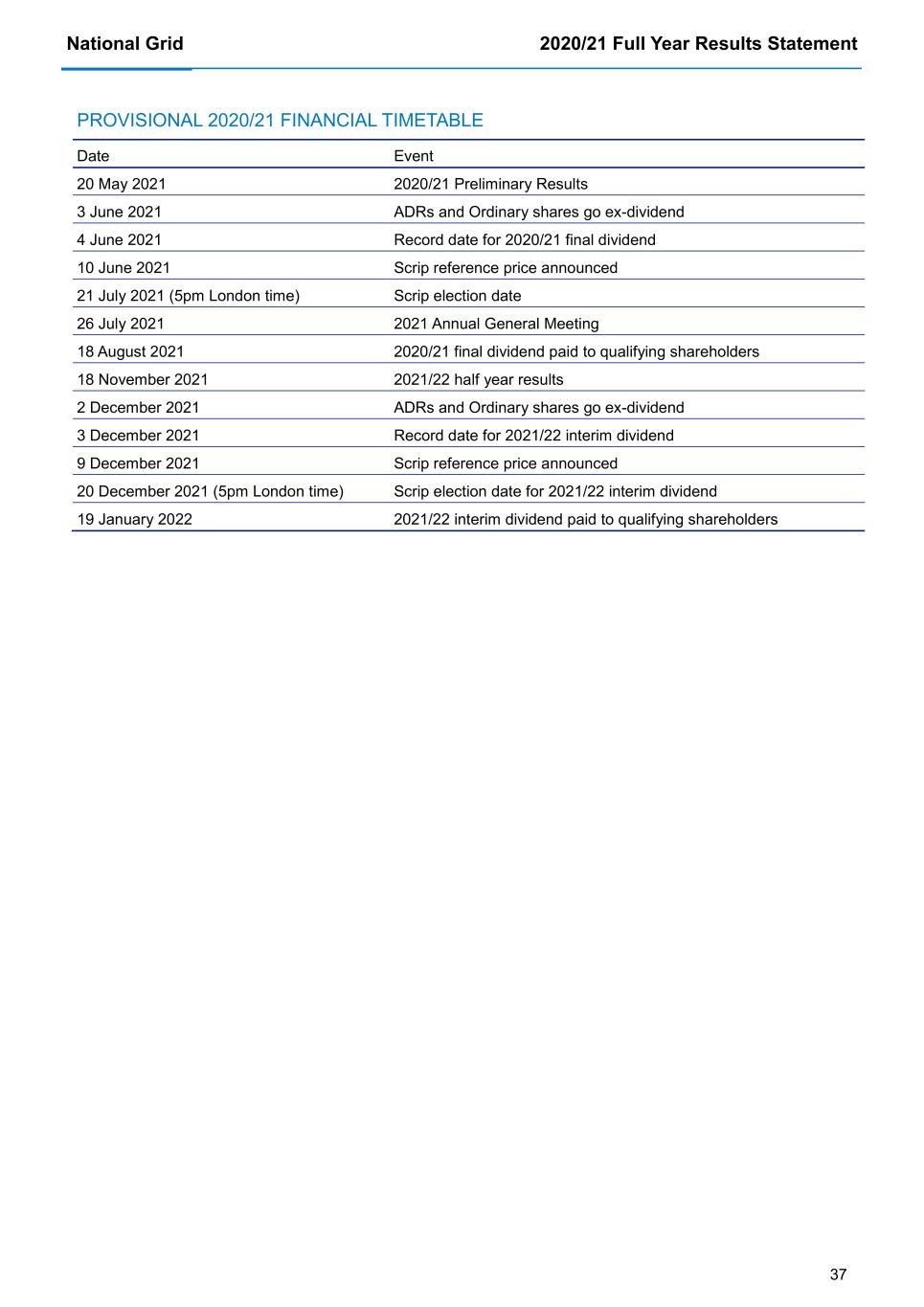
National Grid 2020/21 Full Year Results Statement 37 PROVISIONAL 2020/21 FINANCIAL TIMETABLE Date Event 20 May 2021 2020/21 Preliminary Results 3 June 2021 ADRs and Ordinary shares go ex-dividend 4 June 2021 Record date for 2020/21 final dividend 10 June 2021 Scrip reference price announced 21 July 2021 (5pm London time) Scrip election date 26 July 2021 2021 Annual General Meeting 18 August 2021 2020/21 final dividend paid to qualifying shareholders 18 November 2021 2021/22 half year results 2 December 2021 ADRs and Ordinary shares go ex-dividend 3 December 2021 Record date for 2021/22 interim dividend 9 December 2021 Scrip reference price announced 20 December 2021 (5pm London time) Scrip election date for 2021/22 interim dividend 19 January 2022 2021/22 interim dividend paid to qualifying shareholders

National Grid 2020/21 Full Year Results Statement 38 American Depositary Receipt (ADR) Deposit Agreement National Grid amended the deposit agreement under which the ADRs representing its ordinary shares are issued to allow a fee of up to $0.05 per ADR to be charged for any cash distribution made to ADR holders, including cash dividends. ADR holders who receive cash in relation to the 2020/21 final dividend will be charged a fee of $0.02 per ADR, by the Depositary prior to distribution of the cash dividend. CAUTIONARY STATEMENT This announcement contains certain statements that are neither reported financial results nor other historical information. These statements are forward-looking statements within the meaning of Section 27A of the Securities Act of 1933, as amended, and Section 21E of the Securities Exchange Act of 1934, as amended. These statements include information with respect to National Grid’s (the Company) financial condition, its results of operations and businesses, strategy, plans and objectives. Words such as ‘aims’, ‘anticipates’, ‘expects’, ‘should’, ‘intends’, ‘plans’, ‘believes’, ‘outlook’, ‘seeks’, ‘estimates’, ‘targets’, ‘may’, ‘will’, ‘continue’, ‘project’ and similar expressions, as well as statements in the future tense, identify forward-looking statements. These forward-looking statements are not guarantees of National Grid’s future performance and are subject to assumptions, risks and uncertainties that could cause actual future results to differ materially from those expressed in or implied by such forward-looking statements. Many of these assumptions, risks and uncertainties relate to factors that are beyond National Grid’s ability to control, predict or estimate precisely, such as the impact of COVID-19 on our operations, our employees, our counterparties, our funding and our regulatory and legal obligations, but also, more widely, changes in laws or regulations, including any arising as a result of the United Kingdom’s exit from the European Union, announcements from and decisions by governmental bodies or regulators, including the implementation of the RIIO-2 price controls as well as increased economic uncertainty following the COVID-19 pandemic; the timing of construction and delivery by third parties of new generation projects requiring connection; breaches of, or changes in, environmental, climate change and health and safety laws or regulations, including breaches or other incidents arising from the potentially harmful nature of its activities; network failure or interruption, the inability to carry out critical non network operations and damage to infrastructure, due to adverse weather conditions including the impact of major storms as well as the results of climate change, due to counterparties being unable to deliver physical commodities, or due to the failure of or unauthorised access to or deliberate breaches of National Grid’s IT systems and supporting technology; failure to adequately forecast and respond to disruptions in energy supply; performance against regulatory targets and standards and against National Grid’s peers with the aim of delivering stakeholder expectations regarding costs and efficiency savings; and customers and counterparties (including financial institutions) failing to perform their obligations to the Company. Other factors that could cause actual results to differ materially from those described in this announcement include fluctuations in exchange rates, interest rates and commodity price indices; restrictions and conditions (including filing requirements) in National Grid’s borrowing and debt arrangements, funding costs and access to financing; regulatory requirements for the Company to maintain financial resources in certain parts of its business and restrictions on some subsidiaries’ transactions such as paying dividends, lending or levying charges; the delayed timing of recoveries and payments in National Grid’s regulated businesses and whether aspects of its activities are contestable; the funding requirements and performance of National Grid’s pension schemes and other post-retirement benefit schemes; the failure to attract, develop and retain employees with the necessary competencies, including leadership skills, and any significant disputes arising with National Grid’s employees or the breach of laws or regulations by its employees; the failure to respond to market developments, including competition for onshore transmission; the threats and opportunities presented by emerging technology; the failure by the Company to respond to, or meet its own commitments as a leader in relation to, climate change development activities relating to energy transition, including the integration of distributed energy resources; and the need to grow the Company’s business to deliver its strategy, as well as incorrect or unforeseen assumptions or conclusions (including unanticipated costs and liabilities) relating to business development activity, including the acquisition of WPD, the sale of the Company’s Rhode Island gas and electricity business and the proposed sale of a majority stake in its UK gas transmission business. For further details regarding these and other assumptions, risks and uncertainties that may impact National Grid, please read the Strategic Report section and the ‘Risk factors’ on pages 227 to 230 of National Grid’s most recent Annual Report and Accounts as updated by National Grid’s unaudited half-year financial information for the six months ended 30 September 2020 published on 12 November 2020. In addition, new factors emerge from time to time and National Grid cannot assess the potential impact of any such factor on its activities or the extent to which any factor, or combination of factors, may cause actual future results to differ materially from those contained in any forward-looking statement. Except as may be required by law or regulation, the Company undertakes no obligation to update any of its forward-looking statements, which speak only as of the date of this announcement.

National Grid 2020/21 Full Year Results Statement 39 Consolidated income statement for the years ended 31 March 2021 Notes Before exceptional items and remeasurements £m Exceptional items and remeasurements (see note 4) £m Total £m Continuing operations Revenue 2(a),3 14,779 — 14,779 Provision for bad and doubtful debts (326) — (326) Other operating costs 4 (11,527) (31) (11,558) Operating profit/(loss) 2(b) 2,926 (31) 2,895 Finance income 4,5 35 23 58 Finance costs 4,5 (977) 49 (928) Share of post-tax results of joint ventures and associates 66 (8) 58 Profit before tax 2(b) 2,050 33 2,083 Tax 4,6 (416) (26) (442) Total profit for the year 1,634 7 1,641 Attributable to: Equity shareholders of the parent 1,633 7 1,640 Non-controlling interests from continuing operations 1 — 1 Earnings per share (pence) Basic earnings per share (continuing) 7 46.6 Diluted earnings per share (continuing) 7 46.3 Basic earnings per share (continuing and discontinued) 7 46.6 Diluted earnings per share (continuing and discontinued) 7 46.3

National Grid 2020/21 Full Year Results Statement 40 2020 Notes Before exceptional items and remeasurements £m Exceptional items and remeasurements (see note 4) £m Total £m Continuing operations Revenue 2(a),3 14,540 — 14,540 Provision for bad and doubtful debts (234) — (234) Other operating costs 4 (10,999) (527) (11,526) Operating profit/(loss) 2(b) 3,307 (527) 2,780 Finance income 4,5 70 (16) 54 Finance costs 4,5 (1,119) (48) (1,167) Share of post-tax results of joint ventures and associates 88 (1) 87 Profit/(loss) before tax 2(b) 2,346 (592) 1,754 Tax 4,6 (433) (47) (480) Profit/(loss) after tax from continuing operations 1,913 (639) 1,274 Profit/(loss) after tax from discontinued operations 5 (14) (9) Total profit/(loss) for the year (continuing and discontinued) 1,918 (653) 1,265 Attributable to: Equity shareholders of the parent 1,917 (653) 1,264 Non-controlling interests from continuing operations 1 — 1 Earnings per share (pence) Basic earnings per share (continuing) 7 36.8 Diluted earnings per share (continuing) 7 36.6 Basic earnings per share (continuing and discontinued) 7 36.5 Diluted earnings per share (continuing and discontinued) 7 36.3
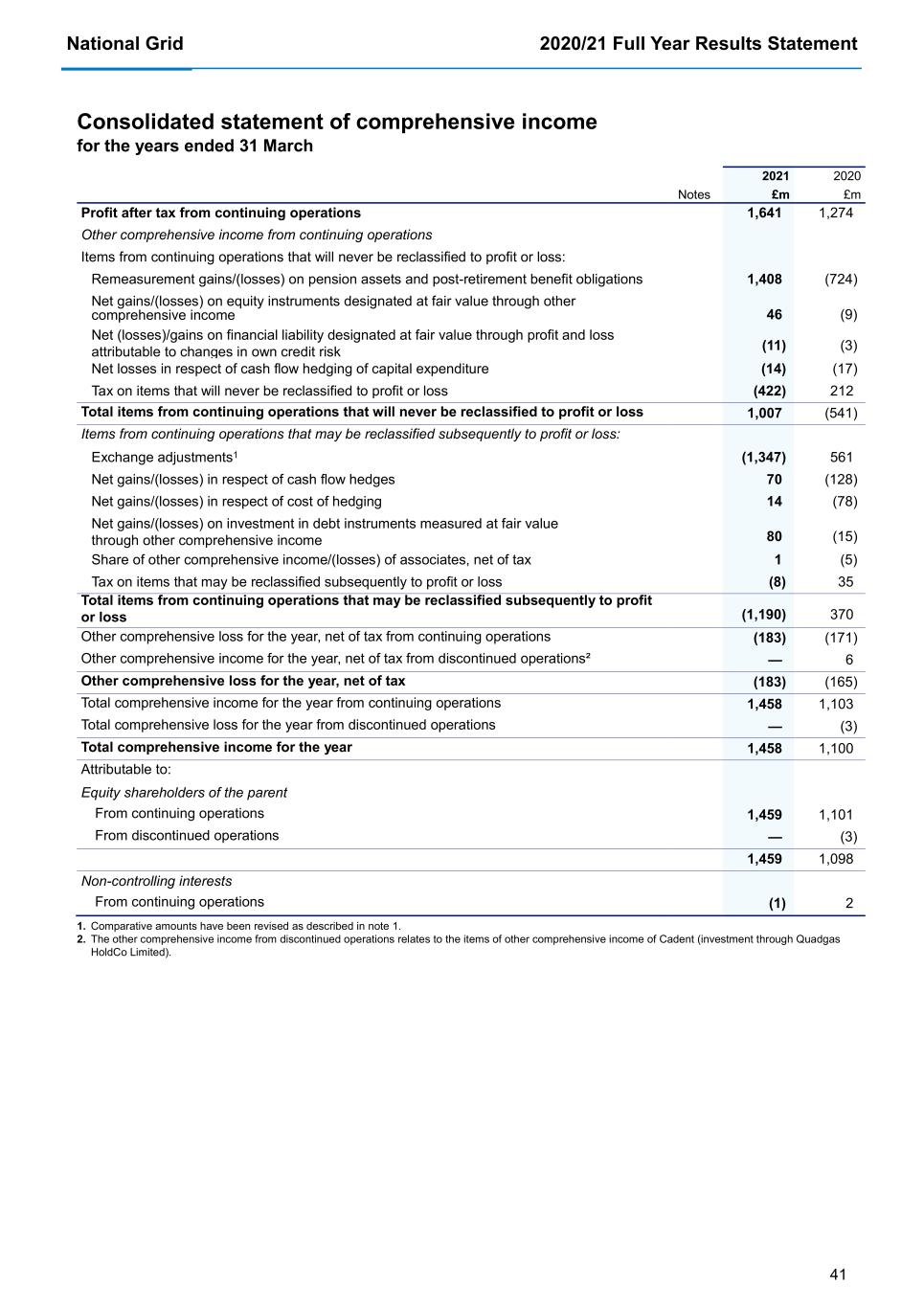
National Grid 2020/21 Full Year Results Statement 41 Consolidated statement of comprehensive income for the years ended 31 March 2021 2020 Notes £m £m Profit after tax from continuing operations 1,641 1,274 Other comprehensive income from continuing operations Items from continuing operations that will never be reclassified to profit or loss: Remeasurement gains/(losses) on pension assets and post-retirement benefit obligations 1,408 (724) Net gains/(losses) on equity instruments designated at fair value through other comprehensive income 46 (9) Net (losses)/gains on financial liability designated at fair value through profit and loss attributable to changes in own credit risk (11) (3) Net losses in respect of cash flow hedging of capital expenditure (14) (17) Tax on items that will never be reclassified to profit or loss (422) 212 Total items from continuing operations that will never be reclassified to profit or loss 1,007 (541) Items from continuing operations that may be reclassified subsequently to profit or loss: Exchange adjustments1 (1,347) 561 Net gains/(losses) in respect of cash flow hedges 70 (128) Net gains/(losses) in respect of cost of hedging 14 (78) Net gains/(losses) on investment in debt instruments measured at fair value through other comprehensive income 80 (15) Share of other comprehensive income/(losses) of associates, net of tax 1 (5) Tax on items that may be reclassified subsequently to profit or loss (8) 35 Total items from continuing operations that may be reclassified subsequently to profit or loss (1,190) 370 Other comprehensive loss for the year, net of tax from continuing operations (183) (171) Other comprehensive income for the year, net of tax from discontinued operations² — 6 Other comprehensive loss for the year, net of tax (183) (165) Total comprehensive income for the year from continuing operations 1,458 1,103 Total comprehensive loss for the year from discontinued operations — (3) Total comprehensive income for the year 1,458 1,100 Attributable to: Equity shareholders of the parent From continuing operations 1,459 1,101 From discontinued operations — (3) 1,459 1,098 Non-controlling interests From continuing operations (1) 2 1. Comparative amounts have been revised as described in note 1. 2. The other comprehensive income from discontinued operations relates to the items of other comprehensive income of Cadent (investment through Quadgas HoldCo Limited).
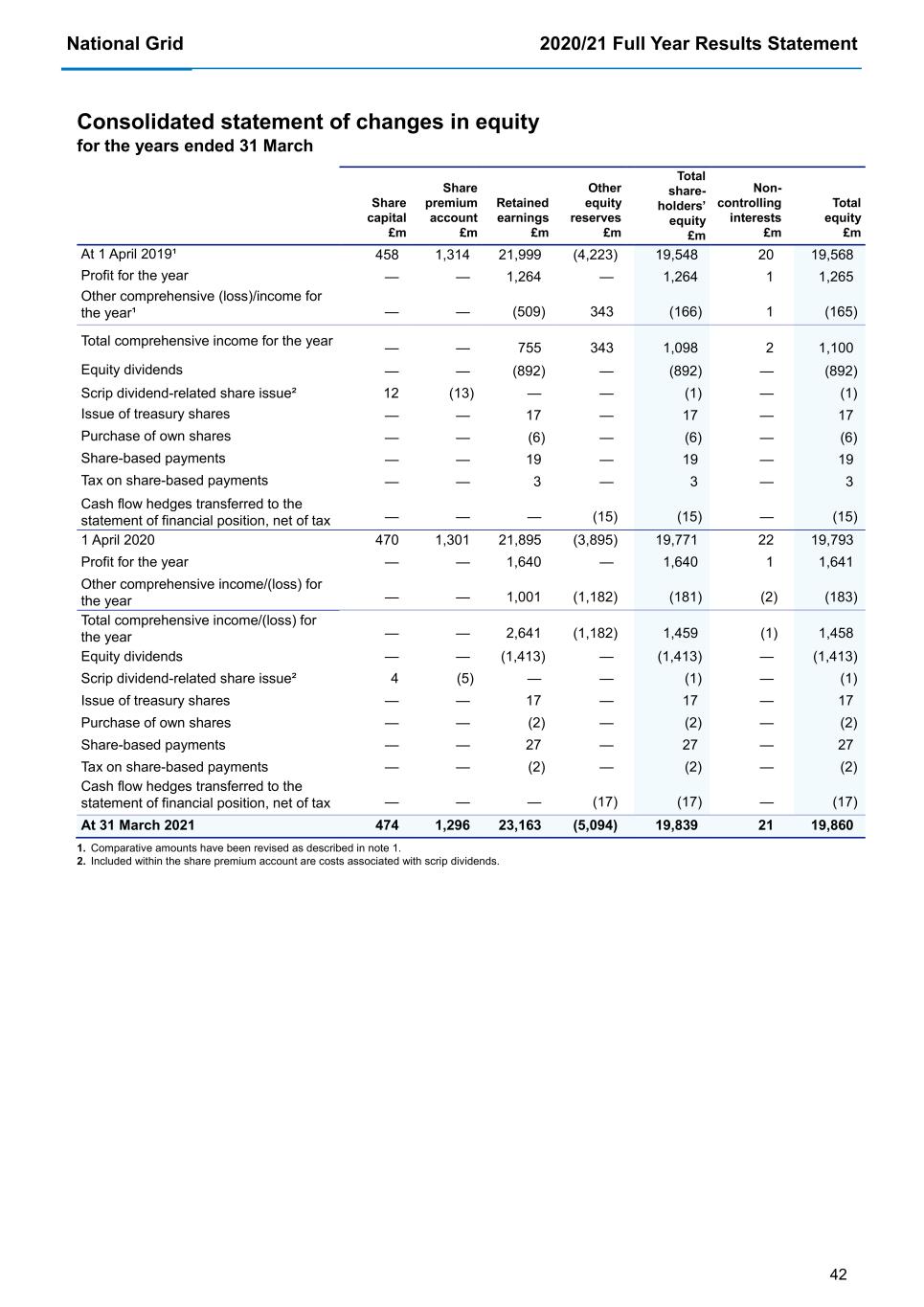
National Grid 2020/21 Full Year Results Statement 42 Consolidated statement of changes in equity for the years ended 31 March Share capital £m Share premium account £m Retained earnings £m Other equity reserves £m Total share- holders’ equity £m Non- controlling interests £m Total equity £m At 1 April 2019¹ 458 1,314 21,999 (4,223) 19,548 20 19,568 Profit for the year — — 1,264 — 1,264 1 1,265 Other comprehensive (loss)/income for the year¹ — — (509) 343 (166) 1 (165) Total comprehensive income for the year — — 755 343 1,098 2 1,100 Equity dividends — — (892) — (892) — (892) Scrip dividend-related share issue² 12 (13) — — (1) — (1) Issue of treasury shares — — 17 — 17 — 17 Purchase of own shares — — (6) — (6) — (6) Share-based payments — — 19 — 19 — 19 Tax on share-based payments — — 3 — 3 — 3 Cash flow hedges transferred to the statement of financial position, net of tax — — — (15) (15) — (15) 1 April 2020 470 1,301 21,895 (3,895) 19,771 22 19,793 Profit for the year — — 1,640 — 1,640 1 1,641 Other comprehensive income/(loss) for the year — — 1,001 (1,182) (181) (2) (183) Total comprehensive income/(loss) for the year — — 2,641 (1,182) 1,459 (1) 1,458 Equity dividends — — (1,413) — (1,413) — (1,413) Scrip dividend-related share issue² 4 (5) — — (1) — (1) Issue of treasury shares — — 17 — 17 — 17 Purchase of own shares — — (2) — (2) — (2) Share-based payments — — 27 — 27 — 27 Tax on share-based payments — — (2) — (2) — (2) Cash flow hedges transferred to the statement of financial position, net of tax — — — (17) (17) — (17) At 31 March 2021 474 1,296 23,163 (5,094) 19,839 21 19,860 1. Comparative amounts have been revised as described in note 1. 2. Included within the share premium account are costs associated with scrip dividends.
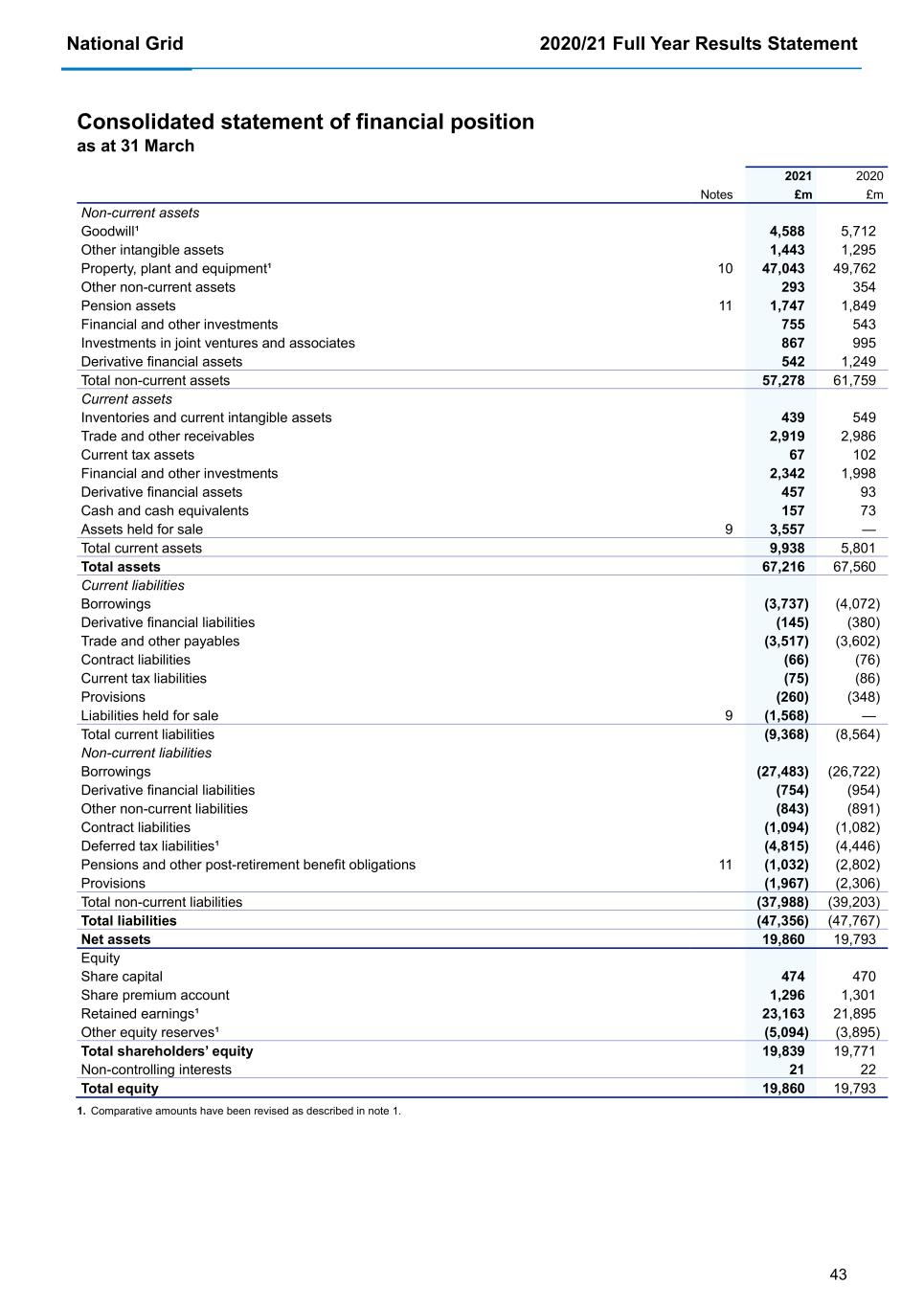
National Grid 2020/21 Full Year Results Statement 43 Consolidated statement of financial position as at 31 March 2021 2020 Notes £m £m Non-current assets Goodwill¹ 4,588 5,712 Other intangible assets 1,443 1,295 Property, plant and equipment¹ 10 47,043 49,762 Other non-current assets 293 354 Pension assets 11 1,747 1,849 Financial and other investments 755 543 Investments in joint ventures and associates 867 995 Derivative financial assets 542 1,249 Total non-current assets 57,278 61,759 Current assets Inventories and current intangible assets 439 549 Trade and other receivables 2,919 2,986 Current tax assets 67 102 Financial and other investments 2,342 1,998 Derivative financial assets 457 93 Cash and cash equivalents 157 73 Assets held for sale 9 3,557 — Total current assets 9,938 5,801 Total assets 67,216 67,560 Current liabilities Borrowings (3,737) (4,072) Derivative financial liabilities (145) (380) Trade and other payables (3,517) (3,602) Contract liabilities (66) (76) Current tax liabilities (75) (86) Provisions (260) (348) Liabilities held for sale 9 (1,568) — Total current liabilities (9,368) (8,564) Non-current liabilities Borrowings (27,483) (26,722) Derivative financial liabilities (754) (954) Other non-current liabilities (843) (891) Contract liabilities (1,094) (1,082) Deferred tax liabilities¹ (4,815) (4,446) Pensions and other post-retirement benefit obligations 11 (1,032) (2,802) Provisions (1,967) (2,306) Total non-current liabilities (37,988) (39,203) Total liabilities (47,356) (47,767) Net assets 19,860 19,793 Equity Share capital 474 470 Share premium account 1,296 1,301 Retained earnings¹ 23,163 21,895 Other equity reserves¹ (5,094) (3,895) Total shareholders’ equity 19,839 19,771 Non-controlling interests 21 22 Total equity 19,860 19,793 1. Comparative amounts have been revised as described in note 1.

National Grid 2020/21 Full Year Results Statement 44 Consolidated cash flow statement for the years ended 31 March 2021 2020 Notes £m £m Cash flows from operating activities Total operating profit from continuing operations 2(b) 2,895 2,780 Adjustments for: Exceptional items and remeasurements 4 31 527 Other fair value movements (22) — Depreciation, amortisation and impairment 1,672 1,640 Share-based payments 27 19 Changes in working capital 312 269 Changes in provisions (195) (169) Changes in pensions and other post-retirement benefit obligations (55) (92) Cash flows relating to exceptional items (47) (60) Cash generated from operations – continuing operations 4,618 4,914 Tax paid (157) (199) Net cash inflow from operating activities – continuing operations 4,461 4,715 Net cash used in operating activities – discontinued operations — (97) Cash flows from investing activities Acquisition of financial investments (99) (108) Acquisition of National Grid Renewables (formerly Geronimo) and Emerald (26) (139) Investments in joint ventures and associates (81) (82) Disposal of financial investments 66 63 Disposal of interests in Quadgas HoldCo Limited — 1,965 Purchases of intangible assets (426) (317) Purchases of property, plant and equipment (4,362) (4,583) Disposals of property, plant and equipment 8 68 Dividends received from joint ventures and associates 80 75 Interest received 16 73 Net movements in short-term financial investments (436) 7 Cash inflows on derivatives 225 58 Cash outflows on derivatives (81) (281) Net cash flow used in investing activities – continuing operations (5,116) (3,201) Net cash flow used in investing activities – discontinued operations — 6 Cash flows from financing activities Proceeds from issue of treasury shares 16 16 Purchase of own shares (2) (6) Proceeds received from loans 5,645 4,218 Repayment of loans (1,663) (3,253) Payments of lease liabilities (112) (121) Net movements in short-term borrowings (759) (424) Cash inflows on derivatives 58 62 Cash outflows on derivatives (185) (249) Interest paid (835) (957) Dividends paid to shareholders (1,413) (892) Net cash flow from/(used in) financing activities – continuing operations 750 (1,606) Net increase/(decrease) in cash and cash equivalents 95 (183) Reclassification to held for sale (4) — Exchange movements (7) 4 Cash and cash equivalents at start of year 73 252 Cash and cash equivalents at end of year 157 73
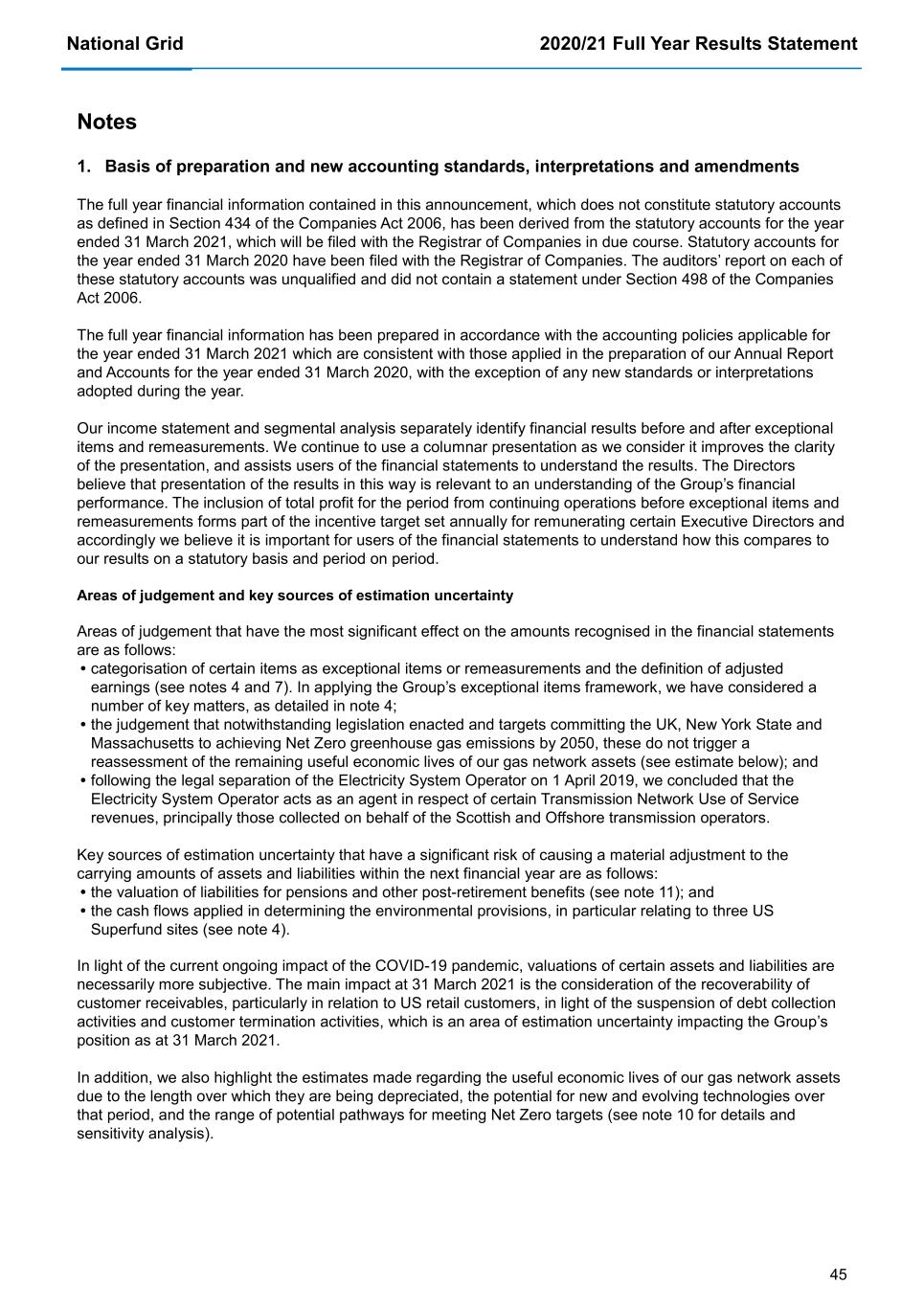
National Grid 2020/21 Full Year Results Statement 45 Notes 1. Basis of preparation and new accounting standards, interpretations and amendments The full year financial information contained in this announcement, which does not constitute statutory accounts as defined in Section 434 of the Companies Act 2006, has been derived from the statutory accounts for the year ended 31 March 2021, which will be filed with the Registrar of Companies in due course. Statutory accounts for the year ended 31 March 2020 have been filed with the Registrar of Companies. The auditors’ report on each of these statutory accounts was unqualified and did not contain a statement under Section 498 of the Companies Act 2006. The full year financial information has been prepared in accordance with the accounting policies applicable for the year ended 31 March 2021 which are consistent with those applied in the preparation of our Annual Report and Accounts for the year ended 31 March 2020, with the exception of any new standards or interpretations adopted during the year. Our income statement and segmental analysis separately identify financial results before and after exceptional items and remeasurements. We continue to use a columnar presentation as we consider it improves the clarity of the presentation, and assists users of the financial statements to understand the results. The Directors believe that presentation of the results in this way is relevant to an understanding of the Group’s financial performance. The inclusion of total profit for the period from continuing operations before exceptional items and remeasurements forms part of the incentive target set annually for remunerating certain Executive Directors and accordingly we believe it is important for users of the financial statements to understand how this compares to our results on a statutory basis and period on period. Areas of judgement and key sources of estimation uncertainty Areas of judgement that have the most significant effect on the amounts recognised in the financial statements are as follows: • categorisation of certain items as exceptional items or remeasurements and the definition of adjusted earnings (see notes 4 and 7). In applying the Group’s exceptional items framework, we have considered a number of key matters, as detailed in note 4; • the judgement that notwithstanding legislation enacted and targets committing the UK, New York State and Massachusetts to achieving Net Zero greenhouse gas emissions by 2050, these do not trigger a reassessment of the remaining useful economic lives of our gas network assets (see estimate below); and • following the legal separation of the Electricity System Operator on 1 April 2019, we concluded that the Electricity System Operator acts as an agent in respect of certain Transmission Network Use of Service revenues, principally those collected on behalf of the Scottish and Offshore transmission operators. Key sources of estimation uncertainty that have a significant risk of causing a material adjustment to the carrying amounts of assets and liabilities within the next financial year are as follows: • the valuation of liabilities for pensions and other post-retirement benefits (see note 11); and • the cash flows applied in determining the environmental provisions, in particular relating to three US Superfund sites (see note 4). In light of the current ongoing impact of the COVID-19 pandemic, valuations of certain assets and liabilities are necessarily more subjective. The main impact at 31 March 2021 is the consideration of the recoverability of customer receivables, particularly in relation to US retail customers, in light of the suspension of debt collection activities and customer termination activities, which is an area of estimation uncertainty impacting the Group’s position as at 31 March 2021. In addition, we also highlight the estimates made regarding the useful economic lives of our gas network assets due to the length over which they are being depreciated, the potential for new and evolving technologies over that period, and the range of potential pathways for meeting Net Zero targets (see note 10 for details and sensitivity analysis).
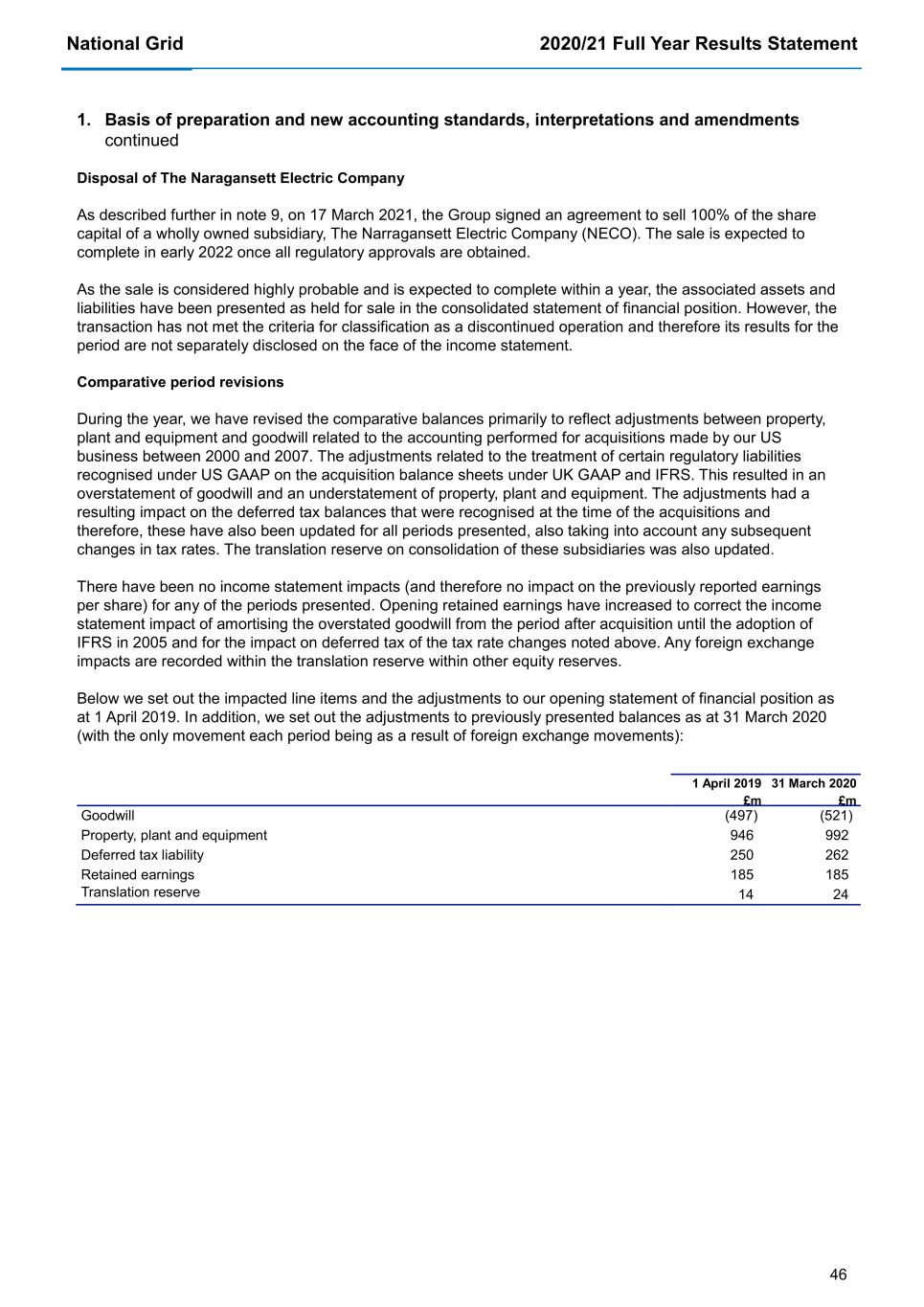
National Grid 2020/21 Full Year Results Statement 46 1. Basis of preparation and new accounting standards, interpretations and amendments continued Disposal of The Naragansett Electric Company As described further in note 9, on 17 March 2021, the Group signed an agreement to sell 100% of the share capital of a wholly owned subsidiary, The Narragansett Electric Company (NECO). The sale is expected to complete in early 2022 once all regulatory approvals are obtained. As the sale is considered highly probable and is expected to complete within a year, the associated assets and liabilities have been presented as held for sale in the consolidated statement of financial position. However, the transaction has not met the criteria for classification as a discontinued operation and therefore its results for the period are not separately disclosed on the face of the income statement. Comparative period revisions During the year, we have revised the comparative balances primarily to reflect adjustments between property, plant and equipment and goodwill related to the accounting performed for acquisitions made by our US business between 2000 and 2007. The adjustments related to the treatment of certain regulatory liabilities recognised under US GAAP on the acquisition balance sheets under UK GAAP and IFRS. This resulted in an overstatement of goodwill and an understatement of property, plant and equipment. The adjustments had a resulting impact on the deferred tax balances that were recognised at the time of the acquisitions and therefore, these have also been updated for all periods presented, also taking into account any subsequent changes in tax rates. The translation reserve on consolidation of these subsidiaries was also updated. There have been no income statement impacts (and therefore no impact on the previously reported earnings per share) for any of the periods presented. Opening retained earnings have increased to correct the income statement impact of amortising the overstated goodwill from the period after acquisition until the adoption of IFRS in 2005 and for the impact on deferred tax of the tax rate changes noted above. Any foreign exchange impacts are recorded within the translation reserve within other equity reserves. Below we set out the impacted line items and the adjustments to our opening statement of financial position as at 1 April 2019. In addition, we set out the adjustments to previously presented balances as at 31 March 2020 (with the only movement each period being as a result of foreign exchange movements): 1 April 2019 31 March 2020 £m £m Goodwill (497) (521) Property, plant and equipment 946 992 Deferred tax liability 250 262 Retained earnings 185 185 Translation reserve 14 24
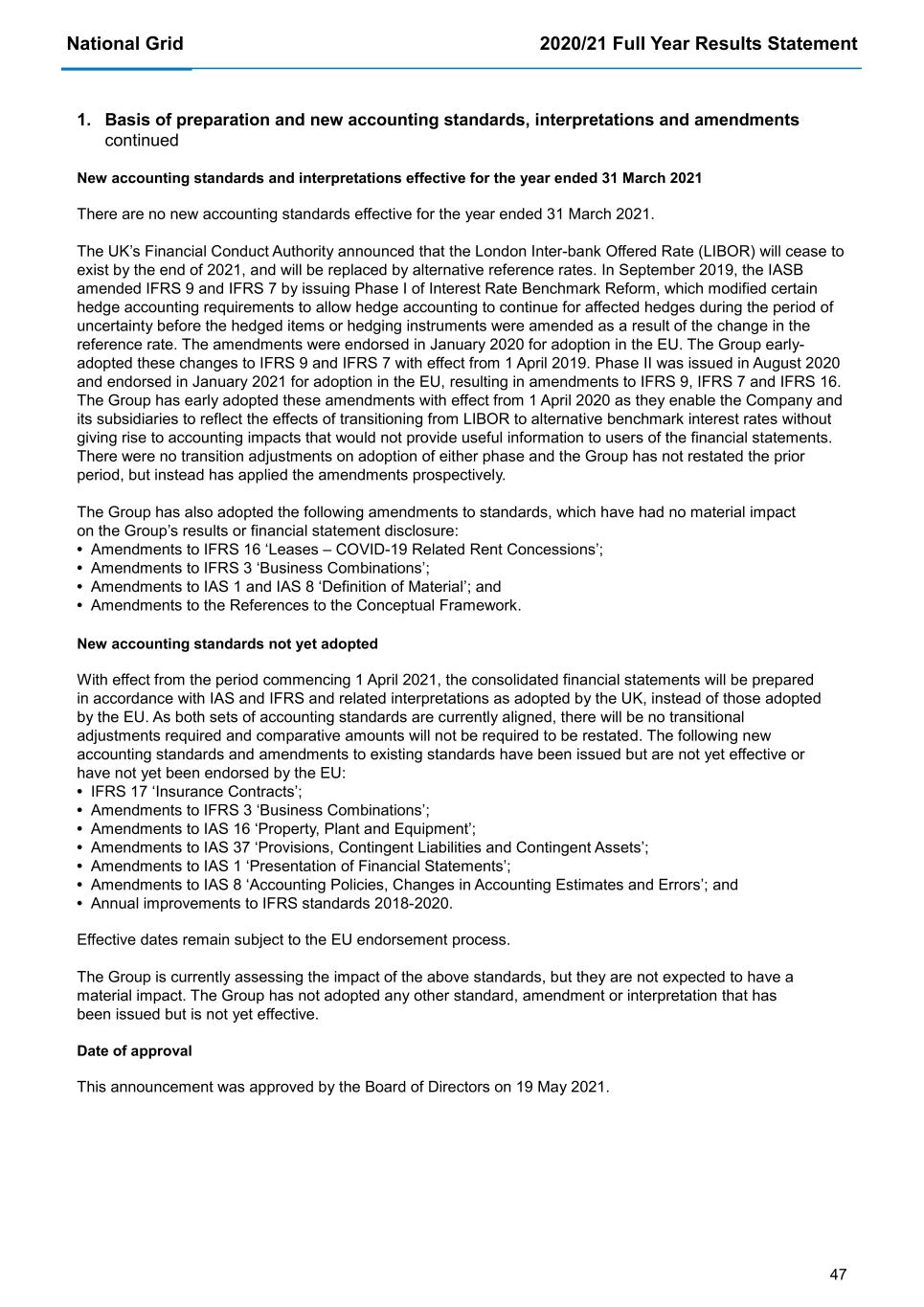
National Grid 2020/21 Full Year Results Statement 47 1. Basis of preparation and new accounting standards, interpretations and amendments continued New accounting standards and interpretations effective for the year ended 31 March 2021 There are no new accounting standards effective for the year ended 31 March 2021. The UK’s Financial Conduct Authority announced that the London Inter-bank Offered Rate (LIBOR) will cease to exist by the end of 2021, and will be replaced by alternative reference rates. In September 2019, the IASB amended IFRS 9 and IFRS 7 by issuing Phase I of Interest Rate Benchmark Reform, which modified certain hedge accounting requirements to allow hedge accounting to continue for affected hedges during the period of uncertainty before the hedged items or hedging instruments were amended as a result of the change in the reference rate. The amendments were endorsed in January 2020 for adoption in the EU. The Group early- adopted these changes to IFRS 9 and IFRS 7 with effect from 1 April 2019. Phase II was issued in August 2020 and endorsed in January 2021 for adoption in the EU, resulting in amendments to IFRS 9, IFRS 7 and IFRS 16. The Group has early adopted these amendments with effect from 1 April 2020 as they enable the Company and its subsidiaries to reflect the effects of transitioning from LIBOR to alternative benchmark interest rates without giving rise to accounting impacts that would not provide useful information to users of the financial statements. There were no transition adjustments on adoption of either phase and the Group has not restated the prior period, but instead has applied the amendments prospectively. The Group has also adopted the following amendments to standards, which have had no material impact on the Group’s results or financial statement disclosure: • Amendments to IFRS 16 ‘Leases – COVID-19 Related Rent Concessions’; • Amendments to IFRS 3 ‘Business Combinations’; • Amendments to IAS 1 and IAS 8 ‘Definition of Material’; and • Amendments to the References to the Conceptual Framework. New accounting standards not yet adopted With effect from the period commencing 1 April 2021, the consolidated financial statements will be prepared in accordance with IAS and IFRS and related interpretations as adopted by the UK, instead of those adopted by the EU. As both sets of accounting standards are currently aligned, there will be no transitional adjustments required and comparative amounts will not be required to be restated. The following new accounting standards and amendments to existing standards have been issued but are not yet effective or have not yet been endorsed by the EU: • IFRS 17 ‘Insurance Contracts’; • Amendments to IFRS 3 ‘Business Combinations’; • Amendments to IAS 16 ‘Property, Plant and Equipment’; • Amendments to IAS 37 ‘Provisions, Contingent Liabilities and Contingent Assets’; • Amendments to IAS 1 ‘Presentation of Financial Statements’; • Amendments to IAS 8 ‘Accounting Policies, Changes in Accounting Estimates and Errors’; and • Annual improvements to IFRS standards 2018-2020. Effective dates remain subject to the EU endorsement process. The Group is currently assessing the impact of the above standards, but they are not expected to have a material impact. The Group has not adopted any other standard, amendment or interpretation that has been issued but is not yet effective. Date of approval This announcement was approved by the Board of Directors on 19 May 2021.

National Grid 2020/21 Full Year Results Statement 48 2. Segmental analysis Revenue and the results of the business are analysed by operating segment, based on the information the Board of Directors uses internally for the purposes of evaluating the performance of each operating segment and determining resource allocation between them. The Board is National Grid’s chief operating decision maker (as defined by IFRS 8 ‘Operating Segments’) and assesses the profitability of operations principally on the basis of operating profit before exceptional items and remeasurements (see note 4). As a matter of course, the Board also considers profitability by segment, excluding the effect of timing. However, the measure of profit disclosed in this note is operating profit before exceptional items and remeasurements as this is the measure that is most consistent with the IFRS results reported within our financial statements. The results of our three principal businesses are reported to the Board of Directors and are treated as reportable operating segments. All other operating segments are reported to the Board of Directors on an aggregated basis. The following table describes the main activities for each reportable operating segment: UK Electricity Transmission The high-voltage electricity transmission networks in England and Wales and Great Britain system operator. UK Gas Transmission The high-pressure gas transmission networks in Great Britain and system operator in Great Britain. US Regulated Gas distribution networks, electricity distribution networks and high-voltage electricity transmission networks in New York and New England and electricity generation facilities in New York. The UK Electricity Transmission segment also includes the independent Electricity System Operator (ESO). Although there is a separate governance structure (including a separate Executive Committee), the Board receives financial information on an aggregated UK Electricity Transmission basis, which includes the results of the ESO, and accordingly the ESO is included within the reportable segment. National Grid Ventures (NGV) is our only other operating segment. It does not currently meet the thresholds set out in IFRS 8 to be identified as a separate reportable segment and therefore its results are not required to be separately presented. Instead, NGV’s results are reported alongside the results of all other operating businesses on an aggregated basis as ‘NGV and Other’, with certain additional disclosure included in footnotes. NGV represents our key strategic growth area outside our regulated core business in competitive markets across the US and the UK. The business comprises all commercial operations in metering, LNG at the Isle of Grain in the UK, electricity interconnectors and our investments in National Grid Renewables (formerly Geronimo) and Emerald Energy Venture LLC (Emerald). Other activities that do not form part of any of the segments in the above table or NGV primarily relate to our UK property business together with insurance and corporate activities in the UK and US and the Group’s investments in technology and innovation companies through National Grid Partners. The segmental information is presented in relation to continuing operations only.
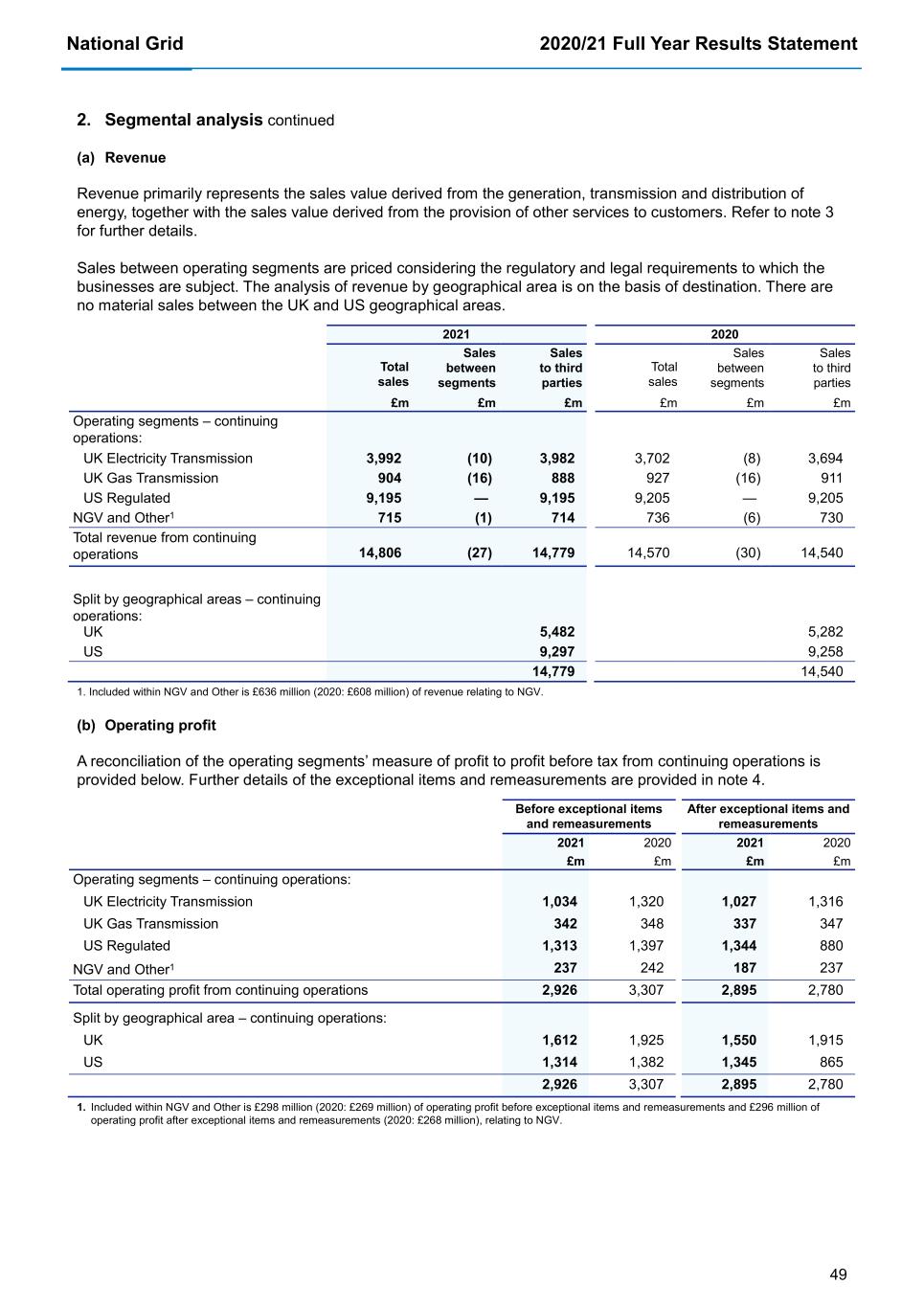
National Grid 2020/21 Full Year Results Statement 49 2. Segmental analysis continued (a) Revenue Revenue primarily represents the sales value derived from the generation, transmission and distribution of energy, together with the sales value derived from the provision of other services to customers. Refer to note 3 for further details. Sales between operating segments are priced considering the regulatory and legal requirements to which the businesses are subject. The analysis of revenue by geographical area is on the basis of destination. There are no material sales between the UK and US geographical areas. 2021 2020 Total sales Sales between segments Sales to third parties Total sales Sales between segments Sales to third parties £m £m £m £m £m £m Operating segments – continuing operations: UK Electricity Transmission 3,992 (10) 3,982 3,702 (8) 3,694 UK Gas Transmission 904 (16) 888 927 (16) 911 US Regulated 9,195 — 9,195 9,205 — 9,205 NGV and Other1 715 (1) 714 736 (6) 730 Total revenue from continuing operations 14,806 (27) 14,779 14,570 (30) 14,540 Split by geographical areas – continuing operations: UK 5,482 5,282 US 9,297 9,258 14,779 14,540 1. Included within NGV and Other is £636 million (2020: £608 million) of revenue relating to NGV. (b) Operating profit A reconciliation of the operating segments’ measure of profit to profit before tax from continuing operations is provided below. Further details of the exceptional items and remeasurements are provided in note 4. Before exceptional items and remeasurements After exceptional items and remeasurements 2021 2020 2021 2020 £m £m £m £m Operating segments – continuing operations: UK Electricity Transmission 1,034 1,320 1,027 1,316 UK Gas Transmission 342 348 337 347 US Regulated 1,313 1,397 1,344 880 NGV and Other1 237 242 187 237 Total operating profit from continuing operations 2,926 3,307 2,895 2,780 Split by geographical area – continuing operations: UK 1,612 1,925 1,550 1,915 US 1,314 1,382 1,345 865 2,926 3,307 2,895 2,780 1. Included within NGV and Other is £298 million (2020: £269 million) of operating profit before exceptional items and remeasurements and £296 million of operating profit after exceptional items and remeasurements (2020: £268 million), relating to NGV.

National Grid 2020/21 Full Year Results Statement 50 2. Segmental analysis continued Below we reconcile total operating profit from continuing operations to profit before tax from continuing operations. Total operating exceptional items and remeasurements of £31 million charge (2020: £527 million charge) are detailed in note 4. This is comprised of a £7 million charge (2020: £4 million charge) attributable to UK Electricity Transmission; £5 million charge (2020: £1 million charge) to UK Gas Transmission; £31 million gain (2020: £517 million charge) to US Regulated; and £50 million charge (2020: £5 million charge) to NGV and Other. Before exceptional items and remeasurements After exceptional items and remeasurements 2021 2020 2021 2020 £m £m £m £m Reconciliation to profit before tax: Operating profit from continuing operations 2,926 3,307 2,895 2,780 Finance income 35 70 58 54 Finance costs (977) (1,119) (928) (1,167) Share of post-tax results of joint ventures and associates 66 88 58 87 Profit before tax from continuing operations 2,050 2,346 2,083 1,754 (c) Capital expenditure Capital expenditure represents additions to property, plant and equipment and non-current intangibles but excludes additional investments in and loans to joint ventures and associates. Net book value of property, plant and equipment and other intangible assets Capital expenditure Depreciation, amortisation and impairment 2021 2020 2021 2020 2021 2020 £m £m £m £m £m £m Operating segments: UK Electricity Transmission 14,379 13,788 1,072 1,043 (507) (469) UK Gas Transmission 4,531 4,513 176 249 (165) (171) US Regulated1 27,128 30,615 3,223 3,228 (888) (855) NGV and Other2 2,448 2,141 460 559 (112) (145) Total from continuing operations1 48,486 51,057 4,931 5,079 (1,672) (1,640) Split by geographical area – continuing operations: UK 21,352 20,427 1,708 1,847 (783) (784) US2 27,134 30,630 3,223 3,232 (889) (856) Total from continuing operations1 48,486 51,057 4,931 5,079 (1,672) (1,640) Asset type: Property, plant and equipment1 47,043 49,762 4,510 4,727 (1,476) (1,464) Non-current intangible assets 1,443 1,295 421 352 (196) (176) Total from continuing operations1 48,486 51,057 4,931 5,079 (1,672) (1,640) 1. Comparative amounts have been revised as described in note 1. 2. Included within NGV and Other are assets with a net book value of £2,396 million (2020: £2,080 million), capital expenditure of £431 million (2020: £550 million) and depreciation, amortisation and impairment of £92 million (2020: £124 million) relating to NGV.
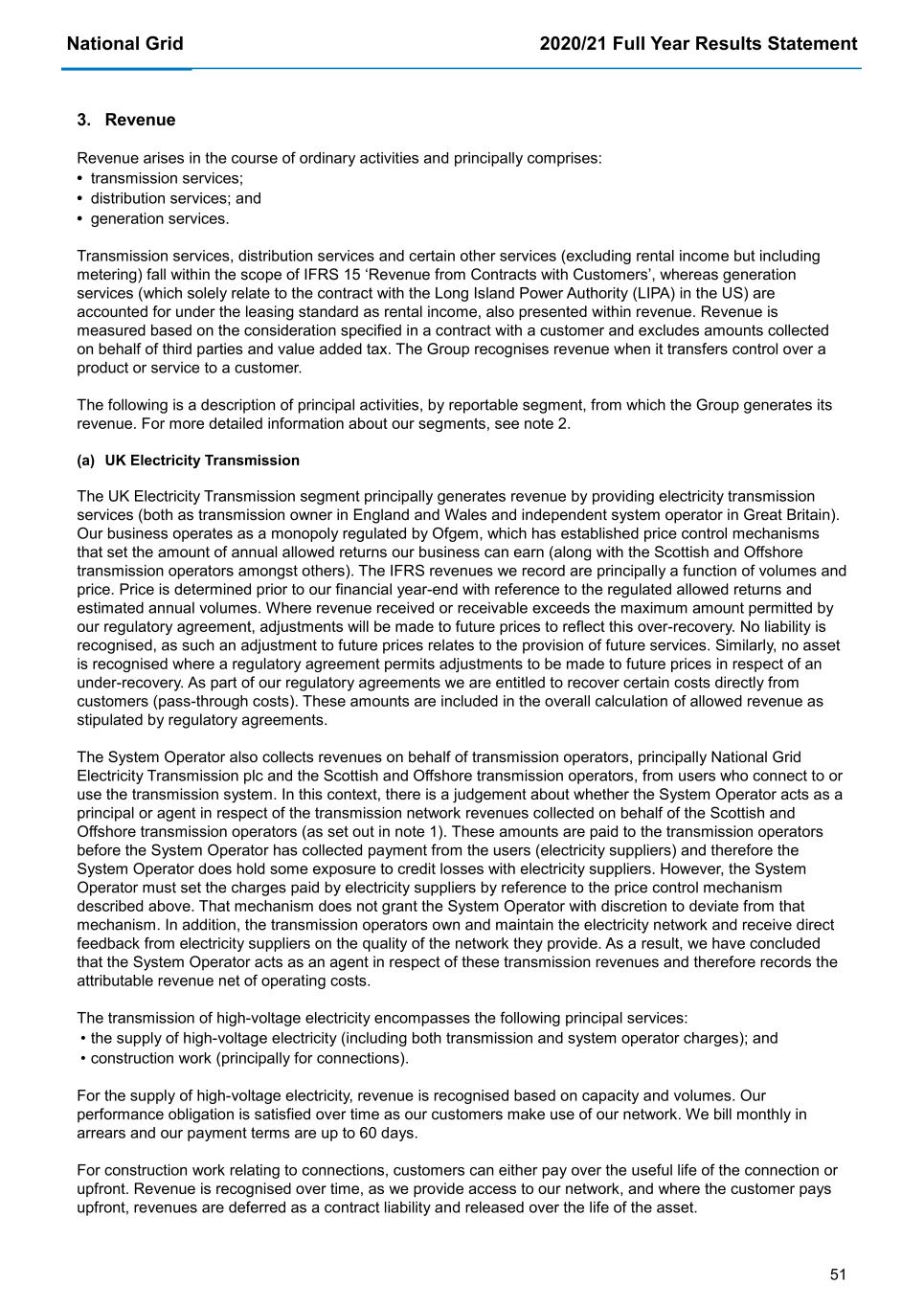
National Grid 2020/21 Full Year Results Statement 51 3. Revenue Revenue arises in the course of ordinary activities and principally comprises: • transmission services; • distribution services; and • generation services. Transmission services, distribution services and certain other services (excluding rental income but including metering) fall within the scope of IFRS 15 ‘Revenue from Contracts with Customers’, whereas generation services (which solely relate to the contract with the Long Island Power Authority (LIPA) in the US) are accounted for under the leasing standard as rental income, also presented within revenue. Revenue is measured based on the consideration specified in a contract with a customer and excludes amounts collected on behalf of third parties and value added tax. The Group recognises revenue when it transfers control over a product or service to a customer. The following is a description of principal activities, by reportable segment, from which the Group generates its revenue. For more detailed information about our segments, see note 2. (a) UK Electricity Transmission The UK Electricity Transmission segment principally generates revenue by providing electricity transmission services (both as transmission owner in England and Wales and independent system operator in Great Britain). Our business operates as a monopoly regulated by Ofgem, which has established price control mechanisms that set the amount of annual allowed returns our business can earn (along with the Scottish and Offshore transmission operators amongst others). The IFRS revenues we record are principally a function of volumes and price. Price is determined prior to our financial year-end with reference to the regulated allowed returns and estimated annual volumes. Where revenue received or receivable exceeds the maximum amount permitted by our regulatory agreement, adjustments will be made to future prices to reflect this over-recovery. No liability is recognised, as such an adjustment to future prices relates to the provision of future services. Similarly, no asset is recognised where a regulatory agreement permits adjustments to be made to future prices in respect of an under-recovery. As part of our regulatory agreements we are entitled to recover certain costs directly from customers (pass-through costs). These amounts are included in the overall calculation of allowed revenue as stipulated by regulatory agreements. The System Operator also collects revenues on behalf of transmission operators, principally National Grid Electricity Transmission plc and the Scottish and Offshore transmission operators, from users who connect to or use the transmission system. In this context, there is a judgement about whether the System Operator acts as a principal or agent in respect of the transmission network revenues collected on behalf of the Scottish and Offshore transmission operators (as set out in note 1). These amounts are paid to the transmission operators before the System Operator has collected payment from the users (electricity suppliers) and therefore the System Operator does hold some exposure to credit losses with electricity suppliers. However, the System Operator must set the charges paid by electricity suppliers by reference to the price control mechanism described above. That mechanism does not grant the System Operator with discretion to deviate from that mechanism. In addition, the transmission operators own and maintain the electricity network and receive direct feedback from electricity suppliers on the quality of the network they provide. As a result, we have concluded that the System Operator acts as an agent in respect of these transmission revenues and therefore records the attributable revenue net of operating costs. The transmission of high-voltage electricity encompasses the following principal services: • the supply of high-voltage electricity (including both transmission and system operator charges); and • construction work (principally for connections). For the supply of high-voltage electricity, revenue is recognised based on capacity and volumes. Our performance obligation is satisfied over time as our customers make use of our network. We bill monthly in arrears and our payment terms are up to 60 days. For construction work relating to connections, customers can either pay over the useful life of the connection or upfront. Revenue is recognised over time, as we provide access to our network, and where the customer pays upfront, revenues are deferred as a contract liability and released over the life of the asset.
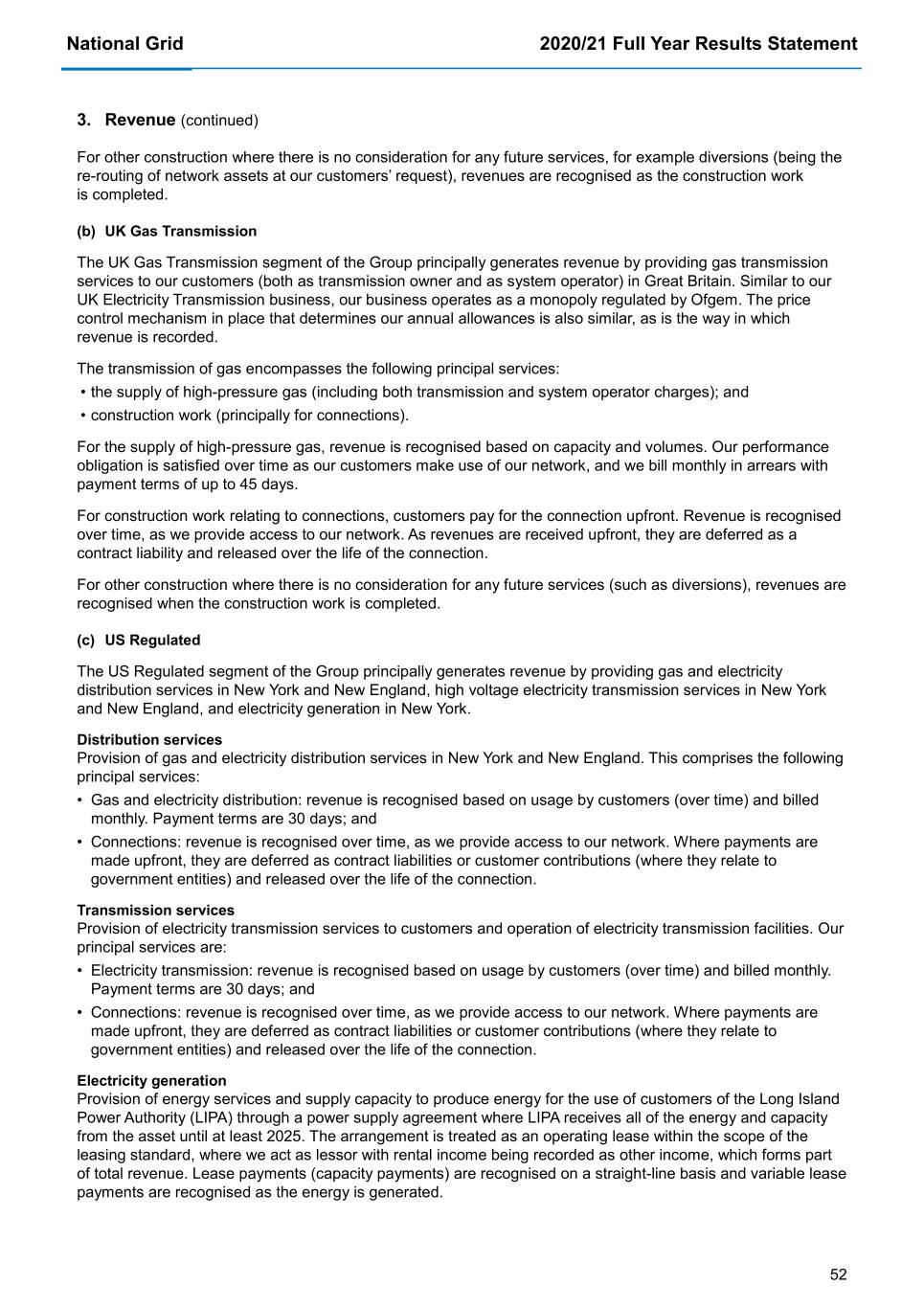
National Grid 2020/21 Full Year Results Statement 52 3. Revenue (continued) For other construction where there is no consideration for any future services, for example diversions (being the re-routing of network assets at our customers’ request), revenues are recognised as the construction work is completed. (b) UK Gas Transmission The UK Gas Transmission segment of the Group principally generates revenue by providing gas transmission services to our customers (both as transmission owner and as system operator) in Great Britain. Similar to our UK Electricity Transmission business, our business operates as a monopoly regulated by Ofgem. The price control mechanism in place that determines our annual allowances is also similar, as is the way in which revenue is recorded. The transmission of gas encompasses the following principal services: • the supply of high-pressure gas (including both transmission and system operator charges); and • construction work (principally for connections). For the supply of high-pressure gas, revenue is recognised based on capacity and volumes. Our performance obligation is satisfied over time as our customers make use of our network, and we bill monthly in arrears with payment terms of up to 45 days. For construction work relating to connections, customers pay for the connection upfront. Revenue is recognised over time, as we provide access to our network. As revenues are received upfront, they are deferred as a contract liability and released over the life of the connection. For other construction where there is no consideration for any future services (such as diversions), revenues are recognised when the construction work is completed. (c) US Regulated The US Regulated segment of the Group principally generates revenue by providing gas and electricity distribution services in New York and New England, high voltage electricity transmission services in New York and New England, and electricity generation in New York. Distribution services Provision of gas and electricity distribution services in New York and New England. This comprises the following principal services: • Gas and electricity distribution: revenue is recognised based on usage by customers (over time) and billed monthly. Payment terms are 30 days; and • Connections: revenue is recognised over time, as we provide access to our network. Where payments are made upfront, they are deferred as contract liabilities or customer contributions (where they relate to government entities) and released over the life of the connection. Transmission services Provision of electricity transmission services to customers and operation of electricity transmission facilities. Our principal services are: • Electricity transmission: revenue is recognised based on usage by customers (over time) and billed monthly. Payment terms are 30 days; and • Connections: revenue is recognised over time, as we provide access to our network. Where payments are made upfront, they are deferred as contract liabilities or customer contributions (where they relate to government entities) and released over the life of the connection. Electricity generation Provision of energy services and supply capacity to produce energy for the use of customers of the Long Island Power Authority (LIPA) through a power supply agreement where LIPA receives all of the energy and capacity from the asset until at least 2025. The arrangement is treated as an operating lease within the scope of the leasing standard, where we act as lessor with rental income being recorded as other income, which forms part of total revenue. Lease payments (capacity payments) are recognised on a straight-line basis and variable lease payments are recognised as the energy is generated.
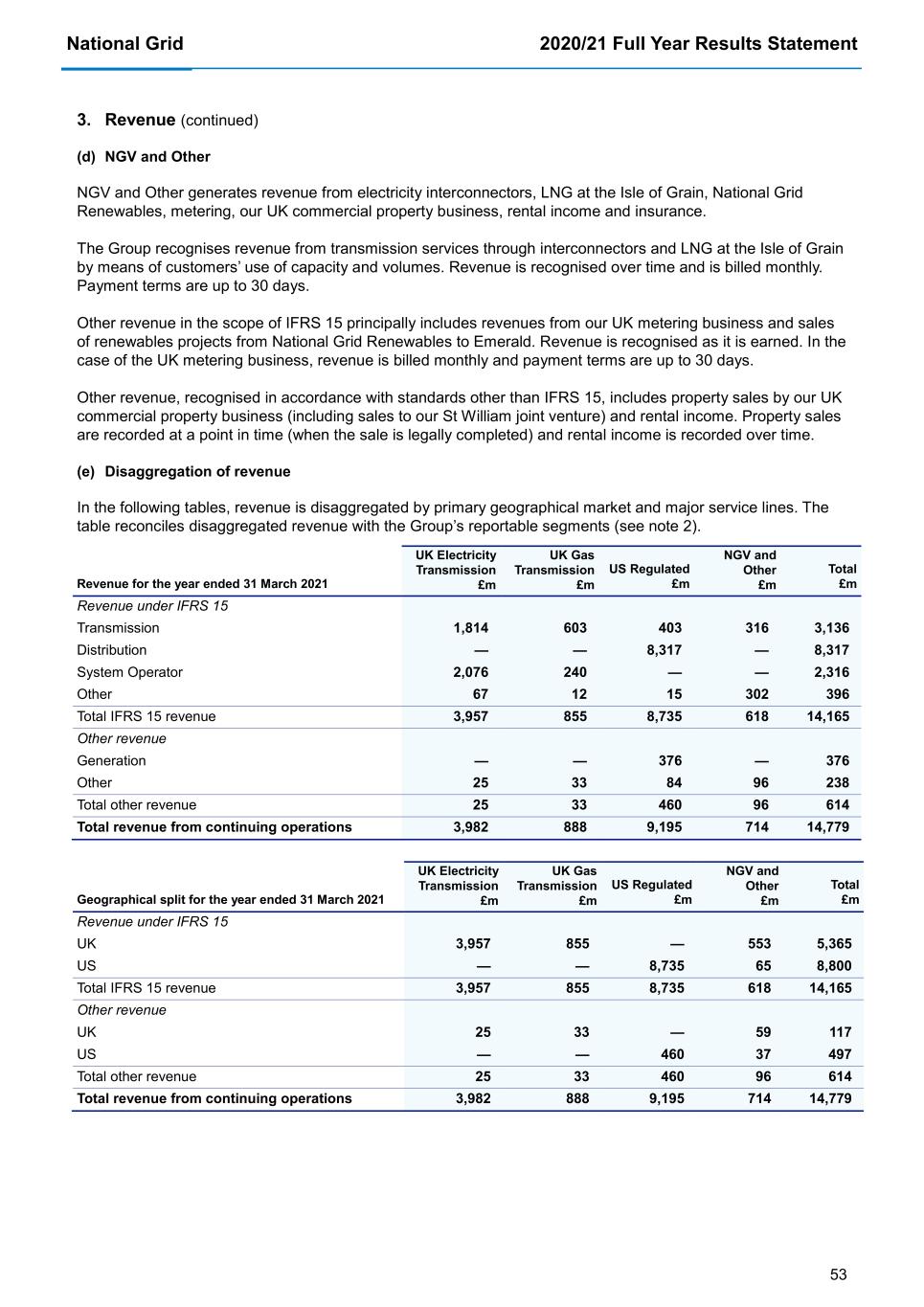
National Grid 2020/21 Full Year Results Statement 53 3. Revenue (continued) (d) NGV and Other NGV and Other generates revenue from electricity interconnectors, LNG at the Isle of Grain, National Grid Renewables, metering, our UK commercial property business, rental income and insurance. The Group recognises revenue from transmission services through interconnectors and LNG at the Isle of Grain by means of customers’ use of capacity and volumes. Revenue is recognised over time and is billed monthly. Payment terms are up to 30 days. Other revenue in the scope of IFRS 15 principally includes revenues from our UK metering business and sales of renewables projects from National Grid Renewables to Emerald. Revenue is recognised as it is earned. In the case of the UK metering business, revenue is billed monthly and payment terms are up to 30 days. Other revenue, recognised in accordance with standards other than IFRS 15, includes property sales by our UK commercial property business (including sales to our St William joint venture) and rental income. Property sales are recorded at a point in time (when the sale is legally completed) and rental income is recorded over time. (e) Disaggregation of revenue In the following tables, revenue is disaggregated by primary geographical market and major service lines. The table reconciles disaggregated revenue with the Group’s reportable segments (see note 2). Revenue for the year ended 31 March 2021 UK Electricity Transmission £m UK Gas Transmission £m US Regulated £m NGV and Other £m Total £m Revenue under IFRS 15 Transmission 1,814 603 403 316 3,136 Distribution — — 8,317 — 8,317 System Operator 2,076 240 — — 2,316 Other 67 12 15 302 396 Total IFRS 15 revenue 3,957 855 8,735 618 14,165 Other revenue Generation — — 376 — 376 Other 25 33 84 96 238 Total other revenue 25 33 460 96 614 Total revenue from continuing operations 3,982 888 9,195 714 14,779 Geographical split for the year ended 31 March 2021 UK Electricity Transmission £m UK Gas Transmission £m US Regulated £m NGV and Other £m Total £m Revenue under IFRS 15 UK 3,957 855 — 553 5,365 US — — 8,735 65 8,800 Total IFRS 15 revenue 3,957 855 8,735 618 14,165 Other revenue UK 25 33 — 59 117 US — — 460 37 497 Total other revenue 25 33 460 96 614 Total revenue from continuing operations 3,982 888 9,195 714 14,779
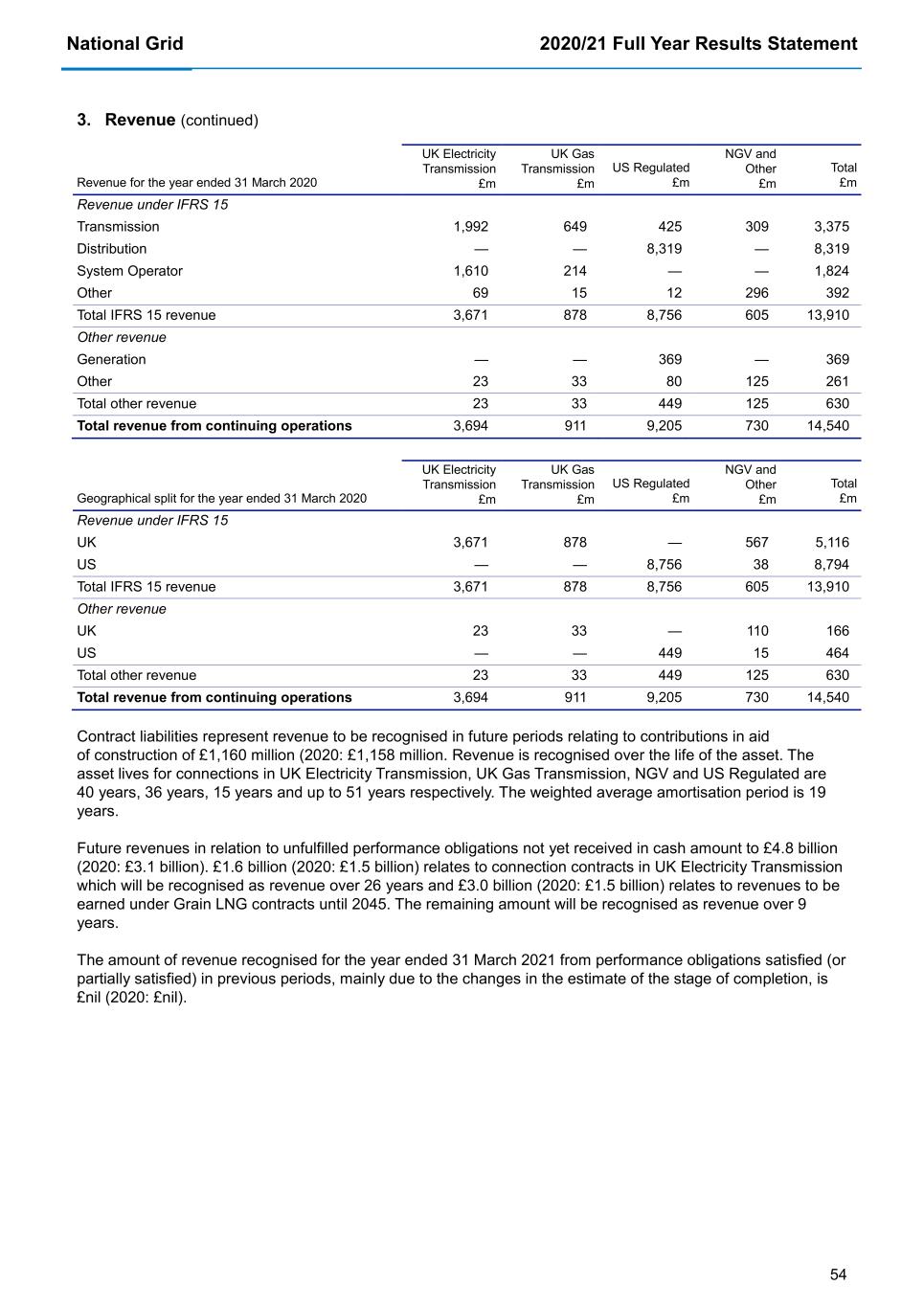
National Grid 2020/21 Full Year Results Statement 54 3. Revenue (continued) Revenue for the year ended 31 March 2020 UK Electricity Transmission £m UK Gas Transmission £m US Regulated £m NGV and Other £m Total £m Revenue under IFRS 15 Transmission 1,992 649 425 309 3,375 Distribution — — 8,319 — 8,319 System Operator 1,610 214 — — 1,824 Other 69 15 12 296 392 Total IFRS 15 revenue 3,671 878 8,756 605 13,910 Other revenue Generation — — 369 — 369 Other 23 33 80 125 261 Total other revenue 23 33 449 125 630 Total revenue from continuing operations 3,694 911 9,205 730 14,540 Geographical split for the year ended 31 March 2020 UK Electricity Transmission £m UK Gas Transmission £m US Regulated £m NGV and Other £m Total £m Revenue under IFRS 15 UK 3,671 878 — 567 5,116 US — — 8,756 38 8,794 Total IFRS 15 revenue 3,671 878 8,756 605 13,910 Other revenue UK 23 33 — 110 166 US — — 449 15 464 Total other revenue 23 33 449 125 630 Total revenue from continuing operations 3,694 911 9,205 730 14,540 Contract liabilities represent revenue to be recognised in future periods relating to contributions in aid of construction of £1,160 million (2020: £1,158 million. Revenue is recognised over the life of the asset. The asset lives for connections in UK Electricity Transmission, UK Gas Transmission, NGV and US Regulated are 40 years, 36 years, 15 years and up to 51 years respectively. The weighted average amortisation period is 19 years. Future revenues in relation to unfulfilled performance obligations not yet received in cash amount to £4.8 billion (2020: £3.1 billion). £1.6 billion (2020: £1.5 billion) relates to connection contracts in UK Electricity Transmission which will be recognised as revenue over 26 years and £3.0 billion (2020: £1.5 billion) relates to revenues to be earned under Grain LNG contracts until 2045. The remaining amount will be recognised as revenue over 9 years. The amount of revenue recognised for the year ended 31 March 2021 from performance obligations satisfied (or partially satisfied) in previous periods, mainly due to the changes in the estimate of the stage of completion, is £nil (2020: £nil).
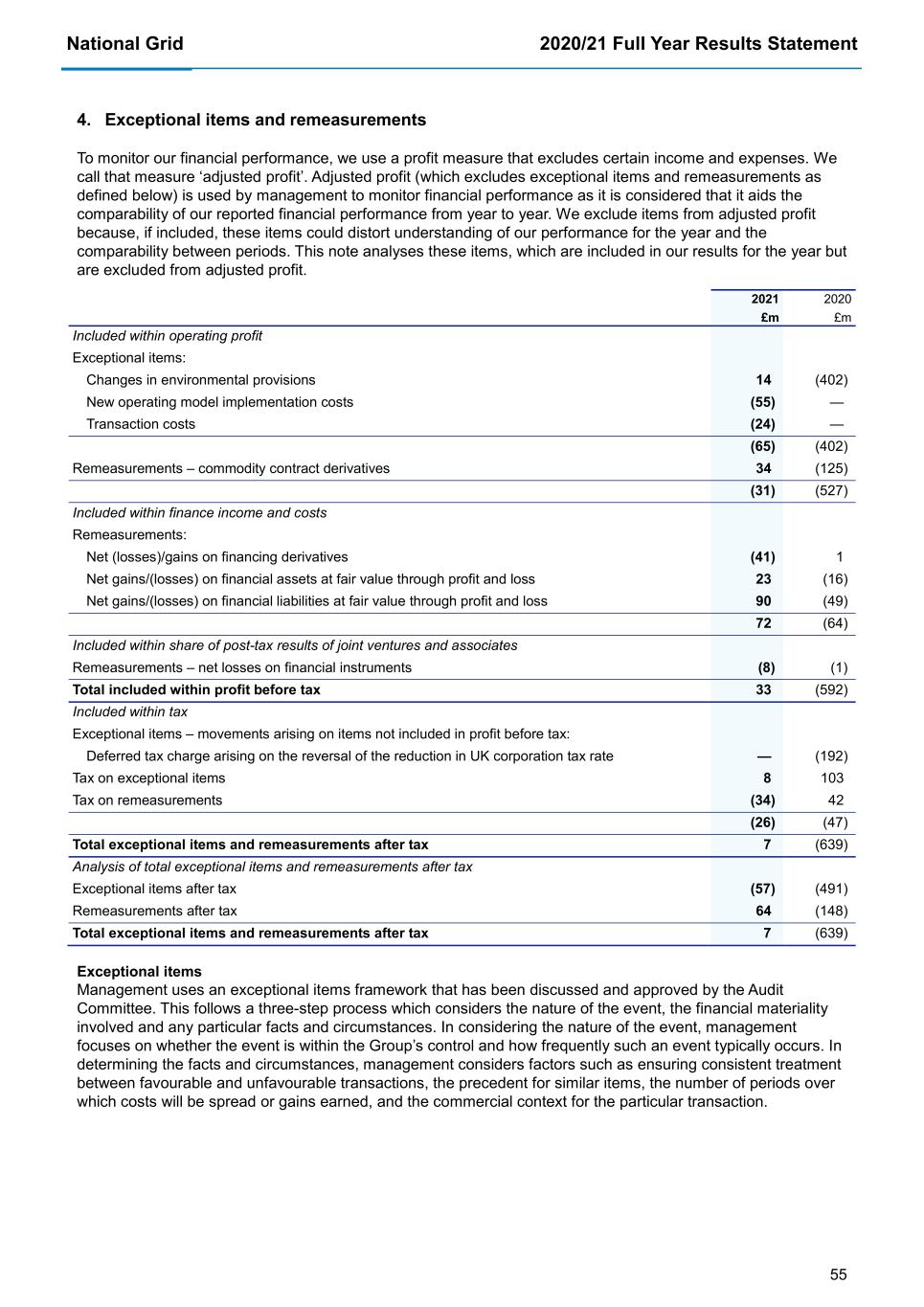
National Grid 2020/21 Full Year Results Statement 55 4. Exceptional items and remeasurements To monitor our financial performance, we use a profit measure that excludes certain income and expenses. We call that measure ‘adjusted profit’. Adjusted profit (which excludes exceptional items and remeasurements as defined below) is used by management to monitor financial performance as it is considered that it aids the comparability of our reported financial performance from year to year. We exclude items from adjusted profit because, if included, these items could distort understanding of our performance for the year and the comparability between periods. This note analyses these items, which are included in our results for the year but are excluded from adjusted profit. 2021 2020 £m £m Included within operating profit Exceptional items: Changes in environmental provisions 14 (402) New operating model implementation costs (55) — Transaction costs (24) — (65) (402) Remeasurements – commodity contract derivatives 34 (125) (31) (527) Included within finance income and costs Remeasurements: Net (losses)/gains on financing derivatives (41) 1 Net gains/(losses) on financial assets at fair value through profit and loss 23 (16) Net gains/(losses) on financial liabilities at fair value through profit and loss 90 (49) 72 (64) Included within share of post-tax results of joint ventures and associates Remeasurements – net losses on financial instruments (8) (1) Total included within profit before tax 33 (592) Included within tax Exceptional items – movements arising on items not included in profit before tax: Deferred tax charge arising on the reversal of the reduction in UK corporation tax rate — (192) Tax on exceptional items 8 103 Tax on remeasurements (34) 42 (26) (47) Total exceptional items and remeasurements after tax 7 (639) Analysis of total exceptional items and remeasurements after tax Exceptional items after tax (57) (491) Remeasurements after tax 64 (148) Total exceptional items and remeasurements after tax 7 (639) Exceptional items Management uses an exceptional items framework that has been discussed and approved by the Audit Committee. This follows a three-step process which considers the nature of the event, the financial materiality involved and any particular facts and circumstances. In considering the nature of the event, management focuses on whether the event is within the Group’s control and how frequently such an event typically occurs. In determining the facts and circumstances, management considers factors such as ensuring consistent treatment between favourable and unfavourable transactions, the precedent for similar items, the number of periods over which costs will be spread or gains earned, and the commercial context for the particular transaction.
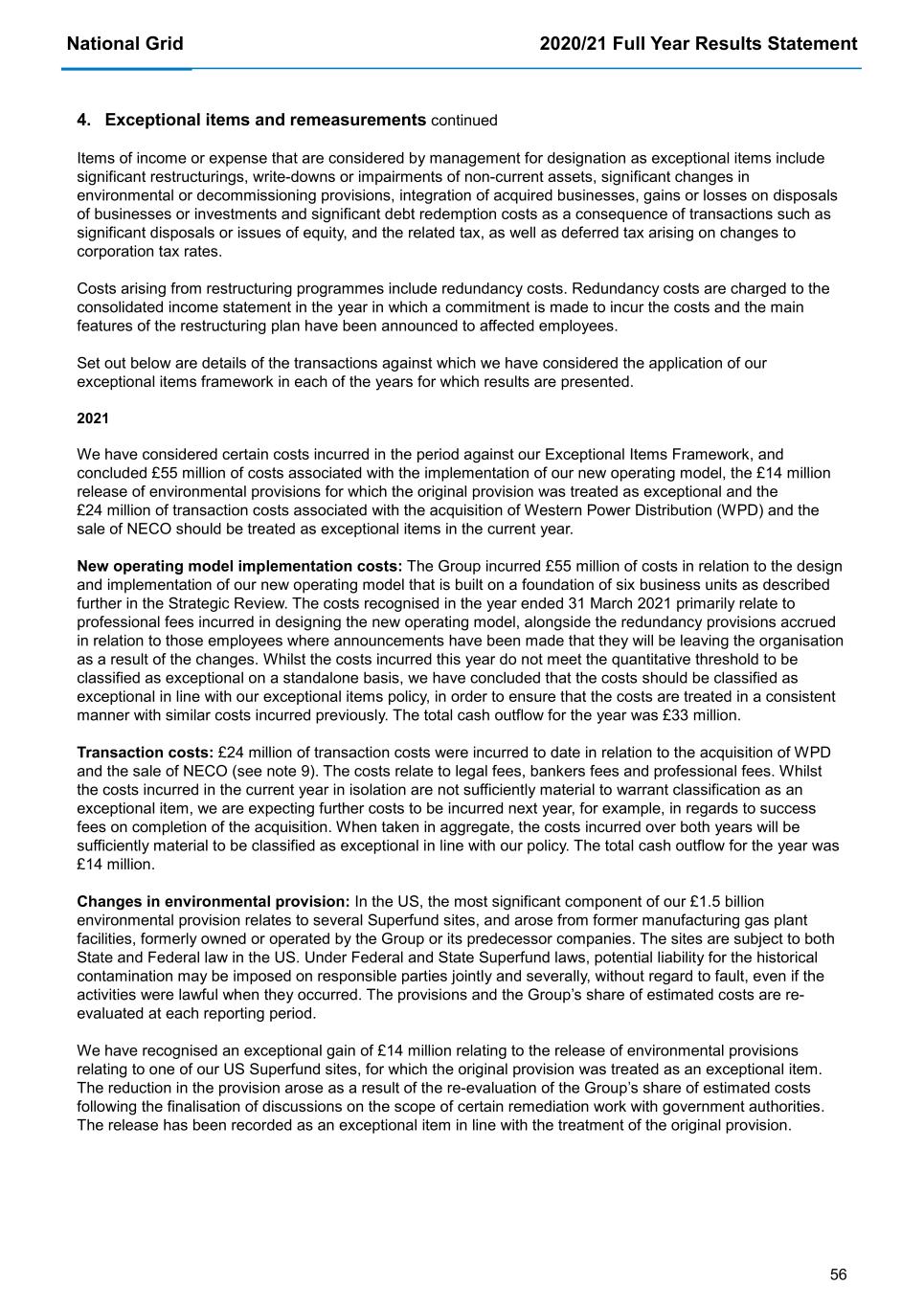
National Grid 2020/21 Full Year Results Statement 56 4. Exceptional items and remeasurements continued Items of income or expense that are considered by management for designation as exceptional items include significant restructurings, write-downs or impairments of non-current assets, significant changes in environmental or decommissioning provisions, integration of acquired businesses, gains or losses on disposals of businesses or investments and significant debt redemption costs as a consequence of transactions such as significant disposals or issues of equity, and the related tax, as well as deferred tax arising on changes to corporation tax rates. Costs arising from restructuring programmes include redundancy costs. Redundancy costs are charged to the consolidated income statement in the year in which a commitment is made to incur the costs and the main features of the restructuring plan have been announced to affected employees. Set out below are details of the transactions against which we have considered the application of our exceptional items framework in each of the years for which results are presented. 2021 We have considered certain costs incurred in the period against our Exceptional Items Framework, and concluded £55 million of costs associated with the implementation of our new operating model, the £14 million release of environmental provisions for which the original provision was treated as exceptional and the £24 million of transaction costs associated with the acquisition of Western Power Distribution (WPD) and the sale of NECO should be treated as exceptional items in the current year. New operating model implementation costs: The Group incurred £55 million of costs in relation to the design and implementation of our new operating model that is built on a foundation of six business units as described further in the Strategic Review. The costs recognised in the year ended 31 March 2021 primarily relate to professional fees incurred in designing the new operating model, alongside the redundancy provisions accrued in relation to those employees where announcements have been made that they will be leaving the organisation as a result of the changes. Whilst the costs incurred this year do not meet the quantitative threshold to be classified as exceptional on a standalone basis, we have concluded that the costs should be classified as exceptional in line with our exceptional items policy, in order to ensure that the costs are treated in a consistent manner with similar costs incurred previously. The total cash outflow for the year was £33 million. Transaction costs: £24 million of transaction costs were incurred to date in relation to the acquisition of WPD and the sale of NECO (see note 9). The costs relate to legal fees, bankers fees and professional fees. Whilst the costs incurred in the current year in isolation are not sufficiently material to warrant classification as an exceptional item, we are expecting further costs to be incurred next year, for example, in regards to success fees on completion of the acquisition. When taken in aggregate, the costs incurred over both years will be sufficiently material to be classified as exceptional in line with our policy. The total cash outflow for the year was £14 million. Changes in environmental provision: In the US, the most significant component of our £1.5 billion environmental provision relates to several Superfund sites, and arose from former manufacturing gas plant facilities, formerly owned or operated by the Group or its predecessor companies. The sites are subject to both State and Federal law in the US. Under Federal and State Superfund laws, potential liability for the historical contamination may be imposed on responsible parties jointly and severally, without regard to fault, even if the activities were lawful when they occurred. The provisions and the Group’s share of estimated costs are re- evaluated at each reporting period. We have recognised an exceptional gain of £14 million relating to the release of environmental provisions relating to one of our US Superfund sites, for which the original provision was treated as an exceptional item. The reduction in the provision arose as a result of the re-evaluation of the Group’s share of estimated costs following the finalisation of discussions on the scope of certain remediation work with government authorities. The release has been recorded as an exceptional item in line with the treatment of the original provision.

National Grid 2020/21 Full Year Results Statement 57 4. Exceptional items and remeasurements continued 2020 We concluded that the increase in costs associated with the changes in our environmental provisions (£402 million) and the additional deferred tax charge reflecting the impact of the remeasurement of the Group’s deferred tax liabilities as a result of a change in the substantively enacted UK corporation tax rate (£192 million) meet the criteria to be classified as exceptional. A further £10 million of COVID-19 related costs incurred in the year ended 31 March 2020 were similarly not classified as exceptional in view of the quantum involved and all costs associated with the settlement reached with the State of New York in respect of the Downstate New York Gas Moratorium were also treated as part of adjusted profit. Changes in environmental provisions: As a result of notices issued by governmental authorities and newly developed cost estimates prepared by third-party engineers in relation to our US Superfund sites, we re- evaluated our estimates of total costs and cost sharing allocations borne by the Company, and accordingly increased our provision by £326 million. Under the terms of our rate plans, we are entitled to recovery of environmental clean-up costs from rate payers, but under IFRS no asset can be recognised for this recovery. Also included in the total environmental charge was the £76 million impact of the change in the real discount rate applied to the environmental provisions across the Group, of which £66 million related to the US and £10 million to the UK. Given the substantial and sustained change in gilts and corporate bond yields, we concluded it was appropriate to reduce the real discount rate from 1% to 0.5%. The weighted average remaining duration of our cash flows is now around 10 years.

National Grid 2020/21 Full Year Results Statement 58 4. Exceptional items and remeasurements continued Remeasurements Remeasurements comprise unrealised gains or losses recorded in the consolidated income statement arising from changes in the fair value of certain of our financial assets and liabilities accounted for at fair value through profit and loss (FVTPL). Once the fair value movements are realised (for example, when the derivative matures), the previously recognised fair value movements are then reversed through remeasurements and recognised within earnings before exceptional items and remeasurements. These assets and liabilities include commodity contract derivatives and financing derivatives to the extent that hedge accounting is not available or is not fully effective. The unrealised gains or losses reported in profit and loss on certain additional assets and liabilities treated at FVTPL are also classified within remeasurements. These relate to financial assets (which fail the ‘solely payments of principal and interest test’ under IFRS 9), the money market fund investments used by Group Treasury for cash management purposes and certain financial liabilities which we elected to designate at FVTPL. In all cases, these fair values increase or decrease because of changes in foreign exchange, commodity or other financial indices over which we have no control. We report unrealised gains or losses relating to certain discrete classes of financial assets accounted for at FVTPL within adjusted profit. These comprise our portfolio of investments made by National Grid Partners, our investment in Sunrun Neptune 2016 LLC and the contingent consideration arising on the acquisition of National Grid Renewables (all within NGV and Other). The performance of these assets (including changes in fair value) are included in our assessment of adjusted profit for the relevant business units. Remeasurements excluded from adjusted profit are made up of the following categories: i. Net gains/(losses) on commodity contract derivatives represent mark-to-market movements on certain physical and financial commodity contract obligations in the US. These contracts primarily relate to the forward purchase of energy for supply to customers, or to the economic hedging thereof, that are required to be measured at fair value and that do not qualify for hedge accounting. Under the existing rate plans in the US, commodity costs are recoverable from customers although the timing of recovery may differ from the pattern of costs incurred; ii. Net gains/(losses) on financing derivatives comprise gains and losses arising on derivative financial instruments used for the risk management of interest rate and foreign exchange exposures. These exclude gains and losses for which hedge accounting has been effective, and have been recognised directly in the consolidated statement of other comprehensive income or are offset by adjustments to the carrying value of debt; iii. Net gains/(losses) on financial assets measured at FVTPL comprise gains and losses on the investment funds held by our insurance captives which are categorised as FVTPL; iv. Net gains/(losses) on financial liabilities measured at FVTPL comprises the change in the fair value (excluding changes due to own credit risk) of a financial liability that was designated at FVTPL on transition to IFRS 9 to reduce a measurement mismatch; and v. Unrealised net gains/(losses) on derivatives and other financial instruments within our joint ventures and associates. Items included within tax 2020 The Finance Act 2016, which was enacted on 15 September 2016, reduced the main UK corporation tax rate to 17% with effect from 1 April 2020. Deferred tax balances were calculated at this rate for the years ended 31 March 2017 to 2019. On 17 March 2020, the UK Government utilised the Provisional Collection of Taxes Act 1968 to substantively enact a reversal of the reduction in the main UK corporation tax rate to 17% with effect from 1 April 2020, resulting in the rate remaining at 19%. Deferred taxes at 31 March 2020 were measured using enacted tax rates and reflected in these financial statements, resulting in a £192 million deferred tax charge, principally due to the remeasurement of deferred tax liabilities. The treatment of this charge as exceptional was consistent with the treatment for the year ended 31 March 2017 when the original reduction in the tax rate was substantively enacted, resulting in the recognition of an exceptional tax credit of £94 million.
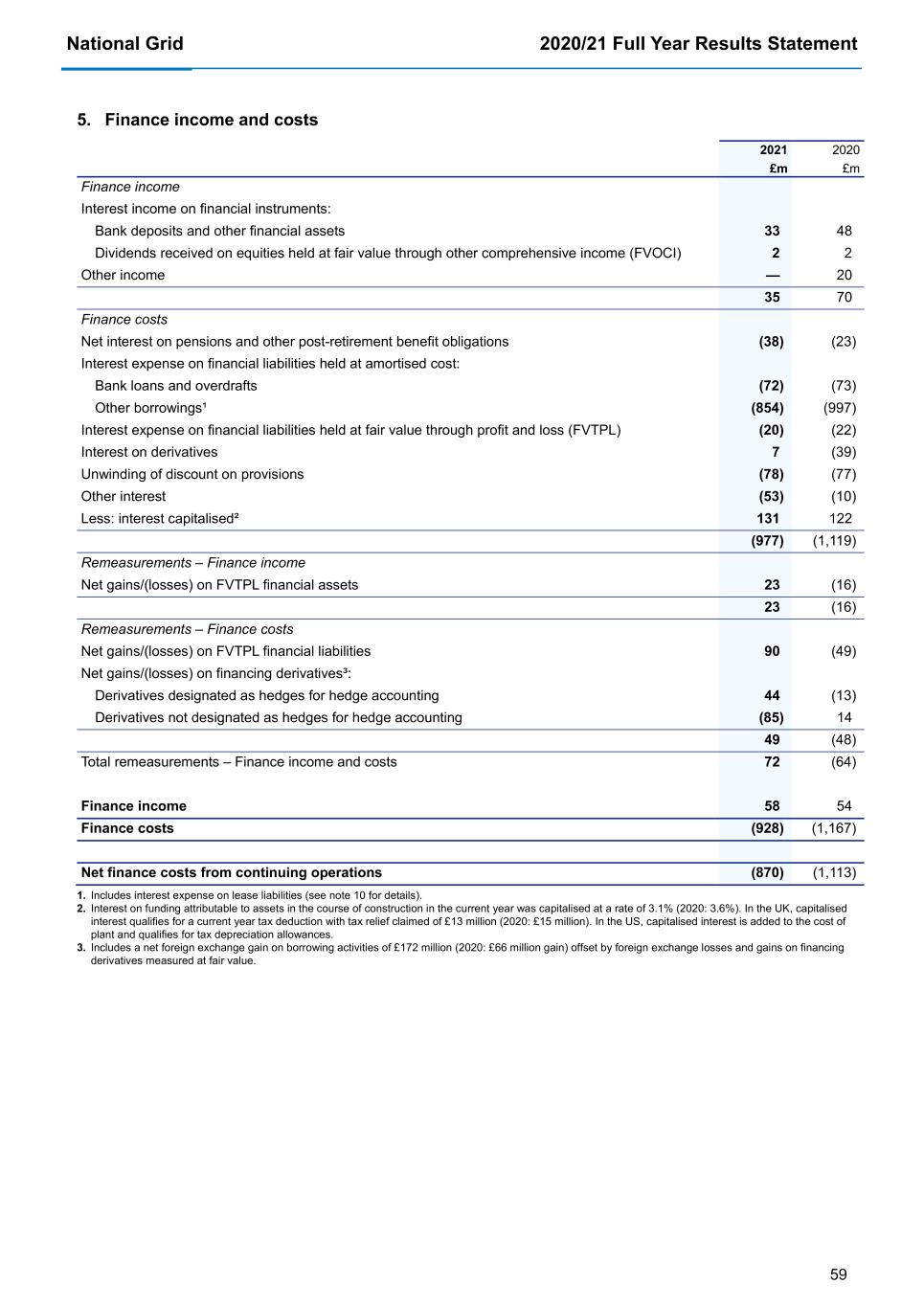
National Grid 2020/21 Full Year Results Statement 59 5. Finance income and costs 2021 2020 £m £m Finance income Interest income on financial instruments: Bank deposits and other financial assets 33 48 Dividends received on equities held at fair value through other comprehensive income (FVOCI) 2 2 Other income — 20 35 70 Finance costs Net interest on pensions and other post-retirement benefit obligations (38) (23) Interest expense on financial liabilities held at amortised cost: Bank loans and overdrafts (72) (73) Other borrowings¹ (854) (997) Interest expense on financial liabilities held at fair value through profit and loss (FVTPL) (20) (22) Interest on derivatives 7 (39) Unwinding of discount on provisions (78) (77) Other interest (53) (10) Less: interest capitalised² 131 122 (977) (1,119) Remeasurements – Finance income Net gains/(losses) on FVTPL financial assets 23 (16) 23 (16) Remeasurements – Finance costs Net gains/(losses) on FVTPL financial liabilities 90 (49) Net gains/(losses) on financing derivatives³: Derivatives designated as hedges for hedge accounting 44 (13) Derivatives not designated as hedges for hedge accounting (85) 14 49 (48) Total remeasurements – Finance income and costs 72 (64) Finance income 58 54 Finance costs (928) (1,167) Net finance costs from continuing operations (870) (1,113) 1. Includes interest expense on lease liabilities (see note 10 for details). 2. Interest on funding attributable to assets in the course of construction in the current year was capitalised at a rate of 3.1% (2020: 3.6%). In the UK, capitalised interest qualifies for a current year tax deduction with tax relief claimed of £13 million (2020: £15 million). In the US, capitalised interest is added to the cost of plant and qualifies for tax depreciation allowances. 3. Includes a net foreign exchange gain on borrowing activities of £172 million (2020: £66 million gain) offset by foreign exchange losses and gains on financing derivatives measured at fair value.

National Grid 2020/21 Full Year Results Statement 60 6. Tax Tax charged/(credited) to the consolidated income statement – continuing operations 2021 2020 £m £m Tax before exceptional items and remeasurements 416 433 Exceptional tax on items not included in profit before tax (see note 4) — 192 Tax on other exceptional items and remeasurements 26 (145) Total tax reported within exceptional items and remeasurements 26 47 Total tax charge from continuing operations 442 480 Tax as a percentage of profit before tax 2021 2020 % % Before exceptional items and remeasurements – continuing operations 20.3 18.5 After exceptional items and remeasurements – continuing operations 21.2 27.4 2021 2020 £m £m Current tax: UK corporation tax at 19% (2020: 19%) 213 179 UK corporation tax adjustment in respect of prior years 23 (4) 236 175 Overseas corporation tax 3 (2) Overseas corporation tax adjustment in respect of prior years (15) (41) (12) (43) Total current tax from continuing operations 224 132 Deferred tax: UK deferred tax 63 269 UK deferred tax adjustment in respect of prior years (26) 6 37 275 Overseas deferred tax 174 64 Overseas deferred tax adjustment in respect of prior years 7 9 181 73 Total deferred tax from continuing operations 218 348 Total tax charge from continuing operations 442 480
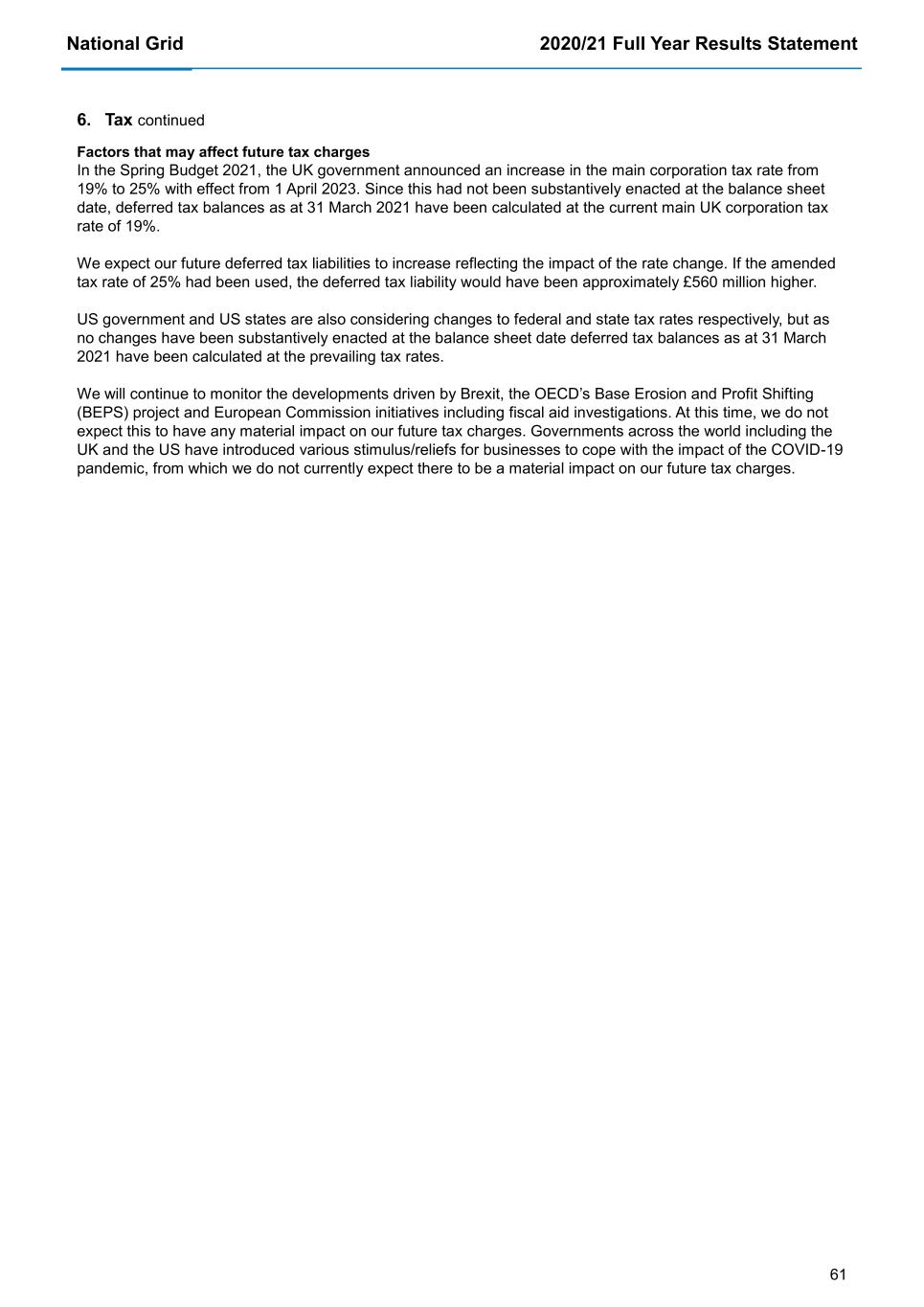
National Grid 2020/21 Full Year Results Statement 61 6. Tax continued Factors that may affect future tax charges In the Spring Budget 2021, the UK government announced an increase in the main corporation tax rate from 19% to 25% with effect from 1 April 2023. Since this had not been substantively enacted at the balance sheet date, deferred tax balances as at 31 March 2021 have been calculated at the current main UK corporation tax rate of 19%. We expect our future deferred tax liabilities to increase reflecting the impact of the rate change. If the amended tax rate of 25% had been used, the deferred tax liability would have been approximately £560 million higher. US government and US states are also considering changes to federal and state tax rates respectively, but as no changes have been substantively enacted at the balance sheet date deferred tax balances as at 31 March 2021 have been calculated at the prevailing tax rates. We will continue to monitor the developments driven by Brexit, the OECD’s Base Erosion and Profit Shifting (BEPS) project and European Commission initiatives including fiscal aid investigations. At this time, we do not expect this to have any material impact on our future tax charges. Governments across the world including the UK and the US have introduced various stimulus/reliefs for businesses to cope with the impact of the COVID-19 pandemic, from which we do not currently expect there to be a material impact on our future tax charges.
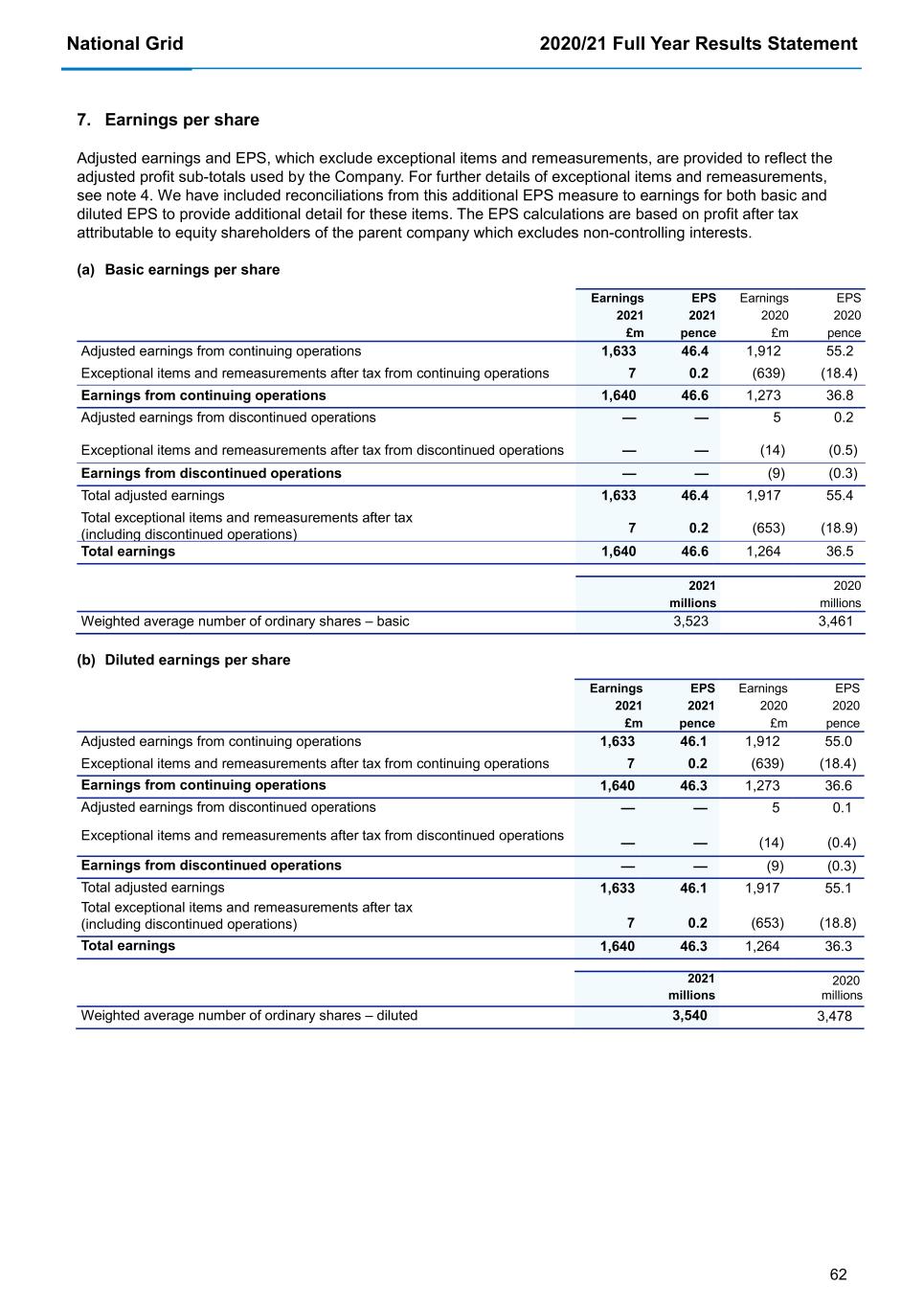
National Grid 2020/21 Full Year Results Statement 62 7. Earnings per share Adjusted earnings and EPS, which exclude exceptional items and remeasurements, are provided to reflect the adjusted profit sub-totals used by the Company. For further details of exceptional items and remeasurements, see note 4. We have included reconciliations from this additional EPS measure to earnings for both basic and diluted EPS to provide additional detail for these items. The EPS calculations are based on profit after tax attributable to equity shareholders of the parent company which excludes non-controlling interests. (a) Basic earnings per share Earnings EPS Earnings EPS 2021 2021 2020 2020 £m pence £m pence Adjusted earnings from continuing operations 1,633 46.4 1,912 55.2 Exceptional items and remeasurements after tax from continuing operations 7 0.2 (639) (18.4) Earnings from continuing operations 1,640 46.6 1,273 36.8 Adjusted earnings from discontinued operations — — 5 0.2 Exceptional items and remeasurements after tax from discontinued operations — — (14) (0.5) Earnings from discontinued operations — — (9) (0.3) Total adjusted earnings 1,633 46.4 1,917 55.4 Total exceptional items and remeasurements after tax (including discontinued operations) 7 0.2 (653) (18.9) Total earnings 1,640 46.6 1,264 36.5 2021 2020 millions millions Weighted average number of ordinary shares – basic 3,523 3,461 (b) Diluted earnings per share Earnings EPS Earnings EPS 2021 2021 2020 2020 £m pence £m pence Adjusted earnings from continuing operations 1,633 46.1 1,912 55.0 Exceptional items and remeasurements after tax from continuing operations 7 0.2 (639) (18.4) Earnings from continuing operations 1,640 46.3 1,273 36.6 Adjusted earnings from discontinued operations — — 5 0.1 Exceptional items and remeasurements after tax from discontinued operations — — (14) (0.4) Earnings from discontinued operations — — (9) (0.3) Total adjusted earnings 1,633 46.1 1,917 55.1 Total exceptional items and remeasurements after tax (including discontinued operations) 7 0.2 (653) (18.8) Total earnings 1,640 46.3 1,264 36.3 2021 2020 millions millions Weighted average number of ordinary shares – diluted 3,540 3,478

National Grid 2020/21 Full Year Results Statement 63 8. Dividends 2021 2020 Pence per share Cash dividend paid £m Scrip dividend £m Pence per share Cash dividend paid £m Scrip dividend £m Interim dividend in respect of the current year 17.00 348 249 16.57 335 241 Final dividend in respect of the prior year 32.00 1,065 54 31.26 557 517 49.00 1,413 303 47.83 892 758 The Directors are proposing a final dividend for the year ended 31 March 2021 of 32.16p per share that will absorb approximately £1,141 million of shareholders’ equity (assuming all amounts are settled in cash). It will be paid on 18 August 2021 to shareholders who are on the register of members at 4 June 2021 (subject to shareholders’ approval at the AGM). A scrip dividend will be offered as an alternative. 9. Assets held for sale The Narragansett Electric Company On 17 March 2021, the Group signed an agreement to sell 100% of the share capital of a wholly owned subsidiary, The Narragansett Electric Company (NECO). NECO is part of our US Regulated segment and is a retail distribution company providing electricity and gas to customers in Rhode Island. The expected sale proceeds are £2.8 billion ($3.8 billion), and the sale is expected to complete in March 2022 once all regulatory approvals are obtained. As the sale is considered highly probable and is expected to complete within a year, the associated assets and liabilities have been presented as held for sale in the consolidated statement of financial position. However, as NECO does not represent a separate major line of business or geographical operations, it has not met the criteria for classification as a discontinued operation and therefore its results for the period are not separately disclosed on the face of the income statement. The following assets and liabilities of NECO were classified as held for sale at 31 March 2021: 2021 £m Goodwill 562 Intangible assets 3 Property, plant and equipment 2,713 Trade and other receivables 237 Cash and cash equivalents 4 Other assets 38 Total assets held for sale 3,557 Borrowings (1,123) Pension liabilities (49) Other liabilities (396) Total liabilities held for sale (1,568) Net assets held for sale 1,989 No impairment losses were recognised upon remeasurement of the assets and liabilities prior to classification as held for sale. NECO generated profit after tax of £104 million (2020: £31 million) for the year ended 31 March 2021. Current and deferred tax balances relating to NECO have not been included as held for sale on the basis that those balances will be retained by National Grid rather than transferring with the other assets and liabilities of NECO. The Group also announced its intention to sell a majority stake in the UK Gas Transmission business. However, as the process is still at an early stage and is not expected to be marketed until later in the year, the business has not been classified as held for sale and has not met the criteria for classification as a discontinued operation as at 31 March 2021.
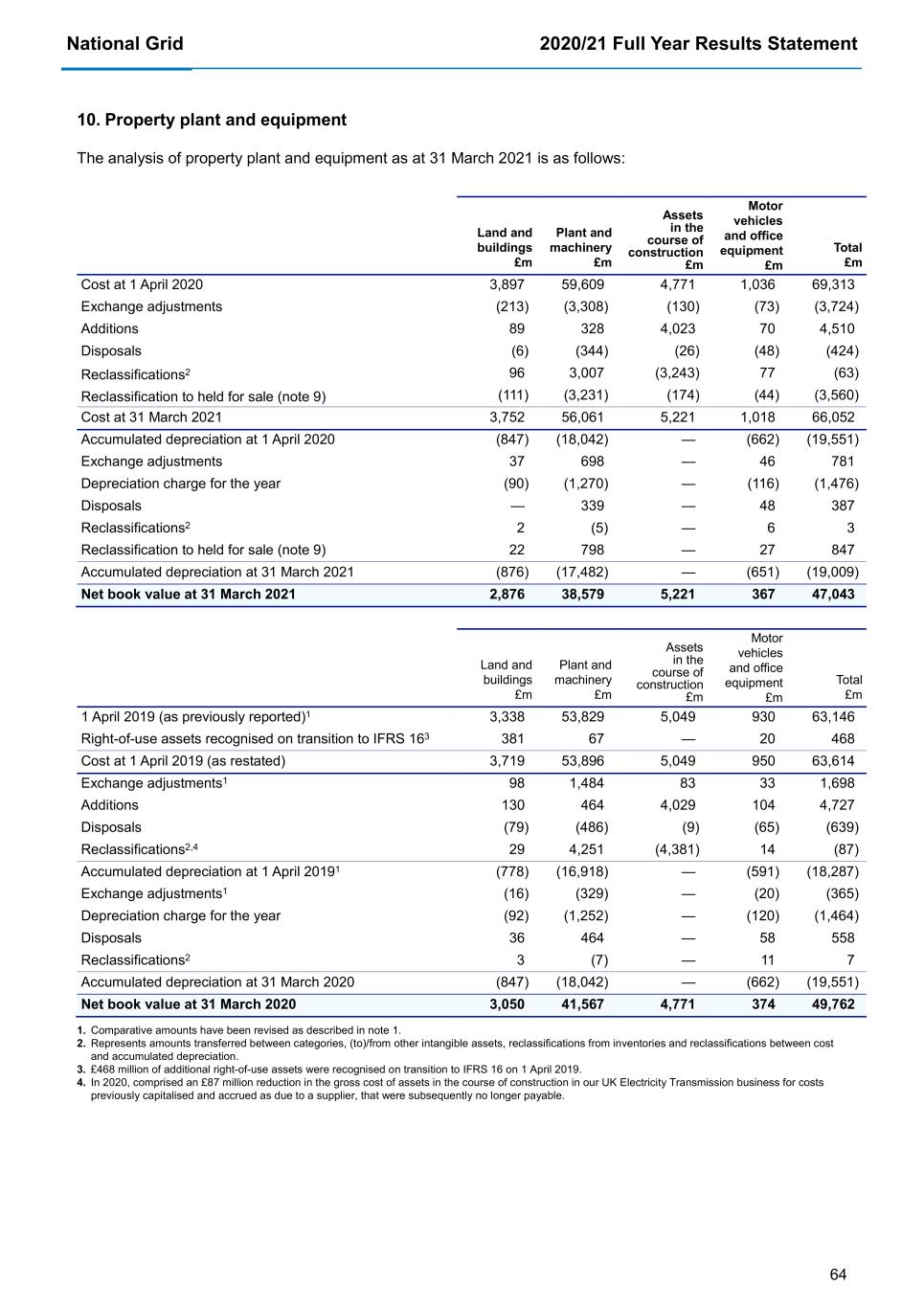
National Grid 2020/21 Full Year Results Statement 64 10. Property plant and equipment The analysis of property plant and equipment as at 31 March 2021 is as follows: Land and buildings £m Plant and machinery £m Assets in the course of construction £m Motor vehicles and office equipment £m Total £m Cost at 1 April 2020 3,897 59,609 4,771 1,036 69,313 Exchange adjustments (213) (3,308) (130) (73) (3,724) Additions 89 328 4,023 70 4,510 Disposals (6) (344) (26) (48) (424) Reclassifications2 96 3,007 (3,243) 77 (63) Reclassification to held for sale (note 9) (111) (3,231) (174) (44) (3,560) Cost at 31 March 2021 3,752 56,061 5,221 1,018 66,052 Accumulated depreciation at 1 April 2020 (847) (18,042) — (662) (19,551) Exchange adjustments 37 698 — 46 781 Depreciation charge for the year (90) (1,270) — (116) (1,476) Disposals — 339 — 48 387 Reclassifications2 2 (5) — 6 3 Reclassification to held for sale (note 9) 22 798 — 27 847 Accumulated depreciation at 31 March 2021 (876) (17,482) — (651) (19,009) Net book value at 31 March 2021 2,876 38,579 5,221 367 47,043 Land and buildings £m Plant and machinery £m Assets in the course of construction £m Motor vehicles and office equipment £m Total £m 1 April 2019 (as previously reported)1 3,338 53,829 5,049 930 63,146 Right-of-use assets recognised on transition to IFRS 163 381 67 — 20 468 Cost at 1 April 2019 (as restated) 3,719 53,896 5,049 950 63,614 Exchange adjustments1 98 1,484 83 33 1,698 Additions 130 464 4,029 104 4,727 Disposals (79) (486) (9) (65) (639) Reclassifications2,4 29 4,251 (4,381) 14 (87) Accumulated depreciation at 1 April 20191 (778) (16,918) — (591) (18,287) Exchange adjustments1 (16) (329) — (20) (365) Depreciation charge for the year (92) (1,252) — (120) (1,464) Disposals 36 464 — 58 558 Reclassifications2 3 (7) — 11 7 Accumulated depreciation at 31 March 2020 (847) (18,042) — (662) (19,551) Net book value at 31 March 2020 3,050 41,567 4,771 374 49,762 1. Comparative amounts have been revised as described in note 1. 2. Represents amounts transferred between categories, (to)/from other intangible assets, reclassifications from inventories and reclassifications between cost and accumulated depreciation. 3. £468 million of additional right-of-use assets were recognised on transition to IFRS 16 on 1 April 2019. 4. In 2020, comprised an £87 million reduction in the gross cost of assets in the course of construction in our UK Electricity Transmission business for costs previously capitalised and accrued as due to a supplier, that were subsequently no longer payable.

National Grid 2020/21 Full Year Results Statement 65 10. Property plant and equipment continued Gas asset lives: The role that gas networks play in the pathway to achieving the greenhouse gas emissions reductions targets set in the jurisdictions in which we operate is currently uncertain. However, we believe the gas assets which we own and operate today will continue to have a crucial role in maintaining security, reliability and affordability of energy beyond 2050, although the scale and purpose for which the networks will be used is dependent on technological developments and policy choices of governments and regulators. • In the UK, the useful economic life of gas mains, services and regulating assets relating to the National Transmission System (NTS) are frequently reviewed throughout the year and subject to a detailed review at the year end. The most material components of these are our pipeline assets, which are due to be fully depreciated by 2070, with other assets being depreciated over various periods between now and then. Those reviews considered a number of scenarios, which consider the implications of the UK’s Net Zero by 2050 legislation for the NTS. Our most recent review concluded that the most likely outcome was for the NTS network assets to remain in use beyond 2050, including in those scenarios where the greenhouse gas emissions of gas networks were largely eliminated. • With respect to our US gas distribution assets, asset lives are assessed as part of detailed depreciation studies completed as part of each separate rate proceeding. Depreciation studies consider the physical condition of assets and the expected operational life of an asset. We believe these assessments are our best estimate of the UEL of our gas network assets in the US. The weighted average remaining UEL for our US gas distribution fixed asset base is circa 50 years, however a sizeable proportion of our assets are assumed to have UELs which extend beyond 2080. We continue to believe the lives identified by rate proceedings are the best estimate of the assets’ UELs, although we continue to keep this assumption under review as we learn more about possible future pathways towards Net Zero. Whilst the targets, goals and ambitions have now been formalised in legislation in the states in which we operate, there is widespread recognition that work needs to be done to define the possible future decarbonisation pathways. We continue to actively engage and support our regulators to enable the clean energy transition in a safe, reliable and affordable way. Asset depreciation lives feed directly into our US regulatory recovery mechanisms, such that any shortening of asset lives and regulatory recovery periods as agreed with regulators should be recoverable through future rates, subject to agreement, over future periods, as part of wider considerations around ensuring the continuing affordability of gas in our service territories. Given the uncertainty described relating to the UELs of our gas assets, below we provide a sensitivity on the depreciation charge for our UK and US regulated segments were a shorter UEL presumed: Increase in depreciation expense for the year ended 31 March 2021 Increase in depreciation expense for the year ended 31 March 2020 UK regulated £m US regulated £m UK regulated £m US regulated £m UELs limited to 2050 35 160 37 151 UELs limited to 2060 12 70 13 66 UELs limited to 2070 1 28 — 26 Note that this sensitivity calculation excludes any assumptions regarding the residual value for our asset base and the effect shortening asset depreciation lives would be expected to have on our regulatory recovery mechanisms.
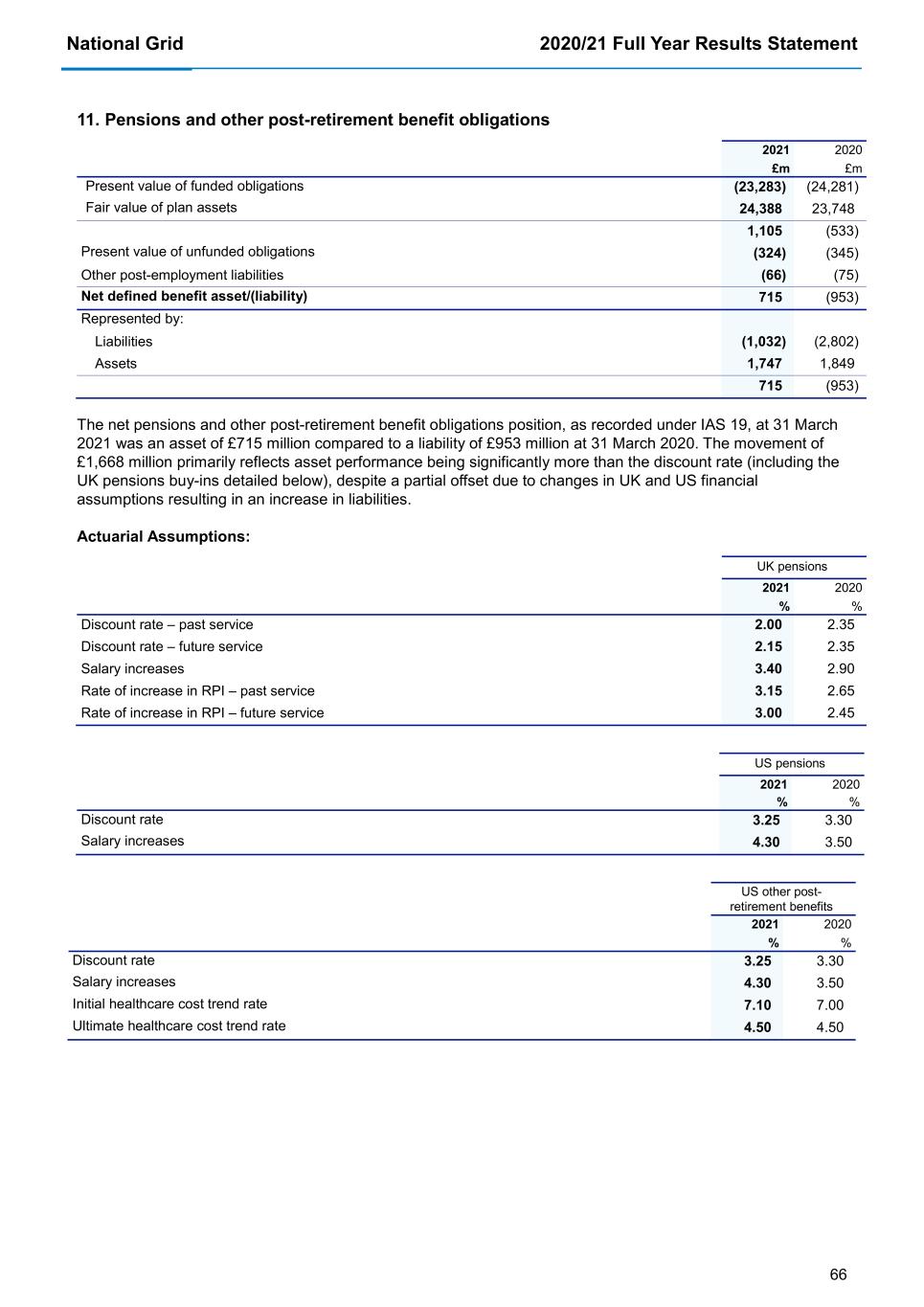
National Grid 2020/21 Full Year Results Statement 66 11. Pensions and other post-retirement benefit obligations 2021 2020 £m £m Present value of funded obligations (23,283) (24,281) Fair value of plan assets 24,388 23,748 1,105 (533) Present value of unfunded obligations (324) (345) Other post-employment liabilities (66) (75) Net defined benefit asset/(liability) 715 (953) Represented by: Liabilities (1,032) (2,802) Assets 1,747 1,849 715 (953) The net pensions and other post-retirement benefit obligations position, as recorded under IAS 19, at 31 March 2021 was an asset of £715 million compared to a liability of £953 million at 31 March 2020. The movement of £1,668 million primarily reflects asset performance being significantly more than the discount rate (including the UK pensions buy-ins detailed below), despite a partial offset due to changes in UK and US financial assumptions resulting in an increase in liabilities. Actuarial Assumptions: UK pensions 2021 2020 % % Discount rate – past service 2.00 2.35 Discount rate – future service 2.15 2.35 Salary increases 3.40 2.90 Rate of increase in RPI – past service 3.15 2.65 Rate of increase in RPI – future service 3.00 2.45 US pensions 2021 2020 % % Discount rate 3.25 3.30 Salary increases 4.30 3.50 US other post- retirement benefits 2021 2020 % % Discount rate 3.25 3.30 Salary increases 4.30 3.50 Initial healthcare cost trend rate 7.10 7.00 Ultimate healthcare cost trend rate 4.50 4.50
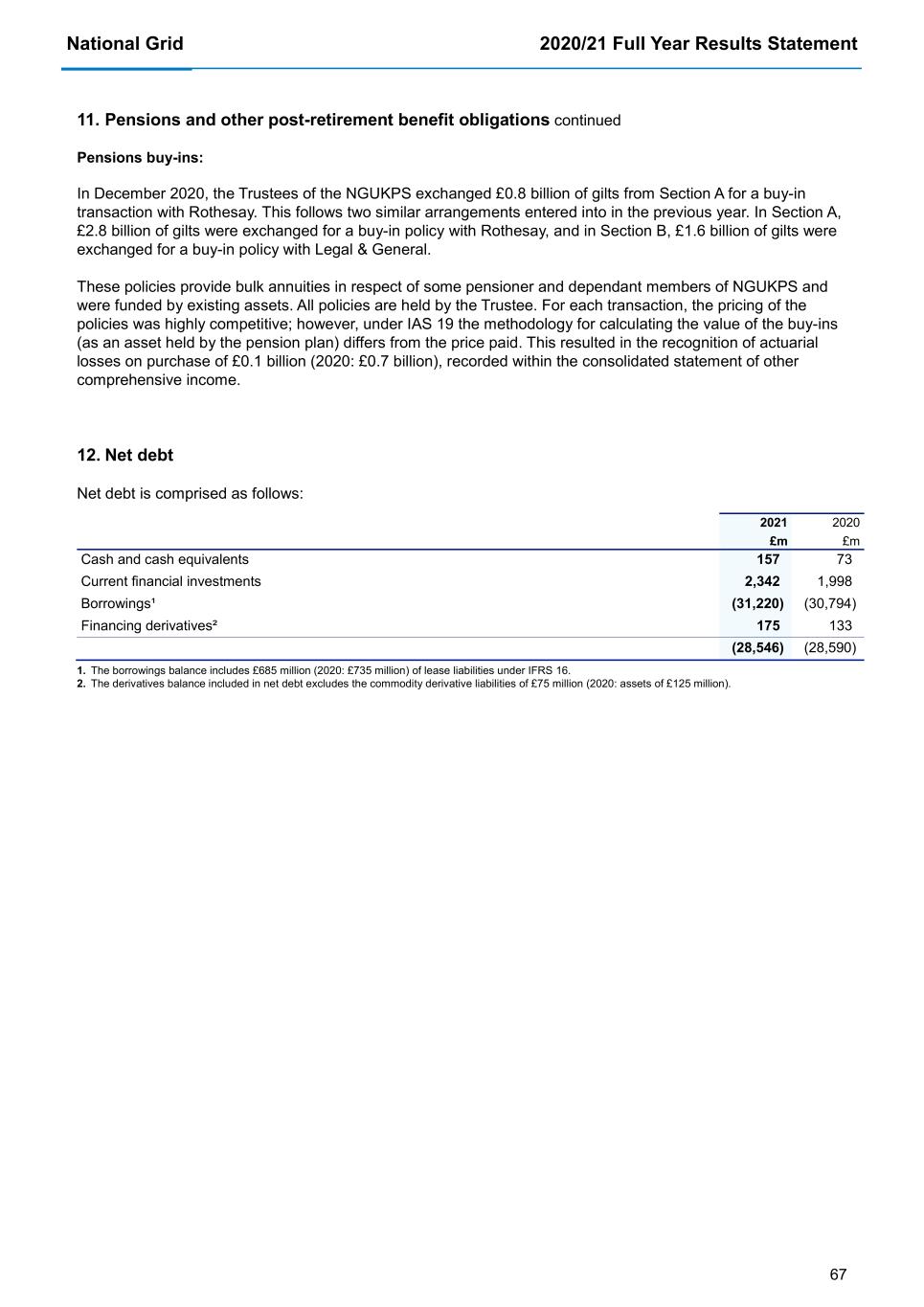
National Grid 2020/21 Full Year Results Statement 67 11. Pensions and other post-retirement benefit obligations continued Pensions buy-ins: In December 2020, the Trustees of the NGUKPS exchanged £0.8 billion of gilts from Section A for a buy-in transaction with Rothesay. This follows two similar arrangements entered into in the previous year. In Section A, £2.8 billion of gilts were exchanged for a buy-in policy with Rothesay, and in Section B, £1.6 billion of gilts were exchanged for a buy-in policy with Legal & General. These policies provide bulk annuities in respect of some pensioner and dependant members of NGUKPS and were funded by existing assets. All policies are held by the Trustee. For each transaction, the pricing of the policies was highly competitive; however, under IAS 19 the methodology for calculating the value of the buy-ins (as an asset held by the pension plan) differs from the price paid. This resulted in the recognition of actuarial losses on purchase of £0.1 billion (2020: £0.7 billion), recorded within the consolidated statement of other comprehensive income. 12. Net debt Net debt is comprised as follows: 2021 2020 £m £m Cash and cash equivalents 157 73 Current financial investments 2,342 1,998 Borrowings¹ (31,220) (30,794) Financing derivatives² 175 133 (28,546) (28,590) 1. The borrowings balance includes £685 million (2020: £735 million) of lease liabilities under IFRS 16. 2. The derivatives balance included in net debt excludes the commodity derivative liabilities of £75 million (2020: assets of £125 million).

National Grid 2020/21 Full Year Results Statement 68 13. Reconciliation of net cash flow to movement in net debt 2021 2020 £m £m Increase/(decrease) in cash and cash equivalents 95 (183) Increase/(decrease) in financial investments¹ 429 (42) (Increase)/decrease in borrowings (2,336) 450 Increase in related derivatives² 4 450 Change in debt resulting from cash flows (1,808) 675 Changes in fair value of financial assets and liabilities and exchange movements 1,801 (1,081) Net interest charge on the components of net debt (932) (1,097) Other non-cash movements (136) (84) Movement in net debt (net of related derivative financial instruments) in the year (1,075) (1,587) Net debt (net of related derivative financial instruments) at start of year (28,590) (26,529) Reclassification to held for sale 1,119 — Impact of transition to new accounting standards (2020: IFRS 16) — (474) Net debt (net of related derivative financial instruments) at end of year (28,546) (28,590) 1. Cash flows on current financial investments are comprised of £7 million (2020: £35 million) of interest received and £436 million of cash inflows (2020: £7 million outflows) of net cash flow movements in short-term financial investments, as presented in the consolidated cash flow statement. 2. The derivatives balance included in net debt excludes the commodity derivative assets of £75 million (2020: assets of £125 million). 2021 2020 Borrowings and other £m Financing derivatives £m Borrowings and other £m Financing derivatives £m Cash flows per financing activities section of cash flow statement: Proceeds received from loans 5,645 — 4,218 — Repayment of loans (1,663) — (3,253) — Payments of lease liabilities (112) — (121) — Net movements in short-term borrowings (759) — (424) — Cash inflows on derivatives — 58 — 62 Cash outflows on derivatives — (185) — (249) Interest paid (804) (31) (904) (53) Cash flows per financing activities section of cash flow statement 2,307 (158) (484) (240) Adjustments: Non-net debt-related items 29 — 34 — Derivative cash inflow in relation to capital expenditure — 10 — 13 Derivative cash inflows per investing section of cash flow statement — 225 — 58 Derivative cash outflows per investing section of cash flow statement — (81) — (281) Cash flows relating to financing liabilities within net debt 2,336 (4) (450) (450) Analysis of changes in net debt: Borrowings 2,336 — (450) — Financing derivatives — (4) — (450) Cash flow movements relating to financing liabilities within net debt 2,336 (4) (450) (450) 14. Acquisitions Acquisition of PPL Western Power Distribution Investments Limited On 17 March 2021, National Grid plc entered into an agreement to acquire 100% of the share capital of PPL WPD Investments Limited (WPD), the holding company of Western Power Distribution plc, which is the UK’s largest electricity distribution network operator. The total consideration for the transaction is £7.8 billion. The transaction is expected to complete in July 2021.
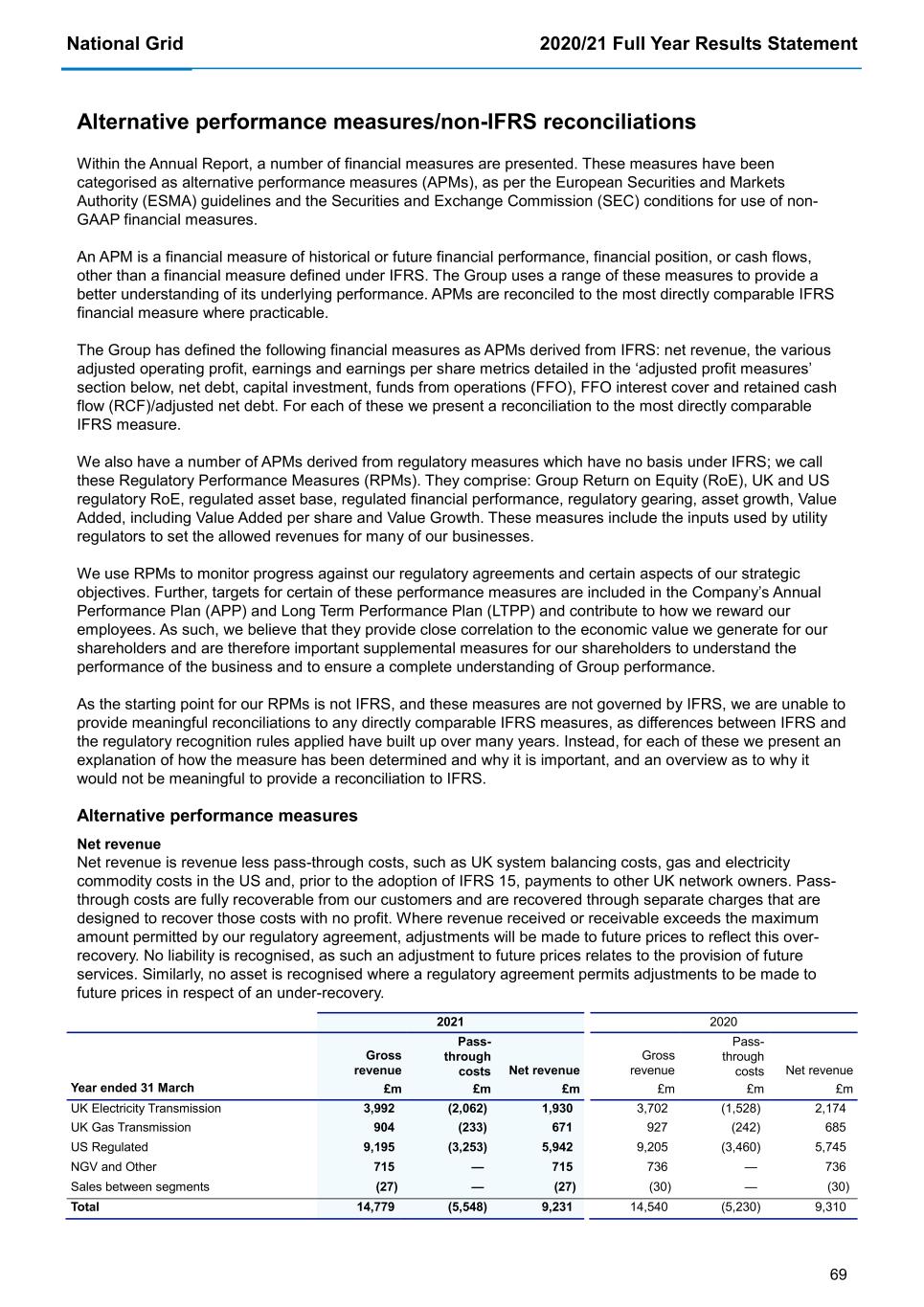
National Grid 2020/21 Full Year Results Statement 69 Alternative performance measures/non-IFRS reconciliations Within the Annual Report, a number of financial measures are presented. These measures have been categorised as alternative performance measures (APMs), as per the European Securities and Markets Authority (ESMA) guidelines and the Securities and Exchange Commission (SEC) conditions for use of non- GAAP financial measures. An APM is a financial measure of historical or future financial performance, financial position, or cash flows, other than a financial measure defined under IFRS. The Group uses a range of these measures to provide a better understanding of its underlying performance. APMs are reconciled to the most directly comparable IFRS financial measure where practicable. The Group has defined the following financial measures as APMs derived from IFRS: net revenue, the various adjusted operating profit, earnings and earnings per share metrics detailed in the ‘adjusted profit measures’ section below, net debt, capital investment, funds from operations (FFO), FFO interest cover and retained cash flow (RCF)/adjusted net debt. For each of these we present a reconciliation to the most directly comparable IFRS measure. We also have a number of APMs derived from regulatory measures which have no basis under IFRS; we call these Regulatory Performance Measures (RPMs). They comprise: Group Return on Equity (RoE), UK and US regulatory RoE, regulated asset base, regulated financial performance, regulatory gearing, asset growth, Value Added, including Value Added per share and Value Growth. These measures include the inputs used by utility regulators to set the allowed revenues for many of our businesses. We use RPMs to monitor progress against our regulatory agreements and certain aspects of our strategic objectives. Further, targets for certain of these performance measures are included in the Company’s Annual Performance Plan (APP) and Long Term Performance Plan (LTPP) and contribute to how we reward our employees. As such, we believe that they provide close correlation to the economic value we generate for our shareholders and are therefore important supplemental measures for our shareholders to understand the performance of the business and to ensure a complete understanding of Group performance. As the starting point for our RPMs is not IFRS, and these measures are not governed by IFRS, we are unable to provide meaningful reconciliations to any directly comparable IFRS measures, as differences between IFRS and the regulatory recognition rules applied have built up over many years. Instead, for each of these we present an explanation of how the measure has been determined and why it is important, and an overview as to why it would not be meaningful to provide a reconciliation to IFRS. Alternative performance measures Net revenue Net revenue is revenue less pass-through costs, such as UK system balancing costs, gas and electricity commodity costs in the US and, prior to the adoption of IFRS 15, payments to other UK network owners. Pass- through costs are fully recoverable from our customers and are recovered through separate charges that are designed to recover those costs with no profit. Where revenue received or receivable exceeds the maximum amount permitted by our regulatory agreement, adjustments will be made to future prices to reflect this over- recovery. No liability is recognised, as such an adjustment to future prices relates to the provision of future services. Similarly, no asset is recognised where a regulatory agreement permits adjustments to be made to future prices in respect of an under-recovery. 2021 2020 Year ended 31 March Gross revenue Pass- through costs Net revenue Gross revenue Pass- through costs Net revenue £m £m £m £m £m £m UK Electricity Transmission 3,992 (2,062) 1,930 3,702 (1,528) 2,174 UK Gas Transmission 904 (233) 671 927 (242) 685 US Regulated 9,195 (3,253) 5,942 9,205 (3,460) 5,745 NGV and Other 715 — 715 736 — 736 Sales between segments (27) — (27) (30) — (30) Total 14,779 (5,548) 9,231 14,540 (5,230) 9,310
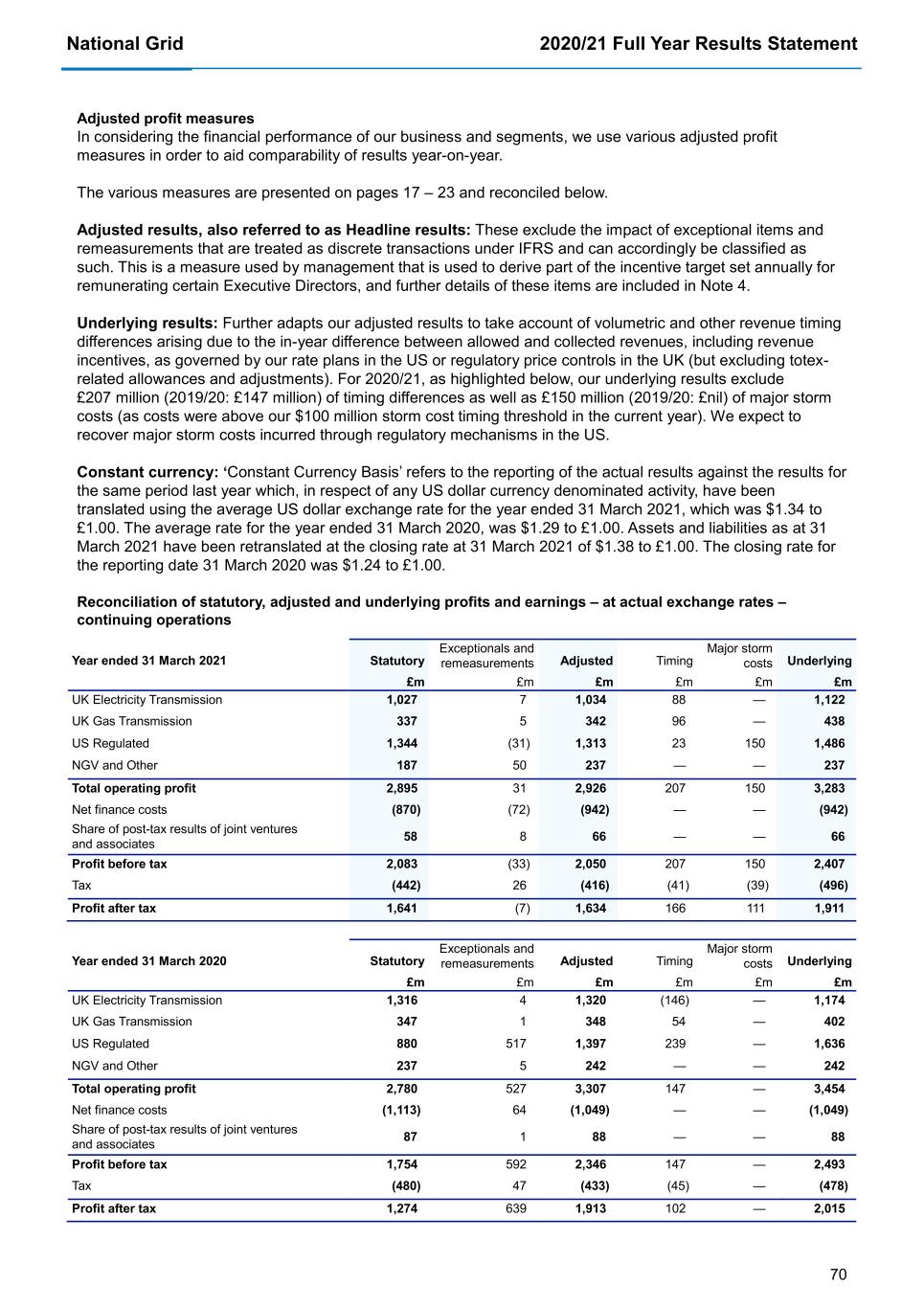
National Grid 2020/21 Full Year Results Statement 70 Adjusted profit measures In considering the financial performance of our business and segments, we use various adjusted profit measures in order to aid comparability of results year-on-year. The various measures are presented on pages 17 – 23 and reconciled below. Adjusted results, also referred to as Headline results: These exclude the impact of exceptional items and remeasurements that are treated as discrete transactions under IFRS and can accordingly be classified as such. This is a measure used by management that is used to derive part of the incentive target set annually for remunerating certain Executive Directors, and further details of these items are included in Note 4. Underlying results: Further adapts our adjusted results to take account of volumetric and other revenue timing differences arising due to the in-year difference between allowed and collected revenues, including revenue incentives, as governed by our rate plans in the US or regulatory price controls in the UK (but excluding totex- related allowances and adjustments). For 2020/21, as highlighted below, our underlying results exclude £207 million (2019/20: £147 million) of timing differences as well as £150 million (2019/20: £nil) of major storm costs (as costs were above our $100 million storm cost timing threshold in the current year). We expect to recover major storm costs incurred through regulatory mechanisms in the US. Constant currency: ‘Constant Currency Basis’ refers to the reporting of the actual results against the results for the same period last year which, in respect of any US dollar currency denominated activity, have been translated using the average US dollar exchange rate for the year ended 31 March 2021, which was $1.34 to £1.00. The average rate for the year ended 31 March 2020, was $1.29 to £1.00. Assets and liabilities as at 31 March 2021 have been retranslated at the closing rate at 31 March 2021 of $1.38 to £1.00. The closing rate for the reporting date 31 March 2020 was $1.24 to £1.00. Reconciliation of statutory, adjusted and underlying profits and earnings – at actual exchange rates – continuing operations Year ended 31 March 2021 Statutory Exceptionals and remeasurements Adjusted Timing Major storm costs Underlying £m £m £m £m £m £m UK Electricity Transmission 1,027 7 1,034 88 — 1,122 UK Gas Transmission 337 5 342 96 — 438 US Regulated 1,344 (31) 1,313 23 150 1,486 NGV and Other 187 50 237 — — 237 Total operating profit 2,895 31 2,926 207 150 3,283 Net finance costs (870) (72) (942) — — (942) Share of post-tax results of joint ventures and associates 58 8 66 — — 66 Profit before tax 2,083 (33) 2,050 207 150 2,407 Tax (442) 26 (416) (41) (39) (496) Profit after tax 1,641 (7) 1,634 166 111 1,911 Year ended 31 March 2020 Statutory Exceptionals and remeasurements Adjusted Timing Major storm costs Underlying £m £m £m £m £m £m UK Electricity Transmission 1,316 4 1,320 (146) — 1,174 UK Gas Transmission 347 1 348 54 — 402 US Regulated 880 517 1,397 239 — 1,636 NGV and Other 237 5 242 — — 242 Total operating profit 2,780 527 3,307 147 — 3,454 Net finance costs (1,113) 64 (1,049) — — (1,049) Share of post-tax results of joint ventures and associates 87 1 88 — — 88 Profit before tax 1,754 592 2,346 147 — 2,493 Tax (480) 47 (433) (45) — (478) Profit after tax 1,274 639 1,913 102 — 2,015
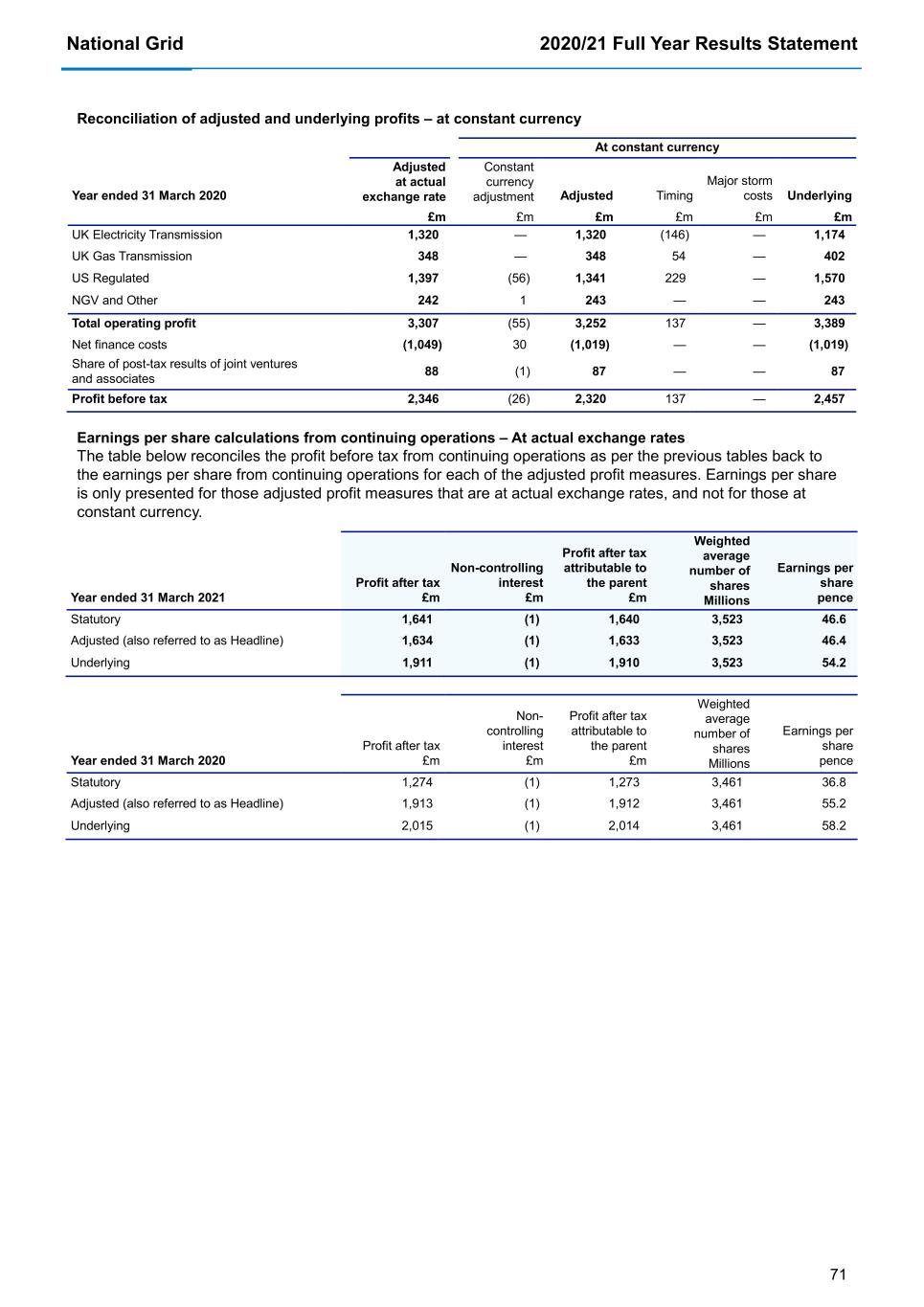
National Grid 2020/21 Full Year Results Statement 71 Reconciliation of adjusted and underlying profits – at constant currency At constant currency Year ended 31 March 2020 Adjusted at actual exchange rate Constant currency adjustment Adjusted Timing Major storm costs Underlying £m £m £m £m £m £m UK Electricity Transmission 1,320 — 1,320 (146) — 1,174 UK Gas Transmission 348 — 348 54 — 402 US Regulated 1,397 (56) 1,341 229 — 1,570 NGV and Other 242 1 243 — — 243 Total operating profit 3,307 (55) 3,252 137 — 3,389 Net finance costs (1,049) 30 (1,019) — — (1,019) Share of post-tax results of joint ventures and associates 88 (1) 87 — — 87 Profit before tax 2,346 (26) 2,320 137 — 2,457 Earnings per share calculations from continuing operations – At actual exchange rates The table below reconciles the profit before tax from continuing operations as per the previous tables back to the earnings per share from continuing operations for each of the adjusted profit measures. Earnings per share is only presented for those adjusted profit measures that are at actual exchange rates, and not for those at constant currency. Year ended 31 March 2021 Profit after tax £m Non-controlling interest £m Profit after tax attributable to the parent £m Weighted average number of shares Millions Earnings per share pence Statutory 1,641 (1) 1,640 3,523 46.6 Adjusted (also referred to as Headline) 1,634 (1) 1,633 3,523 46.4 Underlying 1,911 (1) 1,910 3,523 54.2 Year ended 31 March 2020 Profit after tax £m Non- controlling interest £m Profit after tax attributable to the parent £m Weighted average number of shares Millions Earnings per share pence Statutory 1,274 (1) 1,273 3,461 36.8 Adjusted (also referred to as Headline) 1,913 (1) 1,912 3,461 55.2 Underlying 2,015 (1) 2,014 3,461 58.2
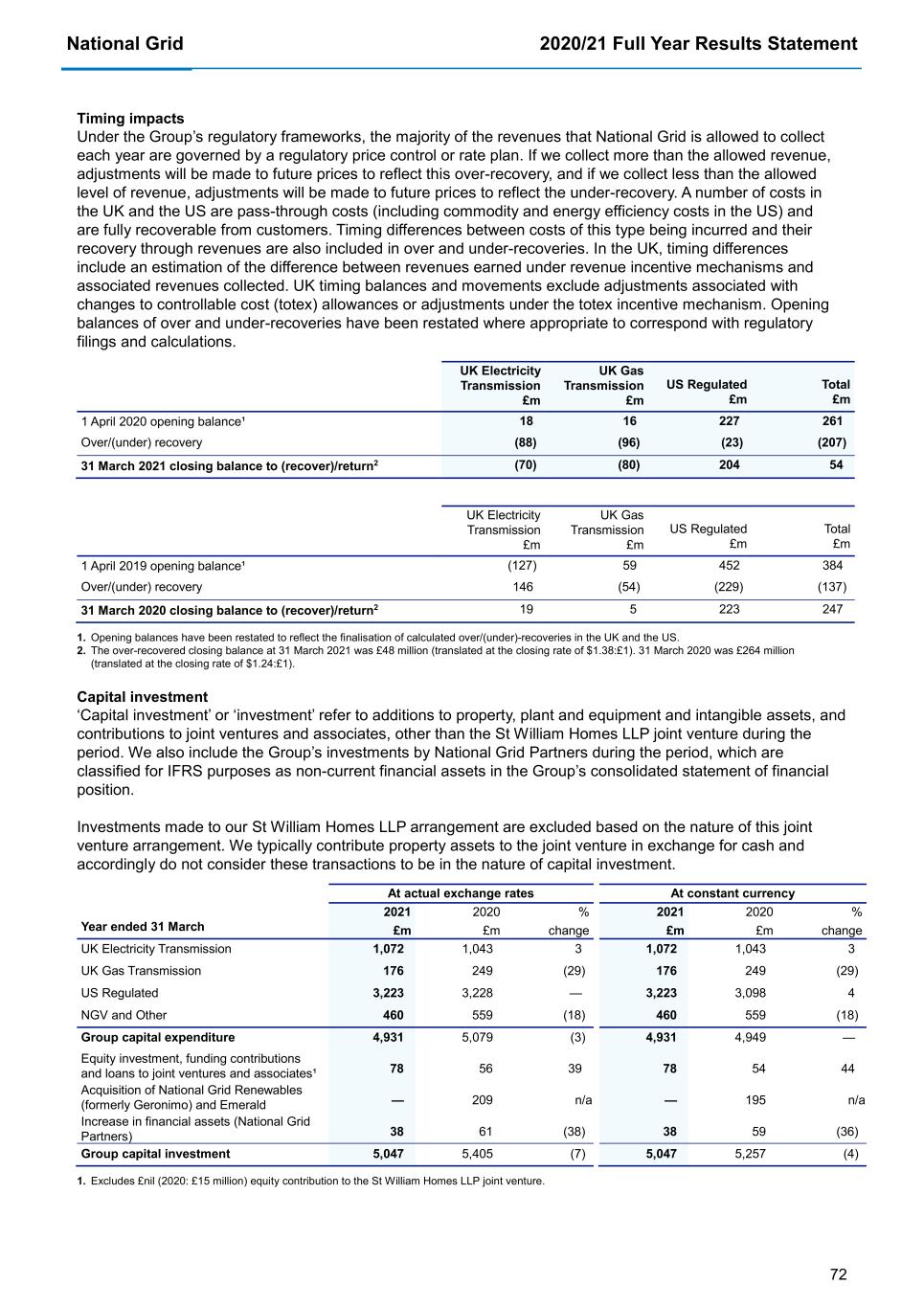
National Grid 2020/21 Full Year Results Statement 72 Timing impacts Under the Group’s regulatory frameworks, the majority of the revenues that National Grid is allowed to collect each year are governed by a regulatory price control or rate plan. If we collect more than the allowed revenue, adjustments will be made to future prices to reflect this over-recovery, and if we collect less than the allowed level of revenue, adjustments will be made to future prices to reflect the under-recovery. A number of costs in the UK and the US are pass-through costs (including commodity and energy efficiency costs in the US) and are fully recoverable from customers. Timing differences between costs of this type being incurred and their recovery through revenues are also included in over and under-recoveries. In the UK, timing differences include an estimation of the difference between revenues earned under revenue incentive mechanisms and associated revenues collected. UK timing balances and movements exclude adjustments associated with changes to controllable cost (totex) allowances or adjustments under the totex incentive mechanism. Opening balances of over and under-recoveries have been restated where appropriate to correspond with regulatory filings and calculations. UK Electricity Transmission £m UK Gas Transmission £m US Regulated £m Total £m 1 April 2020 opening balance¹ 18 16 227 261 Over/(under) recovery (88) (96) (23) (207) 31 March 2021 closing balance to (recover)/return2 (70) (80) 204 54 UK Electricity Transmission £m UK Gas Transmission £m US Regulated £m Total £m 1 April 2019 opening balance¹ (127) 59 452 384 Over/(under) recovery 146 (54) (229) (137) 31 March 2020 closing balance to (recover)/return2 19 5 223 247 1. Opening balances have been restated to reflect the finalisation of calculated over/(under)-recoveries in the UK and the US. 2. The over-recovered closing balance at 31 March 2021 was £48 million (translated at the closing rate of $1.38:£1). 31 March 2020 was £264 million (translated at the closing rate of $1.24:£1). Capital investment ‘Capital investment’ or ‘investment’ refer to additions to property, plant and equipment and intangible assets, and contributions to joint ventures and associates, other than the St William Homes LLP joint venture during the period. We also include the Group’s investments by National Grid Partners during the period, which are classified for IFRS purposes as non-current financial assets in the Group’s consolidated statement of financial position. Investments made to our St William Homes LLP arrangement are excluded based on the nature of this joint venture arrangement. We typically contribute property assets to the joint venture in exchange for cash and accordingly do not consider these transactions to be in the nature of capital investment. At actual exchange rates At constant currency Year ended 31 March 2021 2020 % 2021 2020 % £m £m change £m £m change UK Electricity Transmission 1,072 1,043 3 1,072 1,043 3 UK Gas Transmission 176 249 (29) 176 249 (29) US Regulated 3,223 3,228 — 3,223 3,098 4 NGV and Other 460 559 (18) 460 559 (18) Group capital expenditure 4,931 5,079 (3) 4,931 4,949 — Equity investment, funding contributions and loans to joint ventures and associates¹ 78 56 39 78 54 44 Acquisition of National Grid Renewables (formerly Geronimo) and Emerald — 209 n/a — 195 n/a Increase in financial assets (National Grid Partners) 38 61 (38) 38 59 (36) Group capital investment 5,047 5,405 (7) 5,047 5,257 (4) 1. Excludes £nil (2020: £15 million) equity contribution to the St William Homes LLP joint venture.
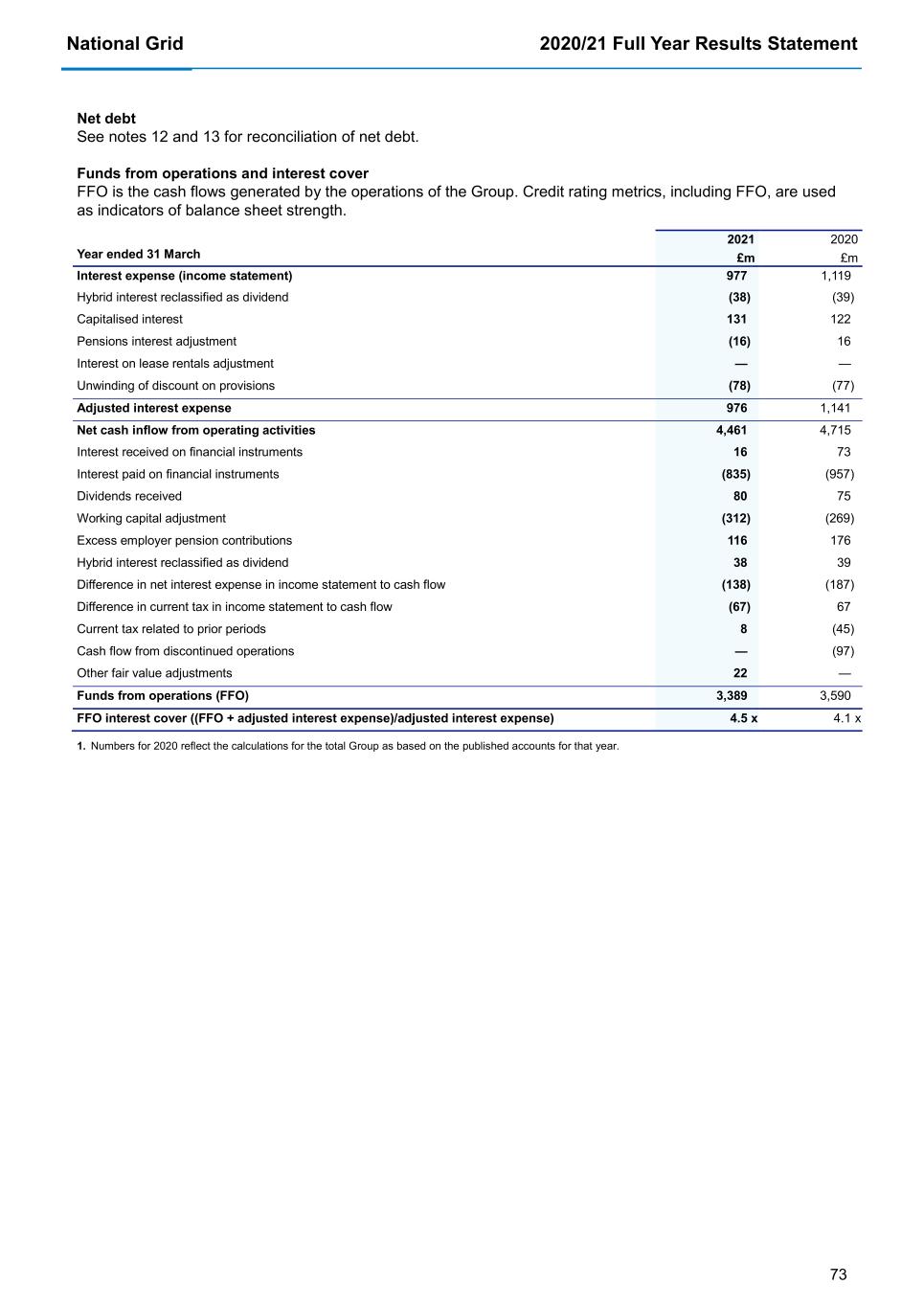
National Grid 2020/21 Full Year Results Statement 73 Net debt See notes 12 and 13 for reconciliation of net debt. Funds from operations and interest cover FFO is the cash flows generated by the operations of the Group. Credit rating metrics, including FFO, are used as indicators of balance sheet strength. Year ended 31 March 2021 2020 £m £m Interest expense (income statement) 977 1,119 Hybrid interest reclassified as dividend (38) (39) Capitalised interest 131 122 Pensions interest adjustment (16) 16 Interest on lease rentals adjustment — — Unwinding of discount on provisions (78) (77) Adjusted interest expense 976 1,141 Net cash inflow from operating activities 4,461 4,715 Interest received on financial instruments 16 73 Interest paid on financial instruments (835) (957) Dividends received 80 75 Working capital adjustment (312) (269) Excess employer pension contributions 116 176 Hybrid interest reclassified as dividend 38 39 Difference in net interest expense in income statement to cash flow (138) (187) Difference in current tax in income statement to cash flow (67) 67 Current tax related to prior periods 8 (45) Cash flow from discontinued operations — (97) Other fair value adjustments 22 — Funds from operations (FFO) 3,389 3,590 FFO interest cover ((FFO + adjusted interest expense)/adjusted interest expense) 4.5 x 4.1 x 1. Numbers for 2020 reflect the calculations for the total Group as based on the published accounts for that year.
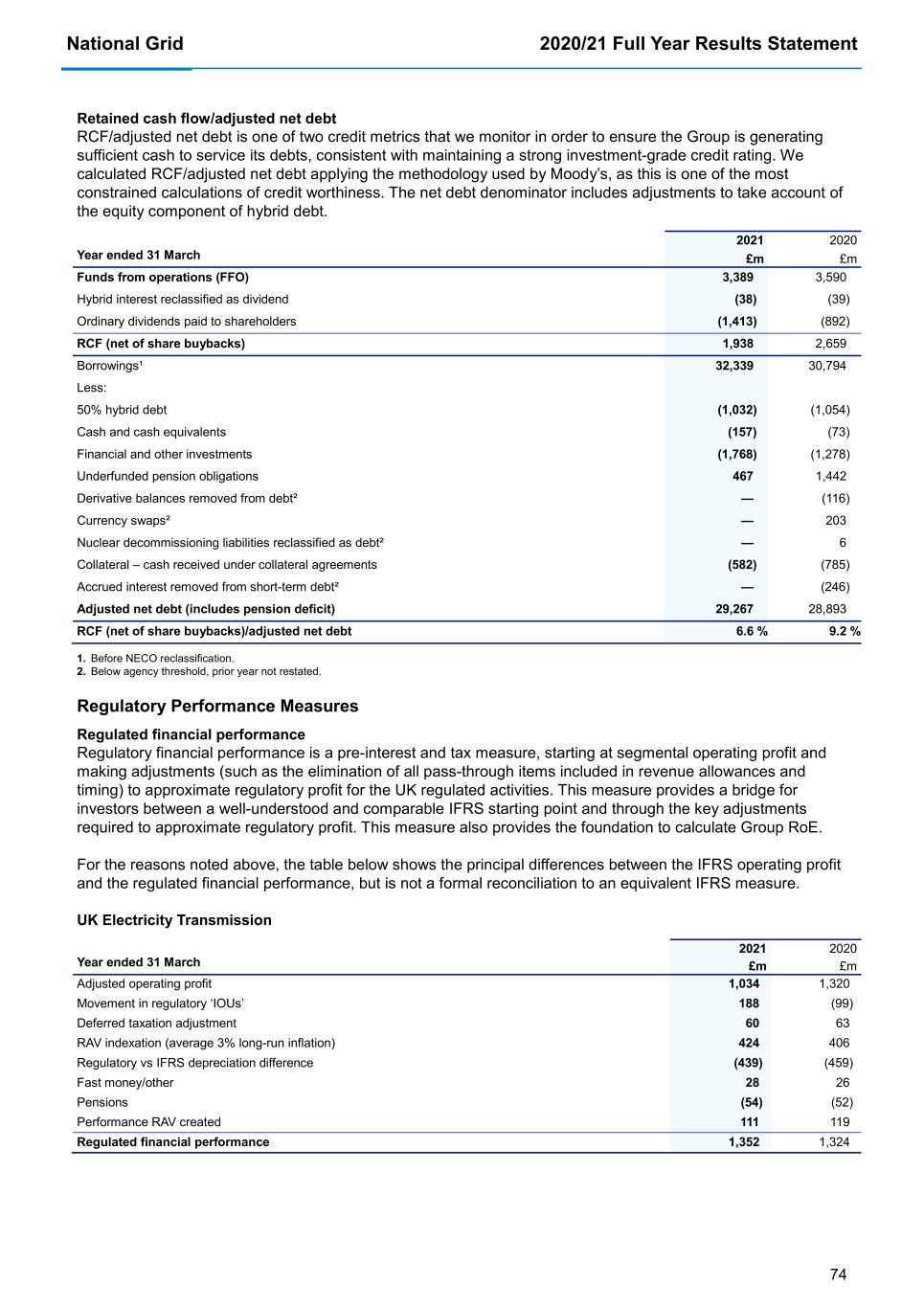
National Grid 2020/21 Full Year Results Statement 74 Retained cash flow/adjusted net debt RCF/adjusted net debt is one of two credit metrics that we monitor in order to ensure the Group is generating sufficient cash to service its debts, consistent with maintaining a strong investment-grade credit rating. We calculated RCF/adjusted net debt applying the methodology used by Moody’s, as this is one of the most constrained calculations of credit worthiness. The net debt denominator includes adjustments to take account of the equity component of hybrid debt. Year ended 31 March 2021 2020 £m £m Funds from operations (FFO) 3,389 3,590 Hybrid interest reclassified as dividend (38) (39) Ordinary dividends paid to shareholders (1,413) (892) RCF (net of share buybacks) 1,938 2,659 Borrowings¹ 32,339 30,794 Less: 50% hybrid debt (1,032) (1,054) Cash and cash equivalents (157) (73) Financial and other investments (1,768) (1,278) Underfunded pension obligations 467 1,442 Derivative balances removed from debt² — (116) Currency swaps² — 203 Nuclear decommissioning liabilities reclassified as debt² — 6 Collateral – cash received under collateral agreements (582) (785) Accrued interest removed from short-term debt² — (246) Adjusted net debt (includes pension deficit) 29,267 28,893 RCF (net of share buybacks)/adjusted net debt 6.6 % 9.2 % 1. Before NECO reclassification. 2. Below agency threshold, prior year not restated. Regulatory Performance Measures Regulated financial performance Regulatory financial performance is a pre-interest and tax measure, starting at segmental operating profit and making adjustments (such as the elimination of all pass-through items included in revenue allowances and timing) to approximate regulatory profit for the UK regulated activities. This measure provides a bridge for investors between a well-understood and comparable IFRS starting point and through the key adjustments required to approximate regulatory profit. This measure also provides the foundation to calculate Group RoE. For the reasons noted above, the table below shows the principal differences between the IFRS operating profit and the regulated financial performance, but is not a formal reconciliation to an equivalent IFRS measure. UK Electricity Transmission Year ended 31 March 2021 2020 £m £m Adjusted operating profit 1,034 1,320 Movement in regulatory ‘IOUs’ 188 (99) Deferred taxation adjustment 60 63 RAV indexation (average 3% long-run inflation) 424 406 Regulatory vs IFRS depreciation difference (439) (459) Fast money/other 28 26 Pensions (54) (52) Performance RAV created 111 119 Regulated financial performance 1,352 1,324

National Grid 2020/21 Full Year Results Statement 75 UK Gas Transmission Year ended 31 March 2021 2020 £m £m Adjusted operating profit 342 348 Movement in regulatory ‘IOUs’ 34 67 Deferred taxation adjustment 12 25 RAV indexation (average 3% long-run inflation) 189 185 Regulatory vs IFRS depreciation difference (88) (77) Fast money/other 25 (17) Pensions (34) (34) Performance RAV created (23) (24) Regulated financial performance 457 473 US Regulated Year ended 31 March 2021 2020 £m £m Adjusted operating profit 1,313 1,397 Provision for bad and doubtful debts (COVID-19), net of recoveries¹ 120 117 Major storm costs 150 — Timing 23 239 US GAAP pension adjustment 3 (4) Regulated financial performance 1,609 1,749 1. US Regulated financial performance includes an adjustment reflecting our expectation for future recovery of COVID-19 related bad and doubtful debt expense. Total regulated financial performance Year ended 31 March 2021 2020 £m £m UK Electricity Transmission 1,352 1,324 UK Gas Transmission 457 473 US Regulated 1,609 1,749 Total regulated financial performance 3,418 3,546 US timing, major storms and movement in UK regulatory ‘IOUs’ – Revenue related to performance in one year may be recovered in later years. Where revenue received or receivable exceeds the maximum amount permitted by our regulatory agreement, adjustments will be made to future prices to reflect this over-recovery. No liability is recognised under IFRS, as such an adjustment to future prices relates to the provision of future services. Similarly, no asset is recognised under IFRS where a regulatory agreement permits adjustments to be made to future prices in respect of an under-recovery. In the UK, this is calculated as the movement in other regulated assets and liabilities. Performance RAV – UK performance efficiencies are in-part remunerated by the creation of additional RAV which is expected to result in future earnings under regulatory arrangements. This is calculated as in-year totex outperformance multiplied by the appropriate regulatory capitalisation ratio and multiplied by the retained company incentive sharing ratio. Pension adjustment – Cash payments against pension deficits in the UK are recoverable under regulatory contracts. In US Regulated operations, US GAAP pension charges are generally recoverable through rates. Revenue recoveries are recognised under IFRS but payments are not charged against IFRS operating profits in the year. In the UK, this is calculated as cash payments against the regulatory proportion of pension deficits in the UK regulated business, whereas in the US, it is the difference between IFRS and US GAAP pension charges. 3% RAV indexation – Future UK revenues are expected to be set using an asset base adjusted for inflation. This is calculated as UK RAV multiplied by 3% (long-run RPI inflation assumption).
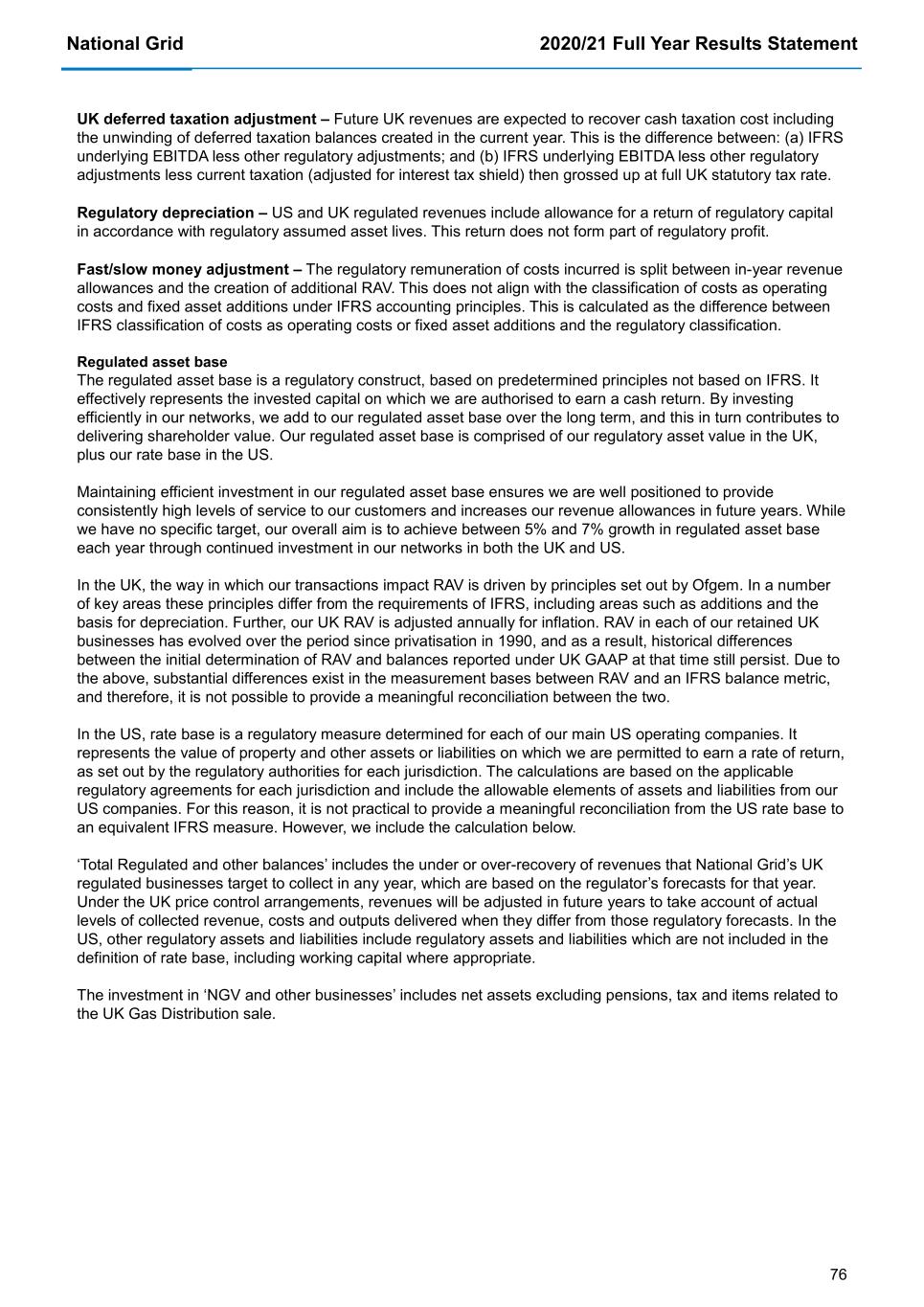
National Grid 2020/21 Full Year Results Statement 76 UK deferred taxation adjustment – Future UK revenues are expected to recover cash taxation cost including the unwinding of deferred taxation balances created in the current year. This is the difference between: (a) IFRS underlying EBITDA less other regulatory adjustments; and (b) IFRS underlying EBITDA less other regulatory adjustments less current taxation (adjusted for interest tax shield) then grossed up at full UK statutory tax rate. Regulatory depreciation – US and UK regulated revenues include allowance for a return of regulatory capital in accordance with regulatory assumed asset lives. This return does not form part of regulatory profit. Fast/slow money adjustment – The regulatory remuneration of costs incurred is split between in-year revenue allowances and the creation of additional RAV. This does not align with the classification of costs as operating costs and fixed asset additions under IFRS accounting principles. This is calculated as the difference between IFRS classification of costs as operating costs or fixed asset additions and the regulatory classification. Regulated asset base The regulated asset base is a regulatory construct, based on predetermined principles not based on IFRS. It effectively represents the invested capital on which we are authorised to earn a cash return. By investing efficiently in our networks, we add to our regulated asset base over the long term, and this in turn contributes to delivering shareholder value. Our regulated asset base is comprised of our regulatory asset value in the UK, plus our rate base in the US. Maintaining efficient investment in our regulated asset base ensures we are well positioned to provide consistently high levels of service to our customers and increases our revenue allowances in future years. While we have no specific target, our overall aim is to achieve between 5% and 7% growth in regulated asset base each year through continued investment in our networks in both the UK and US. In the UK, the way in which our transactions impact RAV is driven by principles set out by Ofgem. In a number of key areas these principles differ from the requirements of IFRS, including areas such as additions and the basis for depreciation. Further, our UK RAV is adjusted annually for inflation. RAV in each of our retained UK businesses has evolved over the period since privatisation in 1990, and as a result, historical differences between the initial determination of RAV and balances reported under UK GAAP at that time still persist. Due to the above, substantial differences exist in the measurement bases between RAV and an IFRS balance metric, and therefore, it is not possible to provide a meaningful reconciliation between the two. In the US, rate base is a regulatory measure determined for each of our main US operating companies. It represents the value of property and other assets or liabilities on which we are permitted to earn a rate of return, as set out by the regulatory authorities for each jurisdiction. The calculations are based on the applicable regulatory agreements for each jurisdiction and include the allowable elements of assets and liabilities from our US companies. For this reason, it is not practical to provide a meaningful reconciliation from the US rate base to an equivalent IFRS measure. However, we include the calculation below. ‘Total Regulated and other balances’ includes the under or over-recovery of revenues that National Grid’s UK regulated businesses target to collect in any year, which are based on the regulator’s forecasts for that year. Under the UK price control arrangements, revenues will be adjusted in future years to take account of actual levels of collected revenue, costs and outputs delivered when they differ from those regulatory forecasts. In the US, other regulatory assets and liabilities include regulatory assets and liabilities which are not included in the definition of rate base, including working capital where appropriate. The investment in ‘NGV and other businesses’ includes net assets excluding pensions, tax and items related to the UK Gas Distribution sale.
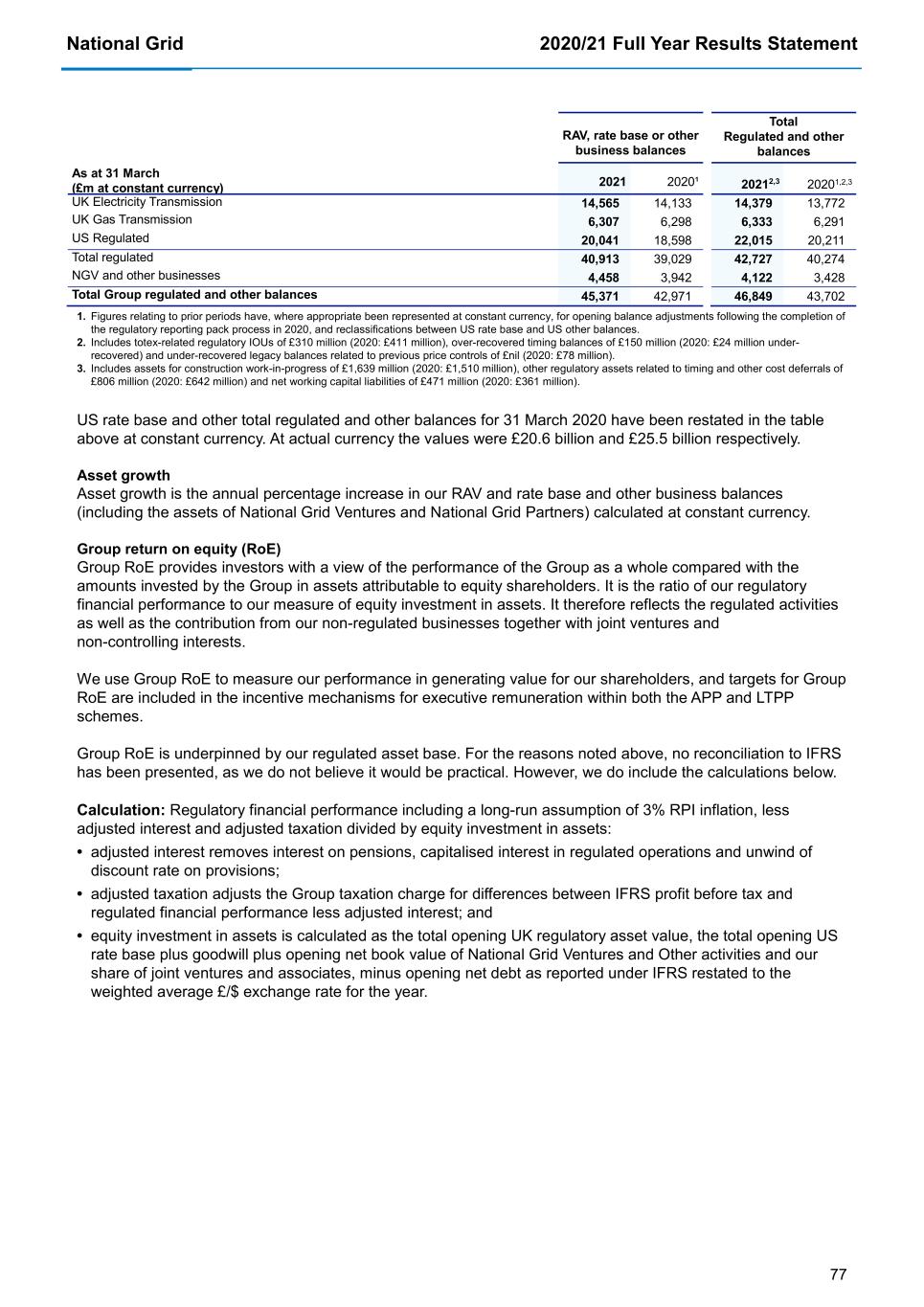
National Grid 2020/21 Full Year Results Statement 77 RAV, rate base or other business balances Total Regulated and other balances As at 31 March (£m at constant currency) 2021 2020¹ 20212,3 20201,2,3 UK Electricity Transmission 14,565 14,133 14,379 13,772 UK Gas Transmission 6,307 6,298 6,333 6,291 US Regulated 20,041 18,598 22,015 20,211 Total regulated 40,913 39,029 42,727 40,274 NGV and other businesses 4,458 3,942 4,122 3,428 Total Group regulated and other balances 45,371 42,971 46,849 43,702 1. Figures relating to prior periods have, where appropriate been represented at constant currency, for opening balance adjustments following the completion of the regulatory reporting pack process in 2020, and reclassifications between US rate base and US other balances. 2. Includes totex-related regulatory IOUs of £310 million (2020: £411 million), over-recovered timing balances of £150 million (2020: £24 million under- recovered) and under-recovered legacy balances related to previous price controls of £nil (2020: £78 million). 3. Includes assets for construction work-in-progress of £1,639 million (2020: £1,510 million), other regulatory assets related to timing and other cost deferrals of £806 million (2020: £642 million) and net working capital liabilities of £471 million (2020: £361 million). US rate base and other total regulated and other balances for 31 March 2020 have been restated in the table above at constant currency. At actual currency the values were £20.6 billion and £25.5 billion respectively. Asset growth Asset growth is the annual percentage increase in our RAV and rate base and other business balances (including the assets of National Grid Ventures and National Grid Partners) calculated at constant currency. Group return on equity (RoE) Group RoE provides investors with a view of the performance of the Group as a whole compared with the amounts invested by the Group in assets attributable to equity shareholders. It is the ratio of our regulatory financial performance to our measure of equity investment in assets. It therefore reflects the regulated activities as well as the contribution from our non-regulated businesses together with joint ventures and non-controlling interests. We use Group RoE to measure our performance in generating value for our shareholders, and targets for Group RoE are included in the incentive mechanisms for executive remuneration within both the APP and LTPP schemes. Group RoE is underpinned by our regulated asset base. For the reasons noted above, no reconciliation to IFRS has been presented, as we do not believe it would be practical. However, we do include the calculations below. Calculation: Regulatory financial performance including a long-run assumption of 3% RPI inflation, less adjusted interest and adjusted taxation divided by equity investment in assets: • adjusted interest removes interest on pensions, capitalised interest in regulated operations and unwind of discount rate on provisions; • adjusted taxation adjusts the Group taxation charge for differences between IFRS profit before tax and regulated financial performance less adjusted interest; and • equity investment in assets is calculated as the total opening UK regulatory asset value, the total opening US rate base plus goodwill plus opening net book value of National Grid Ventures and Other activities and our share of joint ventures and associates, minus opening net debt as reported under IFRS restated to the weighted average £/$ exchange rate for the year.

National Grid 2020/21 Full Year Results Statement 78 Years ended 31 March 2021 2020¹ £m £m Regulated financial performance 3,418 3,546 Operating profit of other activities 264 269 Group financial performance 3,682 3,815 Share of post-tax results of joint ventures and associates 66 88 Non-controlling interests (1) (1) Adjusted Group interest charge (882) (1,069) Group tax charge (416) (433) Tax on adjustments (175) (117) Group financial performance after interest and tax 2,274 2,283 Opening rate base/RAV 39,552 37,459 Opening other balances 3,984 3,304 Opening goodwill 5,295 5,435 Opening capital employed 48,831 46,198 Opening net debt (27,398) (27,194) Opening equity 21,433 19,004 Return on Equity 10.6 % 12.0 % 1. Group ROE in 2020 has been recalculated to reflect the revision to decrease the comparative goodwill balances (see note 1 for details). UK and US regulated RoE Years ended 31 March % Regulatory Debt:Equity assumption Achieved Return on Equity Base or Allowed Return on Equity 2020 % 2019 % 2020 % 2019 % UK Electricity Transmission 60/40 13.9 13.5 10.2 10.2 UK Gas Transmission 62.5/37.5 9.6 9.8 10.0 10.0 US Regulated Avg. 50/50 7.2 9.3 9.4 9.4 UK regulated RoE UK regulated RoEs are a measure of how the businesses are performing against the assumptions used by our UK regulator. These returns are calculated using the assumption that the businesses are financed in line with the regulatory adjudicated capital structure, at the cost of debt assumed by the regulator, and that RPI inflation is equal to a long-run assumption of 3%. They are calculated by dividing elements of out/under-performance versus the regulatory contract (i.e., regulated financial performance disclosed above) by the average equity RAV in line with the regulatory assumed capital structure and adding to the base allowed RoE. This is an important measure of UK regulated business performance, and our operational strategy continues to focus on this metric. This measure can be used to determine how we are performing under the RIIO framework and also helps investors to compare our performance with similarly regulated UK entities. Reflecting the importance of this metric, it is also a key component of the APP scheme. The UK RoE is underpinned by the UK RAV. For the reasons noted above, no reconciliation to IFRS has been presented, as we do not believe it would be practical. US regulated RoE US regulated RoE is a measure of how a business is performing against the assumptions used by the US regulators. This US operational return measure is calculated using the assumption that the businesses are financed in line with the regulatory adjudicated capital structure and allowed cost of debt. The returns are divided by the average rate base (or where a reported rate base is not available, an estimate based on rate base calculations used in previous rate filings) multiplied by the adjudicated equity portion in the regulatory adjudicated capital structure. This is an important measure of our US regulated business performance, and our operational strategy continues to focus on this metric. This measure can be used to determine how we are performing and also helps investors compare our performance with similarly regulated US entities. Reflecting the importance of this metric, it is also a key component of the APP scheme.
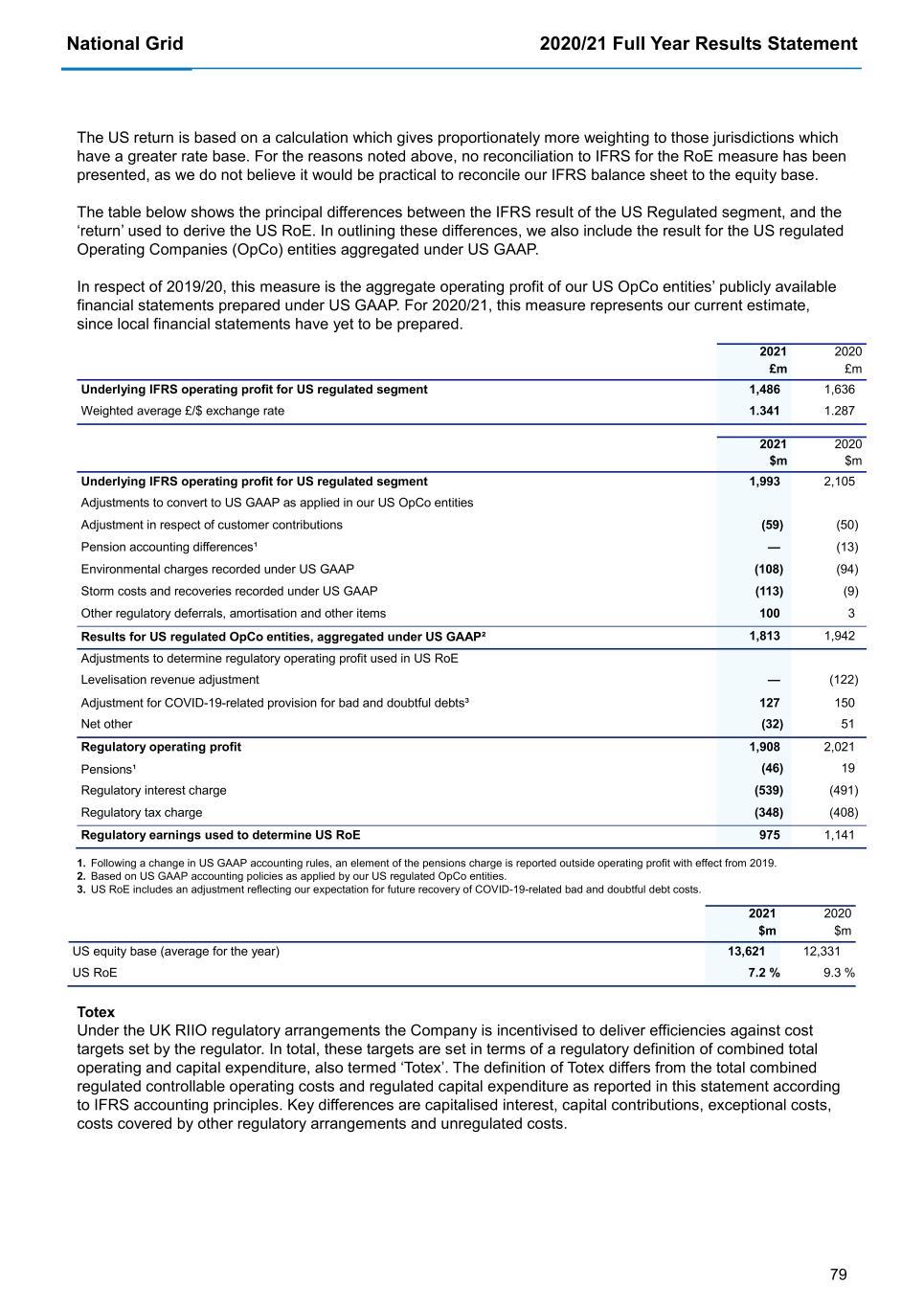
National Grid 2020/21 Full Year Results Statement 79 The US return is based on a calculation which gives proportionately more weighting to those jurisdictions which have a greater rate base. For the reasons noted above, no reconciliation to IFRS for the RoE measure has been presented, as we do not believe it would be practical to reconcile our IFRS balance sheet to the equity base. The table below shows the principal differences between the IFRS result of the US Regulated segment, and the ‘return’ used to derive the US RoE. In outlining these differences, we also include the result for the US regulated Operating Companies (OpCo) entities aggregated under US GAAP. In respect of 2019/20, this measure is the aggregate operating profit of our US OpCo entities’ publicly available financial statements prepared under US GAAP. For 2020/21, this measure represents our current estimate, since local financial statements have yet to be prepared. 2021 2020 £m £m Underlying IFRS operating profit for US regulated segment 1,486 1,636 Weighted average £/$ exchange rate 1.341 1.287 2021 2020 $m $m Underlying IFRS operating profit for US regulated segment 1,993 2,105 Adjustments to convert to US GAAP as applied in our US OpCo entities Adjustment in respect of customer contributions (59) (50) Pension accounting differences¹ — (13) Environmental charges recorded under US GAAP (108) (94) Storm costs and recoveries recorded under US GAAP (113) (9) Other regulatory deferrals, amortisation and other items 100 3 Results for US regulated OpCo entities, aggregated under US GAAP² 1,813 1,942 Adjustments to determine regulatory operating profit used in US RoE Levelisation revenue adjustment — (122) Adjustment for COVID-19-related provision for bad and doubtful debts³ 127 150 Net other (32) 51 Regulatory operating profit 1,908 2,021 Pensions¹ (46) 19 Regulatory interest charge (539) (491) Regulatory tax charge (348) (408) Regulatory earnings used to determine US RoE 975 1,141 1. Following a change in US GAAP accounting rules, an element of the pensions charge is reported outside operating profit with effect from 2019. 2. Based on US GAAP accounting policies as applied by our US regulated OpCo entities. 3. US RoE includes an adjustment reflecting our expectation for future recovery of COVID-19-related bad and doubtful debt costs. 2021 2020 $m $m US equity base (average for the year) 13,621 12,331 US RoE 7.2 % 9.3 % Totex Under the UK RIIO regulatory arrangements the Company is incentivised to deliver efficiencies against cost targets set by the regulator. In total, these targets are set in terms of a regulatory definition of combined total operating and capital expenditure, also termed ‘Totex’. The definition of Totex differs from the total combined regulated controllable operating costs and regulated capital expenditure as reported in this statement according to IFRS accounting principles. Key differences are capitalised interest, capital contributions, exceptional costs, costs covered by other regulatory arrangements and unregulated costs.
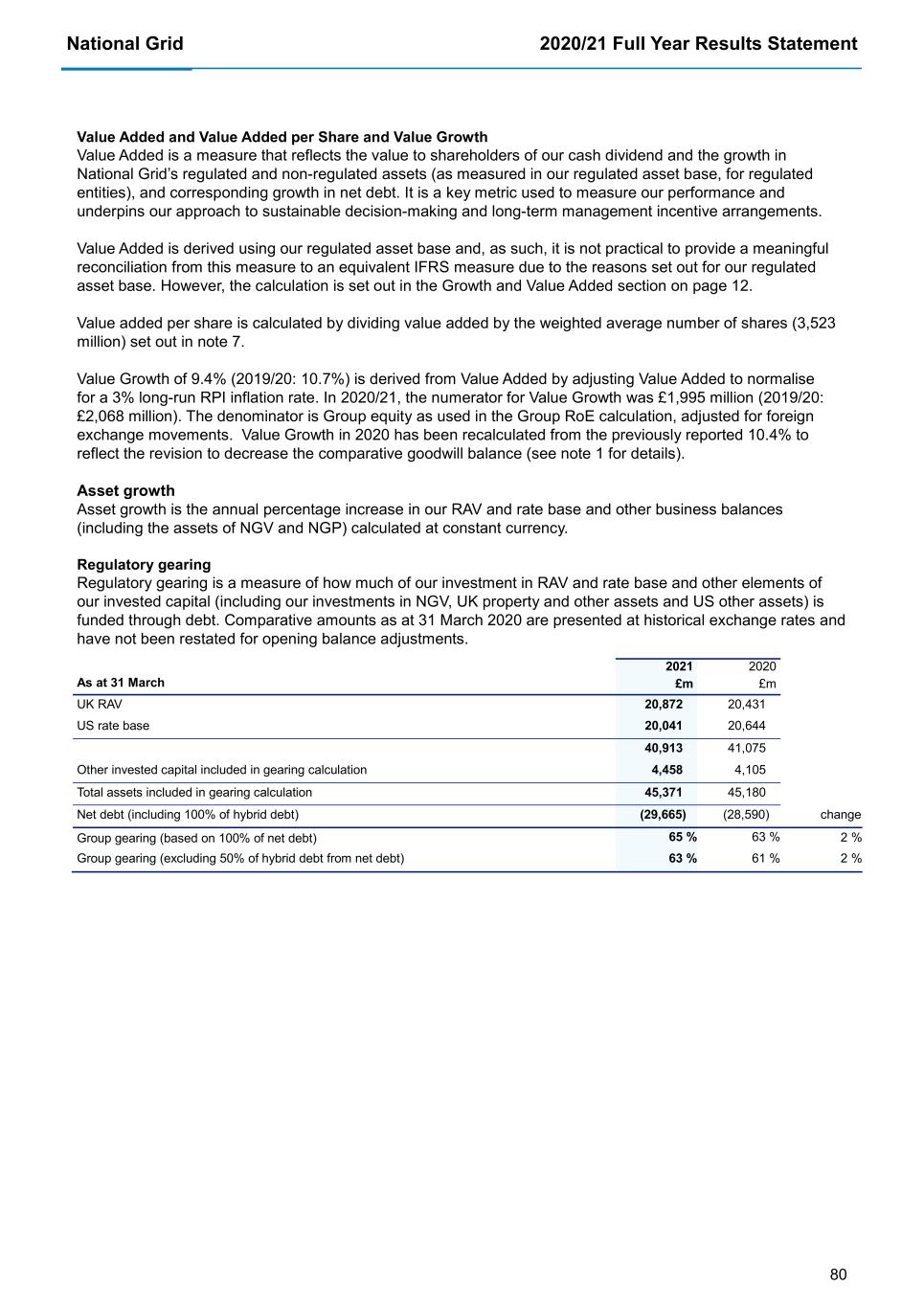
National Grid 2020/21 Full Year Results Statement 80 Value Added and Value Added per Share and Value Growth Value Added is a measure that reflects the value to shareholders of our cash dividend and the growth in National Grid’s regulated and non-regulated assets (as measured in our regulated asset base, for regulated entities), and corresponding growth in net debt. It is a key metric used to measure our performance and underpins our approach to sustainable decision-making and long-term management incentive arrangements. Value Added is derived using our regulated asset base and, as such, it is not practical to provide a meaningful reconciliation from this measure to an equivalent IFRS measure due to the reasons set out for our regulated asset base. However, the calculation is set out in the Growth and Value Added section on page 12. Value added per share is calculated by dividing value added by the weighted average number of shares (3,523 million) set out in note 7. Value Growth of 9.4% (2019/20: 10.7%) is derived from Value Added by adjusting Value Added to normalise for a 3% long-run RPI inflation rate. In 2020/21, the numerator for Value Growth was £1,995 million (2019/20: £2,068 million). The denominator is Group equity as used in the Group RoE calculation, adjusted for foreign exchange movements. Value Growth in 2020 has been recalculated from the previously reported 10.4% to reflect the revision to decrease the comparative goodwill balance (see note 1 for details). Asset growth Asset growth is the annual percentage increase in our RAV and rate base and other business balances (including the assets of NGV and NGP) calculated at constant currency. Regulatory gearing Regulatory gearing is a measure of how much of our investment in RAV and rate base and other elements of our invested capital (including our investments in NGV, UK property and other assets and US other assets) is funded through debt. Comparative amounts as at 31 March 2020 are presented at historical exchange rates and have not been restated for opening balance adjustments. As at 31 March 2021 2020 £m £m UK RAV 20,872 20,431 US rate base 20,041 20,644 40,913 41,075 Other invested capital included in gearing calculation 4,458 4,105 Total assets included in gearing calculation 45,371 45,180 Net debt (including 100% of hybrid debt) (29,665) (28,590) change Group gearing (based on 100% of net debt) 65 % 63 % 2 % Group gearing (excluding 50% of hybrid debt from net debt) 63 % 61 % 2 %















































































